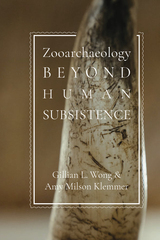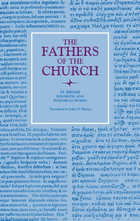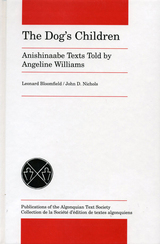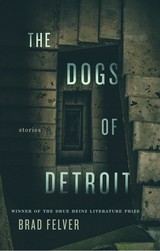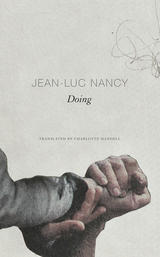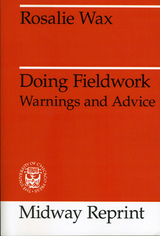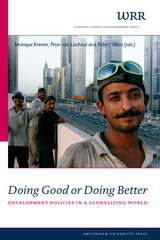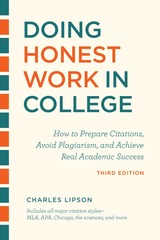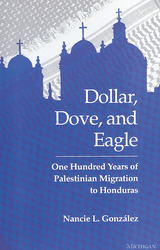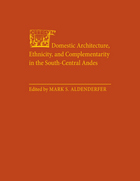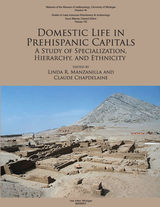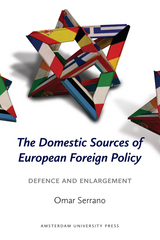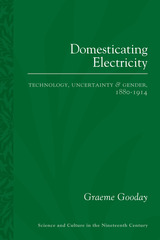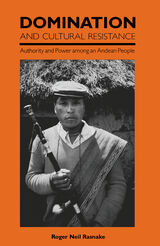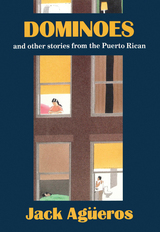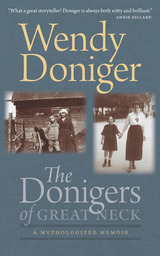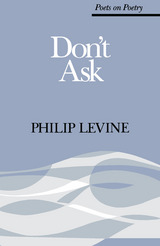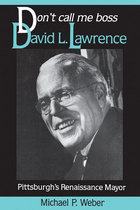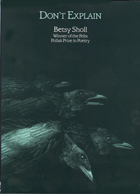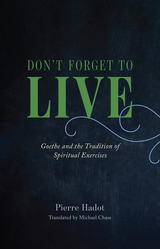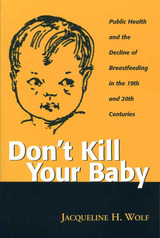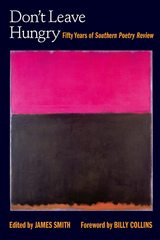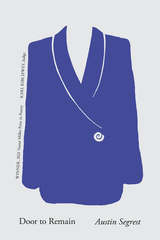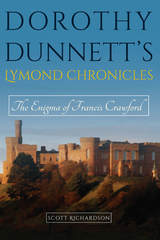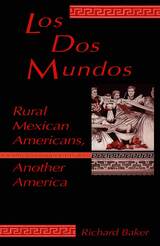A Dog Lover's Guide to Hiking Wisconsin's State Parks
Danielle St. Louis
University of Wisconsin Press, 2022 Danielle St. Louis and her energetic Labrador-border collie rescue dog, Lucky, have hiked every Wisconsin state park together. While doing so, they enjoyed the state’s rich natural beauty and the challenges that can come from hiking with a canine companion. St. Louis documents it all in this fun and thorough guide.
A Dog Lover’s Guide to Hiking Wisconsin’s State Parks divides Wisconsin into five regions and further details specific trails, graded for dog reactivity as well as the fitness level of human and canine alike. St. Louis also helpfully notes the availability of nearby facilities such as bathrooms, water stations, trashcans, designated dog swimming areas, and veterinarians. Truly one of a kind, this book is a must have for any Wisconsin dog lover looking to go out into nature with their pup.
 Dog Star
Nabarun Bhattacharya
Seagull Books, 2025 Set in the underbelly of Calcutta, a story that reimagines a city’s relationship with its abandoned animals, interlacing dark humor and political critique into a fable of resistance.
A city on edge and a reckoning long overdue—Dogstar is a searing fable of vengeance and the limits of human empathy. Nabarun Bhattacharya’s novella unfolds in Calcutta, where the city’s dogs, brutalized and unseen, rise in defiant revolt against their human oppressors. As the streets turn into battlegrounds, history itself bleeds through—echoes of past atrocities and ancient mythologies intertwining with the raw immediacy of the present.
With his signature blend of dark humor and sharp political critique, Bhattacharya crafts a hypnotic tale that forces us to confront a chilling question: Who, in the end, is truly human? Blurring the boundaries between the real and the mythic, Dogstar is a dystopian allegory as disorienting as it is revelatory. For readers drawn to Orwellian fables and narratives that unsettle and illuminate in equal measure, this is a read that will haunt and provoke long after the final page.
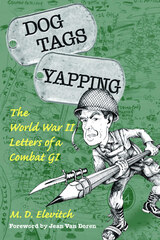 Dog Tags Yapping: The World War II Letters of a Combat GI
M.D. Elevitch. Foreword by Jean Van Doren
Southern Illinois University Press, 2003 A chronicle of war infused with uncommon cheer, Dog Tags Yapping: The World War II Letters of a Combat GI is a young man’s education in life and death and a narrative of war told completely in letters. During World War II, thousands of high school graduates were drafted into the army to be trained in colleges as engineers or other technicians but instead were assigned to fighting units and joined the great assault in Europe after D-Day. One of those reprogrammed combat infantrymen was Morton Elevitch from Duluth, Minnesota. Elevitch’s cartoons, drawings, and extremely unconventional letters home—rescued from box-in-the-basement oblivion after a more than fifty-year dormancy—recover the story of one rerouted GI in a voice that is compelling and new. Embellished with a boyish flair, the quirky and playful documents collected here impart a distinctly personal and uncalculated record of war, family, and coming of age. “It’s much easier to wield a melancholy pen than to sit down and cry,” Elevitch declares to his father. Sparkling with a patina of wit and the bittersweet allure of lost innocence, the words and letters of “Privitch Elevate” offer the immediacy of the events as they unfolded. With the ease and expertise expected of a more seasoned storyteller, the young Elevitch escorts readers through his basic training and departure for Europe, duty in Brittany with the 94th Division and departure for Germany, combat under Patton’s command, wounding by mortar fragments, convalescence in England, and his return to France with the Signal Corps to guard prisoners and await demobilization. But along with these letters are the stories of his relationships with his parents, his brother, the men of his company and even the prisoners of war. The author’s perspectives on the war radically change. Both comic and tragic in its treatment of war’s chaos and tedium, this sensitive personal history covers experiences from the adjustment to military life and the temptations of flesh to the pain of wounds and recovery and the exposure to foreign countries and cultures. Presaging his career as a novelist and editor, Elevitch’s words and drawings sketch an audacious and highly imaginative portrait of a young man during an exceptional time in world history. Evocative of life lived and nearly lost, his jarring accounts of combat reveal a soldier who was wounded not only in body but also in soul, in a war that changed him forever—just as it changed everyone it touched. Reproduced here as they were originally written, alongside a gallery of photos and hand-drawn battle maps, Elevitch’s cartoons and letters were initially intended for only three persons. But with their unique historical value and affecting exploration of the human spirit, they resurface in Dog Tags Yapping and result in an exhilarating ride for all readers through his “wild bivouac of the mind.”
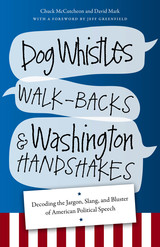 Dog Whistles, Walk-Backs, and Washington Handshakes: Decoding the Jargon, Slang, and Bluster of American Political Speech
Chuck McCutcheon and David Mark
University Press of New England, 2014 To the amusement of the pundits and the regret of the electorate, our modern political jargon has become even more brazenly two-faced and obfuscatory than ever. Where once we had Muckrakers, now we have Bed-Wetters. Where Blue Dogs once slept peaceably in the sun, Attack Dogs now roam the land. During election season—a near constant these days—the coded rhetoric of candidates and their spin doctors, and the deliberately meaningless but toxic semiotics of the wing nuts and backbenchers, reach near-Orwellian levels of self-satisfaction, vitriol, and deceit. The average NPR or talk radio listener, MSNBC or Fox News viewer, or blameless New York Times or Wall Street Journal reader is likely to be perplexed, nonplussed, and lulled into a state of apathetic resignation and civic somnolence by the rapid-fire incomprehensibility of political pronouncement and commentary—which is, frankly, putting us exactly where the pundits want us. Dog Whistles, Walk-Backs, and Washington Handshakes is a tonic and a corrective. It is a reference and field guide to the language of politics by two veteran observers that not only defines terms and phrases but also explains their history and etymology, describes who uses them against whom, and why, and reveals the most telling, infamous, amusing, and shocking examples of their recent use. It is a handbook of lexicography for the Wonkette and This Town generation, a sleeker, more modern Safire’s Political Dictionary, and a concise, pointed, bipartisan guide to the lies, obfuscations, and helical constructions of modern American political language, as practiced by real-life versions of the characters on House of Cards.
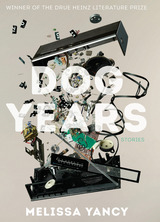 Dog Years
Melissa Yancy
University of Pittsburgh Press, 2016 Winner of the 2016 Drue Heinz Literature Prize
Winner of the 2017 California Book Awards, first fiction category
Many of these richly layered stories juxtapose the miracles of modern medicine against the inescapable frustrations of everyday life: awkward first dates, the indignities of air travel, and overwhelming megastore cereal aisles. In “Go Forth,” an aging couple attends a kidney transplant reunion, where donors and recipients collide with unexpected results; in “Hounds,” a woman who runs a facial reconstruction program for veterans nurses her dying dog while recounting the ways she has used sex as both a weapon and a salve; and in “Consider This Case,” a lonely fetal surgeon caring for his aesthete father must reconsider sexuality and the lengths people will go to have children.
Melissa Yancy’s personal experience in the milieus of hospitals, medicine, and family services infuse her narratives with a rare texture and gravity. Keenly observant, offering both sharp humor and humanity, these stories explore the ties that bind—both genetic and otherwise—and the fine line between the mundane and the maudlin. Whether the men or women that populate these pages are contending with illness, death, or parenthood, the real focus is on time and our inability to slow its progression, reminding us to revel in those moments we can control.
 Dogface Soldier: The Life of General Lucian K. Truscott, Jr.
Wilson A. Heefner
University of Missouri Press, 2010 On July 11, 1943, General Lucian Truscott received the Army's second-highest decoration, the Distinguished Service Cross, for valor in action in Sicily. During his career he also received the Army Distinguished Service Medal with Oak Leaf Cluster, the Navy Distinguished Service Medal, the Legion of Merit, and the Purple Heart. Truscott was one of the most significant of all U.S. Army generals in World War II, pioneering new combat training methods—including the famous “Truscott Trot”— and excelling as a combat commander, turning the Third Infantry Division into one of the finest divisions in the U.S. Army. He was instrumental in winning many of the most important battles of the war, participating in the invasions of North Africa, Sicily, Anzio, and southern France. Truscott was not only respected by his peers and “dogfaces”—common soldiers—alike but also ranked by President Eisenhower as second only to Patton, whose command he took over on October 8, 1945, and led until April 1946.
Yet no definitive history of his life has been compiled. Wilson Heefner corrects that with the first authoritative biography of this distinguished American military leader. Heefner has undertaken impressive research in primary sources—as well as interviews with family members and former associates—to shed new light on this overlooked hero. He presents Truscott as a soldier who was shaped by his upbringing, civilian and military education, family life, friendships, and evolving experiences as a commander both in and out of combat.
Heefner’s brisk narrative explores Truscott’s career through his three decades in the Army and defines his roles in key operations. It also examines Truscott’s postwar role as military governor of Bavaria, particularly in improving living conditions for Jewish displaced persons, removing Nazis from civil government, and assisting in the trials of German war criminals. And it offers the first comprehensive examination of his subsequent career in the Central Intelligence Agency, where he served as senior CIA representative in West Germany during the early days of the Cold War, and later as CIA Director Allen Dulles’s deputy director for coordination in Washington.
Dogface Soldier is a portrait of a man who earned a reputation for being honest, forthright, fearless, and aggressive, both as a military officer and in his personal life—a man who, at the dedication ceremony for the Anzio-Nettuno American cemetery in 1945, turned away from the crowd and to the thousands of crosses stretching before him to address those buried there. Heefner has written a definitive biography of a great soldier and patriot.
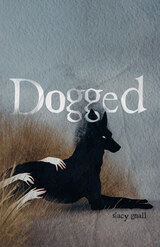 Dogged
Stacy Gnall
University of Massachusetts Press, 2022 Located somewhere between fiction and reality, the animals of Dogged exist as both “creatures children see in their fevers” and “your one / good dream / in the night.” Inhabiting a space apart from time and narrative, the space of the ever-elusive now, these haunting poems probe animal consciousness and desire, as “howls float / like crocuses— / violet / and half open / to the unknown.”
Looking to a wide range of high and low visual media, from Steven Spielberg’s Jaws and Animal Planet’s Fatal Attractions to Peter Paul Rubens’s painting of Hercules’s dog discovering Tyrian purple, Stacy Gnall ponders human-animal connections and divisions, exploring those moments when human voices blend with “silent” beasts to exceed the limits of language. In Dogged, animals emerge as the highest aspiration of poetry.
Around the bend it was reckoned
we would never grow old
because there were no words for it.
I placed my arms soft
around the neck of a fawn
and she felt no alarm. Speech
is where we went wrong.
(From “The Wood in Which Things Have No Name”)
Dogged Hearts
Ellen Doré Watson
Tupelo Press, 2010 In her fifth collection of poems, Ellen Doré Watson lends her supple voice to a multiplicity of characters, each with his or her own particular dilemma, distraction, or disarray: Junie biking home to find a new mom, Edur wondering whether he’s anyone’s father, a pregnant teen starving herself to lose the fetus, or the widower Lew buoyed by a vision of his wife after her death. With a novelist’s finesse and a poet’s details, Watson creates lives that resonate with poignancy and urgency.
In Dogged Hearts Ellen Doré Watson demonstrates a capacious talent for invention and empathy and, with her incomparable linguistic brio, gives us an unforgettable look at how loss and disconnection can usher in chance-to-change reverie and unexpected veerings towards life.
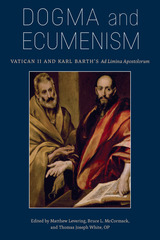 Dogma and Ecumenism: Vatican II and Karl Barth's 'Ad Limina Apostolorum'
Matthew Levering
Catholic University of America Press, 2020 The conversation of this book is structured around five major documents from the Second Vatican Council, each of which Barth commented upon in his short but penetrating response to the Council, published as Ad Limina Apostolorum. In the two opening essays, Thomas Joseph White reflects upon the contribution that this book seeks to make to contemporary ecumenism rooted in awareness of the value of dogmatic theology; and Matthew Levering explores the way in which Barth’s Ad Limina Apostolorum flows from his preconciliar dialogues with Catholic representatives of the nouvelle théologie and remain relevant to the issues facing Catholic theology today. The next two essays turn to Dei Verbum, the Dogmatic Constitution on Divine Revelation; here Katherine Sonderegger (Protestant) reflects on scripture and Lewis Ayres (Catholic) reflects on tradition. The next two essays address the Dogmatic Constitution on the Church, Lumen Gentium, which touches upon central differences of Catholic and Protestant self-understanding. Christoph Schwöbel (Protestant) analyzes visible ecclesial identity as conceived in a Protestant context, while Thomas Joseph White (Catholic) engages Barth’s Reformed criticisms of the Catholic notion of the Church. The next two essays take up Nostra Aetate: Bruce Lindley McCormack (Protestant) asks whether it is true to say that Muslims worship the same God as Christians, and Bruce D. Marshall (Catholic) explores the implications of the Council’s reflections on the Jewish people. The next two essays take up the Pastoral Constitution on the Church in the Modern World, Gaudium et Spes: John Bowlin (Protestant) makes use of the thought of Aquinas to consider the promise and perils of the document, while Francesca Aran Murphy (Catholic) engages critically with George Lindbeck’s analysis of the document. The next two essays explore Unitatis Redintegratio: Hans Boersma (Protestant) asks whether the ecumenical intention of the document is impaired by its insistence that the unity of the Church is already present in the Catholic Church, and Reinhard Hütter (Catholic) systematically addresses Barth’s questions regarding the document. The noted ecumenist and Catholic theologian Richard Schenk brings the volume to a close by reflecting on “true and false ecumenism” in the post-conciliar period.
Dogmatic and Polemical Works
Saint Jerome
Catholic University of America Press, 1965 St. Jerome's reputation rests primarily on his achievements as a translator and as a scriptural exegete. The important service that he rendered to the Church in his doctrinal works is often overlooked or minimized by those who look for originality and independence of thought
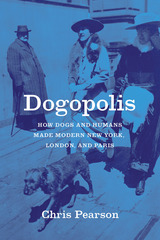 Dogopolis: How Dogs and Humans Made Modern New York, London, and Paris
Chris Pearson
University of Chicago Press, 2021 Dogopolis presents a surprising source for urban innovation in the history of three major cities: human-canine relationships.
Stroll through any American or European city today and you probably won’t get far before seeing a dog being taken for a walk. It’s expected that these domesticated animals can easily navigate sidewalks, streets, and other foundational elements of our built environment. But what if our cities were actually shaped in response to dogs more than we ever realized?
Chris Pearson’s Dogopolis boldly and convincingly asserts that human-canine relations were a crucial factor in the formation of modern urban living. Focusing on New York, London, and Paris from the early nineteenth century into the 1930s, Pearson shows that human reactions to dogs significantly remolded them and other contemporary western cities. It’s an unalterable fact that dogs—often filthy, bellicose, and sometimes off-putting—run away, spread rabies, defecate, and breed wherever they like, so as dogs became a more and more common in nineteenth-century middle-class life, cities had to respond to people’s fear of them and revulsion at their least desirable traits. The gradual integration of dogs into city life centered on disgust at dirt, fear of crime and vagrancy, and the promotion of humanitarian sentiments. On the other hand, dogs are some people’s most beloved animal companions, and human compassion and affection for pets and strays were equally powerful forces in shaping urban modernity. Dogopolis details the complex interrelations among emotions, sentiment, and the ways we manifest our feelings toward what we love—showing that together they can actually reshape society.
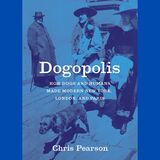 Dogopolis: How Dogs and Humans Made Modern New York, London, and Paris
Chris Pearson
University of Chicago Press, 2021 This is an auto-narrated audiobook version of this book.
Dogopolis presents a surprising source for urban innovation in the history of three major cities: human-canine relationships.
Stroll through any American or European city today and you probably won’t get far before seeing a dog being taken for a walk. It’s expected that these domesticated animals can easily navigate sidewalks, streets, and other foundational elements of our built environment. But what if our cities were actually shaped in response to dogs more than we ever realized?
Chris Pearson’s Dogopolis boldly and convincingly asserts that human-canine relations were a crucial factor in the formation of modern urban living. Focusing on New York, London, and Paris from the early nineteenth century into the 1930s, Pearson shows that human reactions to dogs significantly remolded them and other contemporary western cities. It’s an unalterable fact that dogs—often filthy, bellicose, and sometimes off-putting—run away, spread rabies, defecate, and breed wherever they like, so as dogs became a more and more common in nineteenth-century middle-class life, cities had to respond to people’s fear of them and revulsion at their least desirable traits. The gradual integration of dogs into city life centered on disgust at dirt, fear of crime and vagrancy, and the promotion of humanitarian sentiments. On the other hand, dogs are some people’s most beloved animal companions, and human compassion and affection for pets and strays were equally powerful forces in shaping urban modernity. Dogopolis details the complex interrelations among emotions, sentiment, and the ways we manifest our feelings toward what we love—showing that together they can actually reshape society.
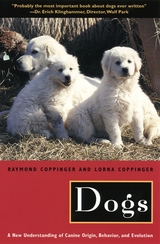 Dogs: A New Understanding of Canine Origin, Behavior and Evolution
Raymond Coppinger and Lorna Coppinger
University of Chicago Press, 2002 Biologists, breeders and trainers, and champion sled dog racers, Raymond and Lorna Coppinger have more than four decades of experience with literally thousands of dogs. Offering a scientifically informed perspective on canines and their relations with humans, the Coppingers take a close look at eight different types of dogs—household, village, livestock guarding, herding, sled-pulling, pointing, retrieving, and hound. They argue that dogs did not evolve directly from wolves, nor were they trained by early humans; instead they domesticated themselves to exploit a new ecological niche: Mesolithic village dumps. Tracing the evolution of today's breeds from these village dogs, the Coppingers show how characteristic shapes and behaviors—from pointing and baying to the sleek shapes of running dogs—arise from both genetic heritage and the environments in which pups are raised.
For both dogs and humans to get the most out of each other, we need to understand and adapt to the biological needs and dispositions of our canine companions, just as they have to ours.
Dog's Best Friend: Annals of the Dog-Human Relationship
Mark Derr
University of Chicago Press, 2004 A comprehensive, humane, and bemused tour of the dog-human relationship, Dog's Best Friend combines anecdote, research, and reportage to illuminate our complex rapport with our cherished canine companions. Tracking our national obsession with an animal that now outnumbers children in American households, Mark Derr chronicles the evolution of "the culture of the dog" from the prehistoric domestication of tamed wolves to the modern horrors of overbreeding and inbreeding.
Passionate about his subject and intent on sharing his zeal, Derr defends dogs with wit and flare, producing here a quirky, informative, and fitting tribute to our love affair with canines big and small.
The Dog's Children: Anishinaabe Texts told by Angeline Williams
Leonard Bloomfield
University of Manitoba Press, 1991 These are a collection of 20 stories, dictated in 1941 to Bloomfield's linguistics class, edited from manuscripts now in the National Anthropological Archives at the Smithsonian Institution, and published for the first time. In Ojibwe, with English translations by Bloomfield. Ojibwe-English glossary and other linguistic study aids.
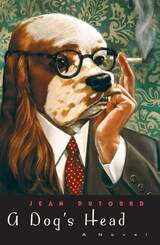 A Dog's Head
Jean Dutourd
University of Chicago Press, 1998 Jean Dutourd's A Dog's Head is a wonderful piece of magical realism, reminiscent of Voltaire, Borges and Kafka. With biting wit, Dutourd presents the story of Edmund Du Chaillu, a boy born, to his bourgeois parents's horror, with the head of a spaniel. Edmund must endure his school-mate's teasing as well as an urge to carry a newspaper in his mouth. This is the story of his life, trials, and joys as he searches for a normal life of worth and love.
"Dutourd is a fine craftsman, whose work has the classic virtues of brevity, lucidity, and concentration. He has written a sardonic divertissement that concerns itself with fundamental problems of man's existence-a tale that is sad-eyed, witty, and often very funny."—Charles J. Rolo, New York Times Book Review
"A tiny masterpiece in the French classical tradition. . . . Stylish, elegant and witty, and told with an apparent lightheartedness that points to rather than obscures the hero's essential tragedy."—P. L. Travers, New York Herald Tribune
"Wit, a good deal of shrewd classical allusion, and a Voltarian satire are the book's assets."—Edmund Fuller, Chicago Tribune
"The work of an expert craftsman and of a careful writer of prose, ending with the rarest gift in modern letters: the comic spirit."—Henri Peyre, The Saturday Review
"Dutourd might well have dropped his story at this point, had it been his intention simply to excoriate the human race for its treatment of those who are physically afflicted. Instead, he presses on in his terse, deadpan prose to teach a lesson to the afflicted of the world as well."—Time
"A Dog's Head is one of the most curious, most beautifully conceived and written fantasies you've ever come across."—J. H. Jackson, San Francisco Chronicle
"A Dog's Head is an excellent joke in the worst possible taste, and its author, M. Jean Dutourd, is a satirist of the first rank."—New Yorker
 Dogs: History, Myth, Art
Catherine Johns
Harvard University Press, 2008 Archaeological evidence of truly domestic dogs dates back to the Stone Age, when humans lived as bands of hunter-gatherers. The long association that followed, with dogs living alongside people as hunters and companions, guardians and guides, has a treasured place in history and myth—and in a wealth of art and artifacts that document and celebrate this ancient relationship.
Dogs: History, Myth, Art explores these cultural expressions and reflections of our deep and long-standing interest in dogs. Here, in exquisite reproductions, are life-size sculptures and tiny engraved gems, ceramic floor tiles and stone wall-reliefs, gold ornaments and ceramic vessels, pocketknife handles and miniature paintings, all depicting dogs from prehistory to the present. Through these illustrations—drawn from the collections of the British Museum—author Catherine Johns considers the evolution of the species, its earliest interactions with human communities, its importance in history and culture, and its role in symbolism, mythology, and legend. Dogs’ wild cousins, wolves, jackals, and foxes, also play a role in this story, and so appear alongside their domestic counterparts in this book’s engaging tour of cultural perceptions and depictions of dogs.
The juxtaposition and explanation of images as diverse as Greek pottery, Victorian jewelry, Assyrian sculpture, and Japanese netsuke, as well as drawings and paintings from 1850 bc to the twentieth century, illuminates our understanding of the place of dogs in human society around the world.
Dogs of Detroit, The: Stories
Brad Felver
University of Pittsburgh Press, 2018 The 14 stories of The Dogs of Detroit each focus on grief and its many strange permutations. This grief alternately devolves into violence, silence, solitude, and utter isolation. In some cases, grief drives the stories as a strong, reactionary force, and yet in other stories, that grief evolves quietly over long stretches of time. Many of the stories also use grief as a prism to explore the beguiling bonds within families. The stories span a variety of geographies, both urban and rural, often considering collisions between the two.
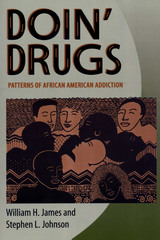 Doin’ Drugs: Patterns of African American Addiction
By William H. James and Stephen L. Johnson
University of Texas Press, 1996 Throughout the African American community, individuals and organizations ranging from churches to schools to drug treatment centers are fighting the widespread use of crack cocaine. To put that fight in a larger cultural context, Doin' Drugs explores historical patterns of alcohol and drug use from pre-slavery Africa to present-day urban America. William Henry James and Stephen Lloyd Johnson document the role of alcohol and other drugs in traditional African cultures, among African slaves before the American Civil War, and in contemporary African American society, which has experienced the epidemics of marijuana, heroin, crack cocaine, and gangs since the beginning of this century. The authors zero in on the interplay of addiction and race to uncover the social and psychological factors that underlie addiction. James and Johnson also highlight many culturally informed programs, particularly those sponsored by African American churches, that are successfully breaking the patterns of addiction. The authors hope that the information in this book will be used to train a new generation of counselors, ministers, social workers, nurses, and physicians to be better prepared to face the epidemic of drug addiction in African American communities.
Doing
Jean-Luc Nancy
Seagull Books, 2020 In Doing, Jean-Luc Nancy, one of the most prominent and lucid articulators of contemporary French theory and philosophy, examines the precarious but urgent relationship between being and doing. His book is not so much a call to action as a summons to more vigorous thinking, the examination and reflection that must precede any effective action. The first section of the book considers this matter tersely: Jean-Luc Nancy’s quickness of language and grace of humor lead the reader carefully past the dangers of oversimplification, toward a general awareness of meaningful being. In the last section, Nancy examines the realities of terrorist actions—specifically those that shocked Paris a few years ago, and more generally the frightening world of politics without conscience, where conscience is the root of all thinking.
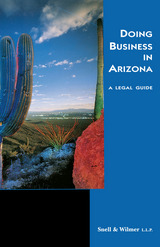 Doing Business in Arizona: A Legal Guide
Snell & Wilmer Associates Snell & Wilmer Associates
University of Arizona Press, 1998 Doing Business in Arizona brings together in one place the essential legal information for anyone who is planning to start a business, locate a facility, or invest in Arizona. What are the differences between sole proprietorships, general and limited partnerships, and corporations? And how do you choose between them in establishing your business? What is the best form of financing for your business? What do you need to know about immigration laws, employee benefits, and intellectual property? Doing Business in Arizona answers these and many more essential questions for both new and veteran business owners. The book includes valuable information for the foreign investors, offering a perspective not readily available in other legal guides. In addition to pointing out concerns specific to foreign companies and individuals doing business in the state, the book also provides a brief factual look at Arizona, including statistics on employment, industry, housing, and government, and an overview of the U.S. legal system. Compiled by the attorneys and staff of Snell & Wilmer, Arizona's largest law firm, Doing Business in Arizona is a necessary reference for business owners and investors alike.
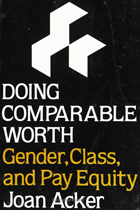 Doing Comparable Worth: Gender, Class, and Pay Equity
Joan Acker
Temple University Press, 1991 Doing Comparable Worth is the first empirical study of the actual process of attempting to translate into reality the idea of equal pay for work of equal value. This political ethnography documents a large project undertaken by the state of Oregon to evaluate 35,000 jobs of state employees, identify gender-based pay inequities, and remedy these inequities. The book details both the technical and political processes, showing how the technical was always political, how management manipulated and unions resisted wage redistribution, and how initial defeat was turned into partial victory for pay equity by labor union women and women's movement activists. As a member of the legislative task force that was responsible for implementing the legislation requiring a pay equity study in Oregon, Joan Acker gives an insider's view of how job evaluation, job classification, and the formulation of an equity plan were carried out. She reveals many of the political and technical problems in doing comparable worth that are not evident to outsiders. She also places comparable worth within a feminist theoretical perspective. In the series Women in the Political Economy, edited by Ronnie J. Steinberg.
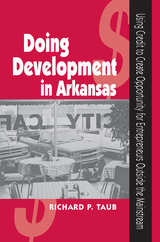 Doing Development in Arkansas: Using Credit to Create Opportunity for Entrepreneurs Outside the Mainstream
Richard Taub
University of Arkansas Press, 2004 This is the story of the Southern Development Bancorporation, an organization established in 1988 with headquarters in Arkadelphia, Arkansas, for the purpose of stimulating economic and community development in South Arkansas. Richard P. Taub chronicles this experiment in development banking, established by Bill Clinton when he was governor. Based somewhat on the model of Shorebank Corporation, a Chicago bank-holding corporation that had achieved national recognition through its development efforts in the South Shore community, Southern was established with the assistance of the state’s leading foundation as a holding company with a set of subsidiaries designed to provide crucial credit opportunities and technical assistance missing from southern Arkansas.
Doing Development in Arkansas is a history of that program as its creators tried to find their footing in new terrain, establish trust, work with borrowers despite legal pitfalls in doing so, and attempted to create new loan and technical assistance products. It is the story of the towns themselves in which Southern tried to have a substantial impact, including Arkadelphia, Hope, Malvern, Hot Springs, and Pine Bluff. Southern was an experiment and many of its achievements were the results in some cases of trying new ideas and in others of transporting programs successful in one setting to new locations. The most dramatic example of such a move is the development of the Good Faith Fund in Pine Bluff, based on a model of the Grameen Bank in Bangladesh.
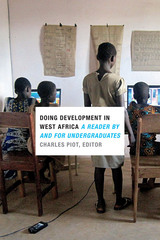 Doing Development in West Africa: A Reader by and for Undergraduates
Charles Piot
Duke University Press, 2016 In recent years the popularity of service learning and study abroad programs that bring students to the global South has soared, thanks to this generation of college students' desire to make a positive difference in the world. This collection contains essays by undergraduates who recount their experiences in Togo working on projects that established health insurance at a local clinic, built a cyber café, created a microlending program for teens, and started a local writers' group. The essays show students putting their optimism to work while learning that paying attention to local knowledge can make all the difference in a project's success. Students also conducted research on global health topics by examining the complex relationships between traditional healing practices and biomedicine. Charles Piot's introduction contextualizes student-initiated development within the history of development work in West Africa since 1960, while his epilogue provides an update on the projects, compiles an inventory of best practices, and describes the type of projects that are likely to succeed. Doing Development in West Africa provides a relatable and intimate look into the range of challenges, successes, and failures that come with studying abroad in the global South. Contributors. Cheyenne Allenby, Kelly Andrejko, Connor Cotton, Allie Middleton, Caitlin Moyles, Charles Piot, Benjamin Ramsey, Maria Cecilia Romano, Stephanie Rotolo, Emma Smith, Sarah Zimmerman
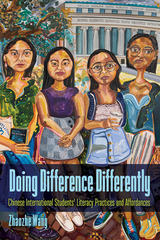 Doing Difference Differently: Chinese International Students’ Literacy Practices and Affordances
Zhaozhe Wang
Utah State University Press, 2024 Doing Difference Differently ethnographically recounts the stories of four Chinese international students navigating the complex socio-academic environment of a North American institution for higher education. Zhaozhe Wang traces the ecologically situated and distributed literacy practices of these individuals across rhetorical contexts, both on and off campus, and reconstructs the digitally networked, spatiotemporally emerging, rhetorically potent, and ecologically afforded literacy worlds of Chinese international students.
Doing Difference Differently provides an in-depth, nuanced understanding of the multifaceted literate lives of this often-marginalized cultural group, highlighting their diverse aspirations, personas, communities, challenges, and strategies. The book reconceptualizes the linguistic and cultural differences of Chinese international students as active processes of embracing, performing, resisting, negotiating, and redefining the identities that institutions impose on them through everyday literacy practices. Wang offers an analytical heuristic for researchers and educators to better understand these students’ backgrounds and to more effectively and ethically support and advocate for them. This case study critically engages broad and interconnected concepts that are essential to educators’ collective understanding of Generation Z students brought up in cultural and educational contexts outside of the European-American sphere.
This book appeals to scholars, researchers, teachers, and administrators working in North American higher education and English-speaking countries, particularly those in the fields of writing studies, second language studies, applied linguistics, multilingual education, literacy studies, and international education. Educators across disciplines seeking to better understand the growing population of Chinese international students in North America will likewise benefit.
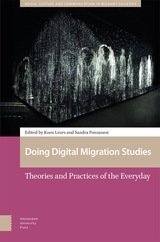 Doing Digital Migration Studies: Theories and Practices of the Everyday
Koen Leurs
Amsterdam University Press, 2024 Doing Digital Migration present a comprehensive entry point to the variety of theoretical debates, methodological interventions, political discussions and ethical debates around migrant forms of belonging as articulated through digital practices.
Digital technologies impact upon everyday migrant lives, while vice versa migrants play a key role in technological developments – be it when negotiating the communicative affordances of platforms and devices, as consumers of particular commercial services such as sending remittances, as platform gig workers or test cases for new advanced surveillance technologies. With its international scope, this anthology invites scholars to pluralize understandings of ‘the migrant’ and ‘the digital’.
The anthology is organized in five different sections: Creative Practices; Digital Diasporas and Placemaking; Affect and Belonging; Visuality and digital media and Datafication, Infrastructuring, and Securitization. These sections are dedicated to emerging key topics and debates in digital migration studies, and sections are each introduced by international experts.
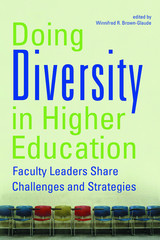 Doing Diversity in Higher Education: Faculty Leaders Share Challenges and Strategies
Brown-Glaude, Winnifred R
Rutgers University Press, 2008 Using case studies from universities throughout the nation, Doing Diversity in Higher Education examines the role faculty play in improving diversity on their campuses. The power of professors to enhance diversity has long been underestimated, their initiatives often hidden from view. Winnifred Brown-Glaude and her contributors uncover major themes and offer faculty and administrators a blueprint for conquering issues facing campuses across the country. Topics include how to dismantle hostile microclimates, sustain and enhance accomplishments, deal with incomplete institutionalization, and collaborate with administrators. The contributors' essays portray working on behalf of diversity as a genuine intellectual project rather than a faculty "service." The rich variety of colleges and universities included provides a wide array of models that faculty can draw upon to inspire institutional change.
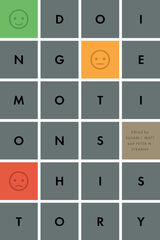 Doing Emotions History
Edited by Susan Matt and Peter N. Stearns
University of Illinois Press, 2013 How do emotions change over time? When is hate honorable? What happens when "love" is translated into different languages? Such questions are now being addressed by historians who trace how emotions have been expressed and understood in different cultures throughout history. Doing Emotions History explores the history of feelings such as love, joy, grief, nostalgia as well as a wide range of others, bringing together the latest and most innovative scholarship on the history of the emotions. Spanning the globe from Asia and Europe to North America, the book provides a crucial overview of this emerging discipline. An international group of scholars reviews the field's current status and variations, addresses many of its central debates, provides models and methods, and proposes an array of possibilities for future research. Emphasizing the field's intersections with anthropology, psychology, sociology, neuroscience, data-mining, and popular culture, this groundbreaking volume demonstrates the affecting potential of doing emotions history. Contributors are John Corrigan, Pam Epstein, Nicole Eustace, Norman Kutcher, Brent Malin, Susan Matt, Darrin McMahon, Peter N. Stearns, and Mark Steinberg.
Doing Fieldwork: Warnings and Advice
Rosalie Wax
University of Chicago Press, 1971 Recounting her own field experiences in Japanese-American relocation centers during World War II and later in American Indian communities, Rosalie H. Wax offers advice to help the beginning field worker anticipate and confront the exigencies and accidents of fieldwork with good nature, fortitude, and common sense. Doing Fieldwork is a useful book in many respects: as a guide to participant observation and ethnographic fieldwork; as an analysis of the theoretical presuppositions and history of fieldwork; as a discussion of contemporary issues in social science research; and simply as an entertaining and dramatic story.
Doing Good or Doing Better: Development Policies in a Globalizing World
Edited by Monique Kremer, Peter van Lieshout, and Robert Went
Amsterdam University Press, 2009
What drives development? What new issues have arisen due to globalization? And what kind of policies contribute to development in a rapidly changing world? The studies in Doing Good or Doing Better analyze the different development strategies employed on various continents, address current challenges, and argue that a new approach—one different from the European and American models—is necessary in a globalizing, interdependent world.
 Doing Good: Racial Tensions and Workplace Inequalities at a Community Clinic in El Nuevo South
Natalia Deeb-Sossa
University of Arizona Press, 2013 Throughout the “New South,” relationships based on race, class, social status, gender, and citizenship are being upended by the recent influx of Latina/o residents. Doing Good examines these issues as they play out in the microcosm of a community health center in North Carolina that previously had served mostly African American clients but now serves predominantly Latina/o clients. Drawing on eighteen months of experience as a participant- observer in the clinic and in-depth interviews with clinic staff at all levels, Natalia Deeb-Sossa provides an informative and fascinating view of how changing demographics are profoundly affecting the new social order.
Deeb-Sossa argues persuasively that “moral identities” have been constructed by clinic staff. The high-status staff—nearly all of whom are white—see themselves as heroic workers. Mid- and lower-status Latina staff feel like they are guardians of people who are especially needy and deserving of protection. In contrast, the moral identity of African American staffers had previously been established in response to serving “their people.” Their response to the evolving clientele has been to create a self-image of superiority by characterizing Latina/o clients as “immoral,” “lazy,” “working the system,” having no regard for rules or discipline, and being irresponsible parents.
All of the health-care workers want to be seen as “doing good.” But they fail to see how, in constructing and maintaining their own moral identity in response to their personal views and stereotypes, they have come to treat each other and their clients in ways that contradict their ideals.
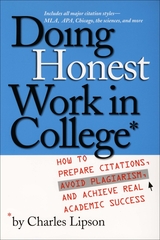 Doing Honest Work in College: How to Prepare Citations, Avoid Plagiarism, and Achieve Real Academic Success
Charles Lipson
University of Chicago Press, 2004 As college deans and faculty are well aware, cheating and plagiarism have become an epidemic. Some students deliberately download papers, while others break rules they simply don't understand. Unfortunately, there have been no reliable guides to aid students, faculty, and teaching assistants in navigating these challenging issues. Now, there's help. Charles Lipson, a distinguished scholar and teacher who has coached thousands of students in the basics of honest work, provides clear, accessible, and often humorous advice on all aspects of college studies, from papers and exams to study groups and labs.
In the first part of the book, Lipson outlines three core principles of academic honesty and explores how these principles inform all aspects of college work. He discusses plagiarism in detail, outlining an ingenious note-taking system and offering guidelines for quoting and paraphrasing. Careful attention is paid to online research, including the perils of "dragging and dropping" text without proper citation. These chapters include numerous tips, all highlighted for students, on how to work honestly and study effectively.
The second part of the book gives a full account of citation styles in the humanities, social sciences, and physical and biological sciences, as well as in pre-professional studies. Filled with examples, these chapters show students exactly how to cite books, journals, edited volumes, Web sites, online publications, and much more—in every citation style imaginable.
By clearly communicating the basic principles of academic honesty and exploring these principles in action, Doing Honest Work in College promotes genuine learning and academic success. This must-have reference empowers faculty and students to address questions about academic honesty before problems arise. It will be the book students turn to for advice from their first class to their final exam.
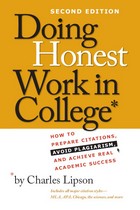 Doing Honest Work in College: How to Prepare Citations, Avoid Plagiarism, and Achieve Real Academic Success, Second Edition
Charles Lipson
University of Chicago Press, 2008
Since its publication in 2004, Doing Honest Work in College has become an integral part of academic integrity and first-year experience programs across the country. This helpful guide explains the principles of academic integrity in a clear, straightforward way and shows students how to apply them in all academic situations—from paper writing and independent research to study groups and lab work. Teachers can use this book to open a discussion with their students about these difficult issues. Students will find a trusted resource for citation help whether they are studying comparative literature or computer science. Every major reference style is represented. Most important of all, many universities that adopt this book report a reduction in cheating and plagiarism on campus.
For this second edition, Charles Lipson has updated hundreds of examples and included many new media sources. There is now a full chapter on how to take good notes and use them properly in papers and assignments. The extensive list of citation styles incorporates guidelines from the American Anthropological Association. The result is the definitive resource on academic integrity that students can use every day.
“Georgetown’s entering class will discover that we actually have given them what we expect will be a very useful book, Doing Honest Work in College. It will be one of the first things students see on their residence hall desks when they move in, and we hope they will realize how important the topic is.”—James J. O’Donnell, Provost, Georgetown University
“A useful book to keep on your reference shelf.”—Bonita L. Wilcox, English Leadership Quarterly
Doing Honest Work in College, Third Edition: How to Prepare Citations, Avoid Plagiarism, and Achieve Real Academic Success
Charles Lipson
University of Chicago Press, 2018 Doing Honest Work in College stands on three principles: do the work you say you do, give others credit, and present your research fairly. These are straightforward concepts, but the abundance of questionable online sources and temptation of a quick copy-paste can cause confusion as to what’s considered citing and what’s considered cheating. This guide starts out by clearly defining plagiarism and other forms of academic dishonesty and then gives students the tools they need to avoid those pitfalls. This edition addresses the acceptable use of mobile devices on tests, the proper approach to sources such as podcasts or social media posts, and the limitations of citation management software.
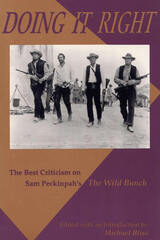 Doing It Right: The Best Criticism on Sam Peckinpah's The Wild Bunch
Edited with an Introduction by Michael Bliss
Southern Illinois University Press, 1994
Doing It Right brings together the very finest in reviews and criticism of The Wild Bunch since its release in 1969.
Often misinterpreted because of its graphic violence, the film initially generated considerable controversy. Sam Peckinpah, who made the film after a four-year forced hiatus in his career (he had been blacklisted), created it as a depiction of the savage behavior possible in the post– World War I era. However, the ensuing controversy was not restricted only to the explicit story and images. Producer Phil Feldman’s withdrawal of Peckinpah’s cut of the film drew tremendous sympathy for Peckinpah from American and European film critics alike.
This casebook should be read as a supplement to a viewing of the film, which is now available in its uncut form in video. Edited and with an introduction by Michael Bliss, the book explores the film’s production history, giving an overview of its release problems and highlighting its stylistic characteristics, classic structure, use of the widescreen frame, and innovative editing techniques. It also discusses in detail the film’s underlying moral message and its representation of camaraderie and loyalty. In addition to Bliss, essayists include Robert Culp, Paul Schrader, Stephen Farber, Paul Seydor, Jim Kitses, Cordell Strug, John L. Simons, Aljean Harmetz, and Michael Sragow. The book concludes with an appendix and an extensive bibliography.
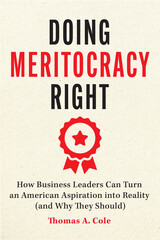 Doing Meritocracy Right: How Business Leaders Can Turn an American Aspiration into Reality (and Why They Should)
Thomas A. Cole
University of Chicago Press, 2025 A practical guide to more fully achieving a meritocratic society.
As America’s most vaunted cultural value, meritocracy is celebrated by some as an institution and derided by others as a myth—or even a trap. Thomas A. Cole argues in Doing Meritocracy Right that if meritocracy is to persist as an institution—and it must—it requires structural support in the private sector. For America to achieve a version of meritocracy that more closely matches our aspirations, our business leaders must first offer equity of opportunity for individuals to demonstrate and develop their talents on equal terms.
Drawing on his decades of experience in advising CEOs and corporate boards, personally serving on the boards of major not-for-profits, and leading a large global law firm, Cole cites elite professional-service institutions—consultancies and law firms especially—as improbable laboratories for equity of opportunity. These workplaces, out of self-interest, are laser-focused on the quality of their professionals, seeking out talent and representation and then judging these individuals on (ideally) equal terms once they’re in place. Here, Cole sees an opportunity that no public initiative or platitudes can deliver: if workplaces seek out representational diversity by applying, with thought and care, a single standard of merit—one that emphasizes character—and by providing training and mentoring on an equitable basis, then they will offer a ladder to social and economic mobility that serves both individuals and society.
Cole argues that a meritocratic society is achieved in two interrelated stages: access to education; and post-education promotion to membership in the elite. The latter, he says, is the domain of business. Cole argues that the private sector is better positioned to effect reform and he encourages leaders in the private sector to pursue reform both in their organizations, in government, and in the universities and communities where they have influence.
Meritocracy in the private sector can’t control the many American inequities that exist on the ground of American society. But it can do social good by serving as a reliable, merit-determined path to the highest echelons of business and industry. Cole sets the stage for the discussion of reforms with a “brief history of our imperfect meritocracy,” and rounds out the book with a to-do list for business leaders.
Doing Nothing
James Currie
Duke University Press, 2026 Doing Nothing is a book about doing nothing in a system where there is always something pressing that ought to be done. Not the productive unstructured time of self-help books, but the aimless and ineffective doing nothing of procrastination, resignation, and melancholia. James Currie pursues these themes across a wide terrain of experiences, materials, and examples from the personal, local, and anecdotal, through to the existential, cosmological, and apocalyptic—reflecting, among other things, on the COVID pandemic, the lives of teenagers, Lars Van Trier’s 2011 film Melancholia, work, play, and politics. Doing Nothing offers a lived-in embrace of queer states of being that stand against liveliness and the mournful feelings of entrapment and shame that exist alongside the unexpected opportunities such situations afford.
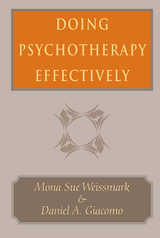 Doing Psychotherapy Effectively
Mona Sue Weissmark and Daniel A. Giacomo
University of Chicago Press, 1997 Psychotherapy is a $2.5 billion business in the United States, but no one can answer the basic question of how therapy works. No watchdog groups rank therapists for potential consumers; no one school of thought has proven to be superior to another. And no method has emerged for determining what makes therapy successful for some but not for others. Doing Psychotherapy Effectively proposes much-needed answers to the puzzling questions of what therapists actually do when they are effective.
Mona Sue Weissmark and Daniel A. Giacomo offer a unique mode of evaluation that focuses not on a particular school of therapy but on the relationship between therapist and patient. Their approach, the "Harvard Psychotherapy Coding Method," begins with the assumption that good therapeutic relationships are far from intuitive. Successful relationships follow a pattern of behaviors that can be identified and quantified, as the authors demonstrate through clinical research and videotaped sessions of expert therapists. Likewise, positive changes in the patient, observed through client feedback and case studies, can be described operationally; they involve the process of overcoming feelings of detachment, helplessness, and rigidity and becoming more involved, effective, and adaptable.
Weissmark and Giacomo explain and ground these principles in the practice of psychotherapy, making Doing Psychotherapy Effectively an accessible and pragmatic work which will give readers a tool for measuring therapeutic effectiveness and further understanding human transformation. For the first time, successful therapy is described in a way that can be practiced and communicated.
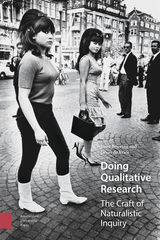 Doing Qualitative Research: The Craft of Naturalistic Inquiry
Joost Beuving and Geert de Vries
Amsterdam University Press, 2015 Naturalistic inquiry is about studying people in everyday circumstances by ordinary means. It strives to blend in, to respect people in their daily lives, to take their actions and experiences seriously, and to build on these carefully. 'Doing Qualitative Research: The Craft of Naturalistic Inquiry' offers guidance, combining thoughtful reflection with practical tips. It is written for undergraduate and graduate students in social science; for practitioners in social work, healthcare, policy advice, and organizational consultancy; and for all who have a genuine interest in society and its members.
Joost Beuving teaches anthropology at Radboud University Nijmegen. He has a special interest in everyday economic life. He has studied car dealers in the second-hand car trade between Europe and West Africa, and fishermen in the Nile perch export business on Lake Victoria, East Africa.
Geert de Vries teaches sociology at VU University Amsterdam and Amsterdam University College. He specializes in historical sociology. He has studied educational expansion, schools, the life-worlds of youngsters, and social problems and social change in the Netherlands.
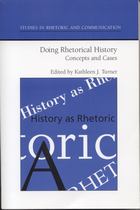 Doing Rhetorical History: Concepts and Cases
Kathleen J. Turner
University of Alabama Press, 1998 This collection argues that rhetorical history, both as a methodology
and as a perspective, offers insights that are central to the study of
communication and unavailable through other approaches. The current field of communication derives from the historical study
of rhetoric. Over the last few decades, however, as the trend toward theoretical
conceptions has driven analysis and as a host of "isms" has defined
criticism, communication studies have moved away from a predominantly historical
perspective. Yet many scholars in the field continue to find benefits in rhetorical
history. In the thirteen essays gathered here, eminent scholars address
the ongoing dialogue over the regrounding of rhetorical study and the relationship
between theory and history as well as history and criticism in the field.
Some examine the conceptual issues involved in the juncture of rhetoric
and history; others offer case studies, often based on research with primary
documents, to illustrate the process and promise of rhetorical history.
Collectively, their work tests theory and complements criticism while standing
as a distinct and valid approach in and of itself. The conceptualizations and methodologies of rhetorical history will
increase in significance during the burgeoning "Communication Age"
as we seek to cope with the present and prepare for the future by better
understanding the past. This volume serves as an excellent overview of
a recently neglected methodological approach and acts as the first step
in ending that neglect.
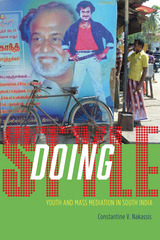 Doing Style: Youth and Mass Mediation in South India
Constantine V. Nakassis
University of Chicago Press, 2016 In Doing Style, Constantine V. Nakassis explores the world of youth and mass media in South India, where what Tamil youth call “style” anchors their day-to-day lives and media worlds. Through intimate ethnographic descriptions of college life in Tamil Nadu, Nakassis explores the complex ways that acts and objects of style such as brand fashion, English slang, and film representations express the multiple desires and anxieties of this generation, who live in the shadow of the promise of global modernity.
As Nakassis shows, while signs of the global, modern world are everywhere in post-liberalization India, for most of these young people this world is still very distant—a paradox that results in youth’s profound sense of being in between. This in-betweenness manifests itself in the ambivalent quality of style, the ways in which stylish objects are necessarily marked as counterfeit, mixed, or ironical. In order to show how this in-betweenness materializes in particular media, Nakassis explores the entanglements between youth peer groups and the sites where such stylish media objects are produced, arguing that these entanglements deeply condition the production and circulation of the media objects themselves. The result is an important and timely look at the tremendous forces of youth culture, globalization, and mass media as they interact in the vibrancy of a rapidly changing India.
Doing the Charleston: My Personal History of Scholarly Communication
Katina Strauch with Darrell W. Gunter
Against the Grain, LLC, 2025 In 1980, Katina Strauch started the Charleston Conference: Issues in Book and Serial Acquisition to bring together librarians, publishers, and vendors to discuss issues shared by the three groups. The meeting has continued annually and boasts over 3,000 attendees in person and virtually. This memoir is Katina’s diary and story of the Charleston Conference and its development concurrently with her career as a professional librarian. Over the last 45 years, there have been massive changes in scholarly communication, changes that Katina has been at the heart of. Where and what will the library and publishing professions develop next? The sky’s the limit to reimagining! Let’s go.
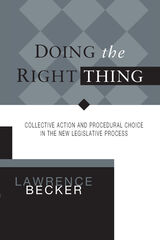 DOING THE RIGHT THING: Collective Action and Procedural Choice in the New Legislative Process
Lawrence Becker
Ohio State University Press, 2005 Doing the Right Thing examines the use of extraordinary legislative procedures in four cases in the U.S. Congress to accomplish policy objectives that many political scientists would argue are impossible to achieve. It not only shows that Congress is capable of imposing parochial costs in favor of general benefits but it argues that Congress is able to do so in a variety of policy areas through the use of very different kinds of procedural mechanisms that are underappreciated. The book opens by developing a theory of procedural choice to explain why Congress chooses to delegate in differing degrees in dealing with similar kinds of policy problems. The theory is then applied to four narrative case studies—military base closures, the Yucca Mountain Project, NAFTA, and the Tax Reform Act of 1986—that both show the variety of factors that impact procedural choice and highlight how our national legislature was able to “do the right thing.” The book concludes by pointing to the variety of ways in which Congress will be confronted with similar policy problems in the coming years and offering some lessons from these cases about what kinds of procedures and policy outcomes we might expect. In short, Congress is remarkably adept at “doing the right thing,” even under difficult circumstances, but only when legislators are willing to manipulate procedures in all the necessary ways.
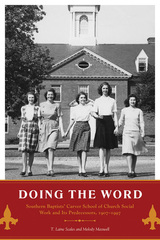 Doing the Word: Southern Baptists' Carver School of Church Social Work and Its Predecessors, 1907–1997
T. Laine Scales
University of Tennessee Press, 2019 In the pantheon of publications related to women’s educational history, there is little research concerning women’s education in the context of the Baptist church. In Doing the Word: Southern Baptists’ Carver School of Church Social Work and Its Predecessors, 1907–1997, T. Laine Scales and Melody Maxwell provide a complete history of this unique institution. By exploring the dynamic evolution of women’s education through the lens of the women’s training program for missions and social work at the Southern Baptist Theological Seminary, the authors show how the institution both expanded women’s education and leadership and also came into tension with changes in the Southern Baptist Convention, ultimately resulting in its closing in 1997. A touchstone for women’s studies and church history alike, Doing the Word reopens a lost chapter in the evolution of women’s leadership during the twentieth century—a tumultuous period in which the Carver School, under significant pressure to reverse course, sought to expand the roles of women in leading the church.
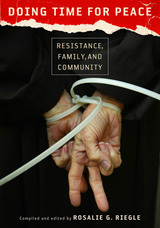 Doing Time for Peace: Resistance, Family, and Community
Rosalie G. Riegle
Vanderbilt University Press, 2013 In this compelling collection of oral histories, more than seventy-five peacemakers describe how they say no to war-making in the strongest way possible--by engaging in civil disobedience and paying the consequences in jail or prison. These courageous resisters leave family and community and life on the outside in their efforts to direct U.S. policy away from its militarism. Many are Catholic Workers, devoting their lives to the works of mercy instead of the works of war. They are homemakers and carpenters and social workers and teachers who are often called "faith-based activists." They speak from the left of the political perspective, providing a counterpoint to the faith-based activism of the fundamentalist Right.
In their own words, the narrators describe their motivations and their preparations for acts of resistance, the actions themselves, and their trials and subsequent jail time. We hear from those who do their time by caring for their families and managing communities while their partners are imprisoned. Spouses and children talk frankly of the strains on family ties that a life of working for peace in the world can cause.
The voices range from a World War II conscientious objector to those protesting the recent war in Iraq. The book includes sections on resister families, the Berrigans and Jonah House, the Plowshares Communities, the Syracuse Peace Council, and Catholic Worker houses and communities.
The introduction by Dan McKanan situates these activists in the long tradition of resistance to war and witness to peace.
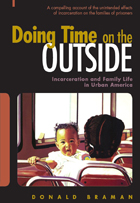 Doing Time on the Outside: Incarceration and Family Life in Urban America
Donald Braman
University of Michigan Press, 2004 "Stigma, shame and hardship---this is the lot shared by families whose young men have been swept into prison. Braman reveals the devastating toll mass incarceration takes on the parents, partners, and children left behind."
-Katherine S. Newman
"Doing Time on the Outside brings to life in a compelling way the human drama, and tragedy, of our incarceration policies. Donald Braman documents the profound economic and social consequences of the American policy of massive imprisonment of young African American males. He shows us the link between the broad-scale policy changes of recent decades and the isolation and stigma that these bring to family members who have a loved one in prison. If we want to understand fully the impact of current criminal justice policies, this book should be required reading."
-Mark Mauer, Assistant Director, The Sentencing Project
"Through compelling stories and thoughtful analysis, this book describes how our nation's punishment policies have caused incalculable damage to the fabric of family and community life. Anyone concerned about the future of urban America should read this book."
-Jeremy Travis, The Urban Institute
In the tradition of Elijah Anderson's Code of the Street and Katherine Newman's No Shame in My Game, this startling new ethnography by Donald Braman uncovers the other side of the incarceration saga: the little-told story of the effects of imprisonment on the prisoners' families.
Since 1970 the incarceration rate in the United States has more than tripled, and in many cities-urban centers such as Washington, D.C.-it has increased over five-fold. Today, one out of every ten adult black men in the District is in prison and three out of every four can expect to spend some time behind bars. But the numbers don't reveal what it's like for the children, wives, and parents of prisoners, or the subtle and not-so-subtle effects mass incarceration is having on life in the inner city.
Author Donald Braman shows that those doing time on the inside are having a ripple effect on the outside-reaching deep into the family and community life of urban America. Braman gives us the personal stories of what happens to the families and communities that prisoners are taken from and return to. Carefully documenting the effects of incarceration on the material and emotional lives of families, this groundbreaking ethnography reveals how criminal justice policies are furthering rather than abating the problem of social disorder. Braman also delivers a number of genuinely new arguments.
Among these is the compelling assertion that incarceration is holding offenders unaccountable to victims, communities, and families. The author gives the first detailed account of incarceration's corrosive effect on social capital in the inner city and describes in poignant detail how the stigma of prison pits family and community members against one another. Drawing on a series of powerful family portraits supported by extensive empirical data, Braman shines a light on the darker side of a system that is failing the very families and communities it seeks to protect.
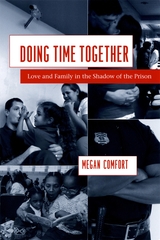 Doing Time Together: Love and Family in the Shadow of the Prison
Megan Comfort
University of Chicago Press, 2008 By quadrupling the number of people behind bars in two decades, the United States has become the world leader in incarceration. Much has been written on the men who make up the vast majority of the nation’s two million inmates. But what of the women they leave behind? Doing Time Together vividly details the ways that prisons shape and infiltrate the lives of women with husbands, fiancés, and boyfriends on the inside.
Megan Comfort spent years getting to know women visiting men at San Quentin State Prison, observing how their romantic relationships drew them into contact with the penitentiary. Tangling with the prison’s intrusive scrutiny and rigid rules turns these women into “quasi-inmates,” eroding the boundary between home and prison and altering their sense of intimacy, love, and justice. Yet Comfort also finds that with social welfare weakened, prisons are the most powerful public institutions available to women struggling to overcome untreated social ills and sustain relationships with marginalized men. As a result, they express great ambivalence about the prison and the control it exerts over their daily lives.
An illuminating analysis of women caught in the shadow of America’s massive prison system, Comfort’s book will be essential for anyone concerned with the consequences of our punitive culture.
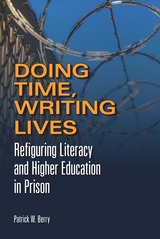 Doing Time, Writing Lives: Refiguring Literacy and Higher Education in Prison
Patrick W. Berry
Southern Illinois University Press, 2018 Winner, Coalition for Community Writing Outstanding Book Award 2019
Doing Time, Writing Lives offers a much-needed analysis of the teaching of college writing in U.S. prisons, a racialized space that—despite housing more than 2 million people—remains nearly invisible to the general public. Through the examination of a college-in-prison program that promotes the belief that higher education in prison can reduce recidivism and improve life prospects for the incarcerated and their families, author Patrick W. Berry exposes not only incarcerated students’ hopes and dreams for their futures but also their anxieties about whether education will help them.
Combining case studies and interviews with the author’s own personal experience of teaching writing in prison, this book chronicles the attempts of incarcerated students to write themselves back into a society that has erased their lived histories. It challenges polarizing rhetoric often used to describe what literacy can and cannot deliver, suggesting more nuanced and ethical ways of understanding literacy and possibility in an age of mass incarceration.
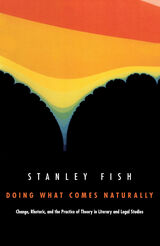 Doing What Comes Naturally: Change, Rhetoric, and the Practice of Theory in Literary & Legal Studies
Stanley Fish
Duke University Press, 1989 In literary theory, the philosophy of law, and the sociology of knowledge, no issue has been more central to current debate than the status of our interpretations. Do they rest on a ground of rationality or are they subjective impositions of a merely personal point of view? In Doing What Comes Naturally, Stanley Fish refuses the dilemma posed by this question and argues that while we can never separate our judgments from the contexts in which they are made, those judgments are nevertheless authoritative and even, in the only way that matters, objective. He thus rejects both the demand for an ahistorical foundation, and the conclusion that in the absence of such a foundation we reside in an indeterminate world. In a succession of provocative and wide-ranging chapters, Fish explores the implications of his position for our understanding of legal, literary, and psychoanalytic interpretation, the nature of professional and institutional culture, and the place of reason in a world that is rhetorical through and through.
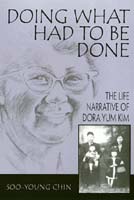 Doing What Had To Be Done
Soo-Young Chin
Temple University Press, 1999 The first biography of an American-born Korean woman, Doing What Had to Be Done is, on the surface, the life story of Dora Yum Kim. But telling more than one woman's story, author Soo-Young Chin offers more than an unusual glimpse at the shaping of a remarkable community activist. In addition -- as she questions her subject, introduces each chapter, and reflects on how Dora's story relates to her own experience as a Korean American who immigrate to this country as an adult -- she carves around Dora's compelling story and courageous life story a story of her own and one of all Korean Americans.
Born in 1921, Dora, as she tells Chin her story, chronicles the shifting salience of gendered ethnic identity as she journeys through her life. Traveling through time and place, she moves from San Francisco's Chinatown -- where Koreans were a minority within a minority -- to suburban Dewey Boulevard where Dora and her family attempt to integrate into mainstream America, and where she becomes a social worker in the California State Department of Employment. As the Korean immigrant community grows in the late 1960s, Dora becomes deeply involved in community service. She remembers teaching English to senior citizens and preparing them for their naturalization exams, finding jobs for the younger Koreans, and founding a community center and meals program for seniors.
A detailed and inspiring lens through which to view Korean American history, Dora's life journey echoes the changing spaces of the American social landscape. And the grace and ease with which Dora just "does what has to be done" shows us the importance of everyday acts in making a difference.
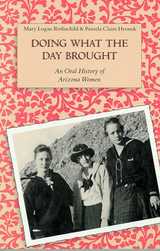 Doing What the Day Brought: An Oral History of Arizona Women
Mary Logan Rothschild and Pamela Claire Hronek
University of Arizona Press, 1992 "I've seen many changes during the years," says Irene Bishop, "from horse and buggy to automobiles and planes, from palm leaf fans to refrigeration. . . . They talk about the good old days but I do not want to go back. I'd like to go back about twenty years, but not beyond that. Life was too hard."
Drawing on interviews with twenty-nine individuals, Doing What the Day Brought examines the everyday lives of women from the late nineteenth century to the present day and demonstrates the role they have played in shaping the modern Arizona community.
Focusing on "ordinary" women, the book crosses race, ethnic, religious, economic, and marital lines to include Arizona women from diverse backgrounds. Rather than simply editing each woman's words, Rothschild and Hronek have analyzed these oral histories for common themes and differences and have woven portions into a narrative that gives context to the individual lives. The resulting life-course format moves naturally from childhood to home life, community service, and participation in the work force, and concludes with reflections on changes witnessed in the lifetimes of these women.
For the women whose lives are presented here, it may have been common to gather dead saguaro cactus ribs to make outdoor fires to boil laundry water, or to give birth on a dirt floor. Their stories capture not only changes in a state where history has overlooked the role of women, but the changing roles of American women over the course of this century.
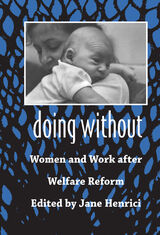 Doing Without: Women and Work after Welfare Reform
Edited by Jane Henrici
University of Arizona Press, 2006 The welfare reform legislation enacted in 1996 was applauded by many for the successes it had in dramatically reducing the number of people receiving public assistance, most of whom were women with children. Today, however, more than a decade later, these successes seem far less spectacular. Although the total number of welfare recipients has dropped by more than fifty percent nationwide, evidence shows that poverty has actually deepened. Many hardworking women are no better off for having returned to the workplace.
In Doing Without, Jane Henrici brings together nine contributions to tell the story of welfare reform from inside the lives of the women who live with it. Cases from Chicago and Boston are combined with a focus on San Antonio from one of the largest multi-city investigations on welfare reform ever undertaken. The contributors argue that the employment opportunities available to poorer women, particularly single mothers and ethnic minorities, are insufficient to lift their families out of poverty. Typically marked by variable hours, inadequate wages, and short-term assignments, both employment and training programs fail to provide stability or the kinds of benefits—such as health insurance, sick days, and childcare options—that are necessary to sustain both work and family life. The chapters also examine the challenges that the women who seek assistance, and those who work in public and private agencies to provide it, together must face as they navigate ever-changing requirements and regulations, decipher alterations in Medicaid, and apply for training and education. Contributors urge that the nation should repair the social safety net for women in transition and offer genuine access to jobs with wages that actually meet the cost of living.
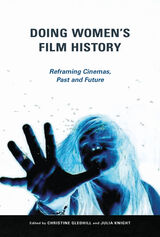 Doing Women's Film History: Reframing Cinemas, Past and Future
Edited by Christine Gledhill and Julia Knight
University of Illinois Press, 2015 Research into and around women's participation in cinematic history has enjoyed dynamic growth over the past decade. A broadening of scope and interests encompasses not only different kinds of filmmaking--mainstream fiction, experimental, and documentary--but also practices--publicity, journalism, distribution and exhibition--seldom explored in the past. Cutting-edge and inclusive, Doing Women's Film History ventures into topics in the United States and Europe while also moving beyond to explore the influence of women on the cinemas of India, Chile, Turkey, Russia, and Australia. Contributors grapple with historiographic questions that cover film history from the pioneering era to the present day. Yet the writers also address the very mission of practicing scholarship. Essays explore essential issues like identifying women's participation in their cinema cultures, locating previously unconsidered sources of evidence, developing methodologies and analytical concepts to reveal the impact of gender on film production, distribution and reception, and reframing film history to accommodate new questions and approaches. Contributors include: Kay Armatage, Eylem Atakav, Karina Aveyard, Canan Balan, Cécile Chich, Monica Dall'Asta, Eliza Anna Delveroudi, Jane M. Gaines, Christine Gledhill, Julia Knight, Neepa Majumdar, Michele Leigh, Luke McKernan, Debashree Mukherjee, Giuliana Muscio, Katarzyna Paszkiewicz, Rashmi Sawhney, Elizabeth Ramirez Soto, Sarah Street, and Kimberly Tomadjoglou.
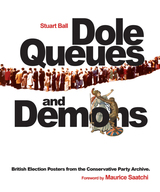 Dole Queues and Demons: British Election Posters from the Conservative Party Archive
Stuart Ball
Bodleian Library Publishing, 2011 Bold amalgams of graphic design, psychology, and art, election posters have remained unsung—and sometimes even maligned—since their inception at the beginning of the twentieth century. Through a careful selection from among the more than seven hundred posters in the Bodleian Library’s Conservative Party Archive, this lavishly illustrated volume charts the evolution of the election posters created by Britain’s Conservative Party.
Organized chronologically and by political period, each chapter begins with a brief introduction highlighting the major themes of the period as well as the specific issues individual posters were designed to engage. Together, the chapters demonstrate the changing fashions in and attitudes toward advertising, political ideology, and standards of acceptability in the election poster, and they offer fascinating insight into the strategies of the Conservative Party up to the present day. Rounding out the discussion is a foreword by advertising tycoon Maurice Saatchi, who discusses the posters from a communications and design perspective.
At a time when the new media seems poised to put an end to more traditional forms of mass communication, Dole Queues and Demons offers a timely retrospective of an enduring feature of the British electoral landscape.
The Doll
Boleslaw Prus
Central European University Press, 1997 The city of Warsaw, under Russian rule in the late 1870s, is the setting for this story. The middle-aged hero, Wokulski, bold and successful in business, is being destroyed by his obsessive love for the frigid, aristocratic society ‘doll’ Izabela. The embattled aristocracy, the new men of finance, Dickensian tradesmen and the urban poor all come vividly to life on the vast, superbly detailed canvas.
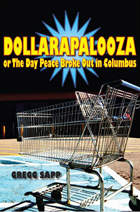 Dollarapalooza or The Day Peace Broke Out in Columbus
Gregg Sapp
Northern Illinois University Press, 2011
This sprawling, footnoted, comedic epic centers around Vonn Carp, who travels to his hometown of Columbus, Ohio, for a funeral. He is returning disgraced and destitute, when, after a long and productive career in higher education, he was discovered to have falsified his academic credentials 20 years prior. Recently divorced and suddenly unemployable, he reluctantly agrees to join
his father, Milt, in what he considers an iffy business venture—Dollarapalooza, a family-owned dollar store.
For Milt the shop is the fulfillment of a lifelong dream for old fashioned mercantilism, a “general” store. The store falls on hard times when a massive, big box “Wow-Mart” opens across the street and after a nearly tragic armed robbery in his store, Milt disappears. To the surprise and chagrin of the Carp family, Vonn insists on re-opening Dollarapalooza. Along with the store’s eccentric staff, Vonn fashions an alternative business model aiming to make a difference in people’s lives “one dollar at a time.” For just one dollar, Vonn will answer anybody’s question on any topic, and the citizens of Columbus come to him seeking his opinions on subjects like love, celibacy, anthropology, metaphysics, the Internet, and the true meaning of value. Through his interactions with the store’s staff and customers, he conceives a new way of life with a changed outlook and a restored sense of purpose.
 Dollars And Votes
Dan Clawson
Temple University Press, 1998 Recent scandals, including questionable fun-raising tactics by the current administration, have brought campaign finance reform into the forefront of the news and the public consciousness. Dollars and Votes goes beyond the partial, often misleading, news stories and official records to explain how our campaign system operates. The authors conducted thorough interviews with corporate "government relations" officials about what they do and why they do it. The results provide some of the most damning evidence imaginable.
What donors, especially business donors, expect for their money is "access" and access means a lot more than a chance to meet and talk. They count on secret behind-the-scenes deals, like a tax provision that applies only to a "corporation incorporated on June 13, 1917, which has its principal place of business in Bartlesville, Oklahoma." After a deal is worked out behind closed doors, one executive explains, "it doesn't much matter how people vote afterwards."
Ordinary contributions give access to Congress; megabuck "soft money" contributions ensure access to the President and top leaders. The striking truth revealed by these authors is that half the soft money comes from fewer than five hundred big donors, and that most contributions come, directly or indirectly, from business. Reform is possible, they argue, by turning away from the temptation of looking at specific scandals and developing a new system that removes the influence of big money campaign contributors.
Dollhouse: A Play
Rebecca Gilman
Northwestern University Press, 2010 Nora seems to have it all: a successful husband, three adorable children, and a beautiful home in the tony Lincoln Park neighborhood of Chicago. But what looks like the perfect life is woefully incomplete, propped up by dark secrets and bitter betrayals. While her husband, Terry, singlemindedly climbs the career ladder, Nora’s compulsive shopping and scheming pushes her ever further from freedom and self-fulfillment. As the lies on which their life is built gradually emerge, Nora comes to realize the true cost of what she thinks she has always wanted. From Ibsen’s masterpiece A Doll’s House, award-winning playwright Rebecca Gilman crafts a bold and insightful update. This contemporary adaptation brings Ibsen’s classic into our century with a sharp eye for social satire and moments of dark comedy coupled with powerful human drama.
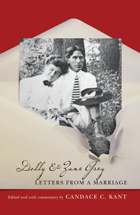 Dolly and Zane Grey: Letters from a Marriage
Candace C. Kant
University of Nevada Press, 2011 Popular western writer Zane Grey was a literary celebrity during his lifetime and the center of a huge enterprise based on his writing, which included books, magazine serials, film and stage versions of his stories, even comic strips. His wife, Dolly, closely guided Grey's career almost from its beginning, editing and sometimes revising his work, negotiating with publishers and movie studios, and skillfully managing the considerable fortune derived from these activities. Dolly maintained the facade of a conventional married life that was essential to Grey's public image and the traditional middle-class values his work reflected. This facade was constantly threatened by Grey's numerous affairs with other women. The stress of hiding these dalliances placed a huge strain on their relationship, and much of Zane and Dolly's union was sustained largely by correspondence. Their letters--thousands of them--reveal the true nature of this complex partnership. As edited by Candace Kant, the letters offer an engrossing portrait of an extremely unorthodox marriage and its times.
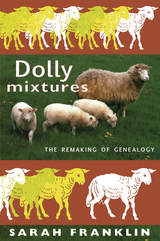 Dolly Mixtures: The Remaking of Genealogy
Sarah Franklin
Duke University Press, 2007 While the creation of Dolly the sheep, the world's most famous clone, triggered an enormous amount of discussion about human cloning, in Dolly Mixtures the anthropologist Sarah Franklin looks beyond that much-rehearsed controversy to some of the other reasons why the iconic animal's birth and death were significant. Building on the work of historians and anthropologists, Franklin reveals Dolly as the embodiment of agricultural, scientific, social, and commercial histories which are, in turn, bound up with national and imperial aspirations. Dolly was the offspring of a long tradition of animal domestication, as well as the more recent histories of capital accumulation through selective breeding, and enhanced national competitiveness through the control of biocapital. Franklin traces Dolly's connections to Britain's centuries-old sheep and wool markets (which were vital to the nation's industrial revolution) and to Britain's export of animals to its colonies—particularly Australia—to expand markets and produce wealth. Moving forward in time, she explains the celebrity sheep's links to the embryonic cell lines and global bioscientific innovation of the late twentieth century and early twenty-first. Franklin combines wide-ranging sources—from historical accounts of sheep-breeding, to scientific representations of cloning by nuclear transfer, to popular media reports of Dolly's creation and birth—as she draws on gender and kinship theory as well as postcolonial and science studies. She argues that there is an urgent need for more nuanced responses to the complex intersections between the social and the biological, intersections which are literally reshaping reproduction and genealogy. In Dolly Mixtures, Franklin uses the renowned sheep as an opportunity to begin developing a critical language to identify and evaluate the reproductive possibilities that post-Dolly biology now faces, and to look back at some of the important historical formations that enabled and prefigured Dollys creation.
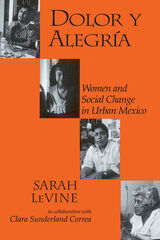 Dolor y Alegria: Women and Social Change in Urban Mexico
Sarah LeVine; In Collaboration with Clara Sunderland Correa
University of Wisconsin Press, 1993 In Dolor y Alegría (Sorrow and Joy), fifteen mothers, grandmothers, and great grandmothers in the Mexican city of Cuernavaca speak about the dramatic effects that urbanization and rapid social change have had on their lives. Sarah LeVine deftly combines these autobiographical vignettes with ethnographic material, survey findings, and her own observations. The result is a vivid picture of contrast and continuity.
While many earlier publications have focused on the poor of Latin America who live at the margins of urban life, Dolor y Alegría explores the experiences of ordinary working and lower-middle class women, most of them transplants from villages and small towns to a densely populated city neighborhood. In their early years, many experienced family disruption, emotional deprivation, and economic hardship; but steadily increasing educational opportunities, improved health care, and easily available contraception have significantly altered how the younger women relate to their families and the larger society.
Today’s Mexican schoolgirl, LeVine shows, is encouraged to apply herself to her studies for her own benefit, and the longer she remains in school, the greater the self-confidence she will carry with her into the world of work and later into marriage and motherhood. Hard economic times have forced many married women into the workplace where their sense of personal efficacy is enhanced; at the same time, in the domestic sphere, their earnings allow them greater negotiating power with husbands and male relatives. Changes are not confined to the younger generation. Older women are enjoying better health and living longer; but with adult children either less able or willing to accept responsibility for aged parents than they were in the past, anxiety runs high and family relations are often strained.
Dolor y Alegría takes a close look at the efforts of three generations of Mexican women to redefine themselves in both family and workplace; it shows that today’s young woman has very different expectations of herself and others from those that her grandmother or even her mother had.
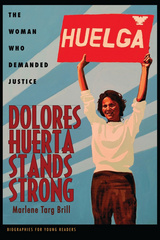 Dolores Huerta Stands Strong: The Woman Who Demanded Justice
Marlene Targ Brill
Ohio University Press, 2018 Selected as a Bank Street College of Education Best Children’s Book of the Year for 2018 (Category: Twelve–Fourteen)
“A biography for the times … An excellent read for anyone hoping to believe one person can make a difference.” —Kirkus (starred review)
“This well-told, age-appropriate account of a vital and essential activist deserves a place in all middle grade collections.” —School Library Journal (starred review) Today, we know Dolores Huerta as the cofounder, with Cesar Chavez, of the National Farmworkers Association, which later became the United Farm Workers of America. We know her as a tireless advocate for the rights of farmworkers, Mexican American immigrants, women, and LGBTQ populations. And we know her as the recipient of the Presidential Medal of Freedom from Barack Obama in 2012. Before all that, though, Huerta was a child in the farming community of Stockton, California, and then a teenager whose teachers underestimated her because she was Chicana. When she became a teacher herself, she witnessed her students coming to school shoeless and hungry. Many took days off from school to work in the farm fields to help feed their families. What could she do to help them? A young mother at the time, Huerta quit her teaching job to organize their parents. That began her journey to educate a nation about who produces our food and the conditions under which they work. Dolores Huerta Stands Strong follows Huerta’s life from the mining communities of the Southwest where her father toiled, to the vineyards and fields of California, and across the country to the present day. As she worked for fair treatment for others, Dolores earned the nation’s highest honors. More important, she found her voice.
 Dolphin Confidential: Confessions of a Field Biologist
Maddalena Bearzi
University of Chicago Press, 2012 Who hasn’t fantasized about the unique thrill of working among charismatic and clever dolphins in the wild? Now we no longer have to rely solely on our imaginations . With Dolphin Confidential, Maddalena Bearzi invites all of us shore-bound dreamers to join her and travel alongside the dolphins. In this fascinating account, she takes us inside the world of a marine scientist and offers a firsthand understanding of marine mammal behavior, as well as the frustrations, delights, and creativity that make up dolphin research.
In this intimate narrative, Bearzi recounts her experiences at sea, tracing her own evolution as a woman and a scientist from her earliest travails to her transformation into an advocate for conservation and dolphin protection. These compelling, in-depth descriptions of her fieldwork also present a captivating look into dolphin social behavior and intelligence. The central part of the book is devoted to the metropolitan bottlenose dolphins of California, as Bearzi draws on her extensive experience to offer insights into the daily lives of these creatures—as well as the difficulties involved in collecting the data that transforms hunches into hypotheses and eventually scientific facts. The book closes by addressing the critical environmental and conservation problems facing these magnificent, socially complex, highly intelligent, and emotional beings.
An honest, down-to-earth analysis of what it means to be a marine biologist in the field today, Dolphin Confidential offers an entertaining, refreshingly candid, and always informative description of life among the dolphins.
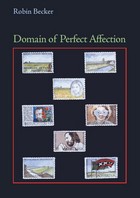 Domain of Perfect Affection
Robin Becker
University of Pittsburgh Press, 2006 In Domain of Perfect Affection, Robin Becker explores the conditions under which we experience and resist pleasure: in beauty salon, summer camp, beach, backyard, or museum; New York or New Mexico. “The Mosaic injunction against / the graven image” inspires meditations on drawings by Dürer, Evans, Klee, Marin, and del Sarto. To the consolations of art and human intimacy, Becker brings playfulness—“Worry stole the kayaks and soured the milk”—suffused with self-knowledge: “Worry wraps her long legs / around me, promises to be mine forever.” In “The New Egypt,” the narrator mines her family’s legacy: “From my father I learned the dignity / of exile and the fire of acquisition, / not to live in places lightly, but to plant / the self like an orange tree in the desert.” Becker’s shapely stanzas—couplets, tercets, quatrains, pantoum, sonnet, syllabics—subvert her colloquial diction, creating a seamless merging of subject and form. Luminous, sensual, these poems offer sharp pleasures as they argue, elegize, mourn, praise, and sing.
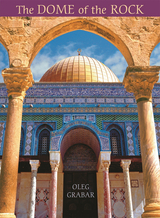 The Dome of the Rock
Oleg Grabar
Harvard University Press, 2006 The Dome of the Rock, the beautiful Muslim shrine in the walled Old City of Jerusalem, was fully restored to its original state in the last half-century. Thus, this structure, sited on the third holiest spot on earth for Muslims, is at once a product of the seventh century and almost entirely the work of our own times--a paradox in keeping with the complexities and contradictions of history and religion, architecture and ideology that define this site.
This book tells the story of the Dome of the Rock, from the first fateful decades of its creation--on the esplanade built in the fourth decade B.C.E. for the Second Jewish Temple--to its engulfment in the clashes of the Crusades and the short-lived Christianization of all of Jerusalem, to its modern acquisition of different and potent meanings for Muslim, Christian, and Jewish cultures.
Oleg Grabar's presentation combines what we know of the building with the views of past observers and with the broader historical, cultural, and aesthetic implications of the monument. Primarily it is as a work of art that the Dome of the Rock stands out from these pages, understood for the quality that allows it to transcend the constrictions of period and perhaps even those of faith and culture. Finally, Grabar grapples with the question this monumental work of art so eloquently poses: whether the pious requirements of a specific community can be reconciled with universal aesthetic values.
Domestic Architecture In Andes
Mark S. Aldenderfer
University of Iowa Press, 1993 Domestic Architecture, Ethnicity, and Complementarity in the South-Central Andes is a comprehensive and challenging look at the burgeoning field of Andean domestic architecture. Aldenderfer and fourteen contributors use domestic architecture to explore two major topics in the prehistory of the south-central Andes: the development of different forms of complementary relationships between highland and lowland peoples and the definition of the ethnic affiliations of these peoples.
 Domestic Broils: Shakers, Antebellum Marriage, and the Narratives of Mary and Joseph Dyer
Elizabeth De Wolfe
University of Massachusetts Press, 2010 In 1813, Joseph Dyer, his wife Mary, and their five children joined the Shaker community in Enfield, New Hampshire. Joseph quickly adapted to the Shaker way of life, but Mary chafed under its strictures and eventually left the community two years later. When the local elders and her husband refused to release the couple’s children to Mary, she embarked on what would become a fifty-year campaign against the Shakers, beginning with the publication in 1818 of A Brief Statement of the Sufferings of Mary Dyer. The following year the Shakers countered by publishing Joseph’s A Compendious Narrative, a scathing attack on what the title page called “the character, disposition and conduct of Mary Dyer.” Reproduced here for the first time since their original publication, the Dyers’ dueling accounts of the breakup of their marriage form the core of Domestic Broils. In Mary’s telling, the deceptions of a cruel husband, backed by an unyielding Shaker hierarchy, destroyed what had once been a happy, productive family. Joseph’s narrative counters these claims by alleging that Mary abused her children, neglected her husband, and engaged in extramarital affairs. In her introduction to the volume, Elizabeth De Wolfe places the Dyers’ marital dispute in a broader historical context, drawing on their personal testimony to examine connected but conflicting views of marriage, family life, and Shakerism in the early republic. She also shows how the growing world of print facilitated the transformation of a private family quarrel into a public debate. Salacious, riveting, and immensely popular throughout New England, the Dyers’ narratives not only captured imaginations but also reflected public anxieties over rapid cultural change in antebellum America.
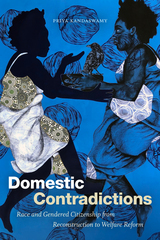 Domestic Contradictions: Race and Gendered Citizenship from Reconstruction to Welfare Reform
Priya Kandaswamy
Duke University Press, 2021 In Domestic Contradictions, Priya Kandaswamy analyzes how race, class, gender, and sexuality shaped welfare practices in the United States alongside the conflicting demands that this system imposed upon Black women. She turns to an often-neglected moment in welfare history, the advent of the Freedmen's Bureau during Reconstruction, and highlights important parallels with welfare reform in the late twentieth century. Kandaswamy demonstrates continuity between the figures of the “vagrant” and “welfare queen” in these time periods, both of which targeted Black women. These constructs upheld gendered constructions of domesticity while defining Black women's citizenship in terms of an obligation to work rather than a right to public resources. Pushing back against this history, Kandaswamy illustrates how the Black female body came to represent a series of interconnected dangers—to white citizenship, heteropatriarchy, and capitalist ideals of productivity —and how a desire to curb these threats drove state policy. In challenging dominant feminist historiographies, Kandaswamy builds on Black feminist and queer of color critiques to situate the gendered afterlife of slavery as central to the historical development of the welfare state.
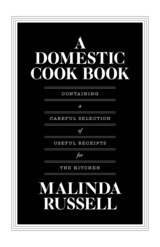 A Domestic Cook Book: Containing a Careful Selection of Useful Receipts for the Kitchen
Malinda Russell
University of Michigan Press, 2025 A Domestic Cook Book (1866) by Malinda Russell is the oldest known published cookbook written by an African American woman. Born in Tennessee, and descended from Virginia freemen, Russell decided to move to Liberia at the age of 19. When her money for the trip was stolen, she was stranded in Lynchburg, Virginia, and began working as a cook and companion, traveling with women as a nurse. After living in Lynchburg for only four years, Russell’s husband died and she moved with her son to Tennessee where she kept a boarding house and then went on to run a pastry shop. After a second dramatic robbery in 1864, Russell moved to Paw Paw, Michigan, because she had heard it was the “garden of the west” and published a cookbook “with the intention of benefiting the public” as well as supporting herself.
A Domestic Cook Book contains 260 recipes and household tips that draw from Malinda Russell’s twenty years of experience cooking in Southern kitchens, her boarding house, and her pastry shop, and showcase her skills as a pastry chef. This new edition includes a foreword by scholar Rafia Zafar as well as an introduction by the late food historian Janice Bluestein Longone that contextualize Russell’s cookbook. Using the only known copy of the original book housed in the Janice Bluestein Longone Culinary Archive at the University of Michigan Library's Special Collections Research Center, this new edition preserves an important part of Michigan and American history and makes it widely available to readers for the first time.
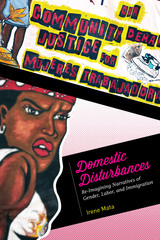 Domestic Disturbances: Re-Imagining Narratives of Gender, Labor, and Immigration
By Irene Mata
University of Texas Press, 2014 The issue of immigration is one of the most hotly debated topics in the national arena, with everyone from right-wing pundits like Sarah Palin to alternative rockers like Zack de la Rocha offering their opinion. The traditional immigrant narrative that gained popularity in the nineteenth and twentieth centuries continues to be used today in describing the process of the “Americanization” of immigrants. Yet rather than acting as an accurate representation of immigrant experiences, this common narrative of the “American Dream” attempts to ideologically contain those experiences within a story line that promotes the idea of achieving success through hard work and perseverance. In Domestic Disturbances, Irene Mata dispels the myth of the “shining city on the hill” and reveals the central truth of hidden exploitation that underlies the great majority of Chicana/Latina immigrant stories. Influenced by the works of Latina cultural producers and the growing interdisciplinary field of scholarship on gender, immigration, and labor, Domestic Disturbances suggests a new framework for looking at these immigrant and migrant stories, not as a continuation of a literary tradition, but instead as a specific Latina genealogy of immigrant narratives that more closely engage with the contemporary conditions of immigration. Through examination of multiple genres including film, theatre, and art, as well as current civil rights movements such as the mobilization around the DREAM Act, Mata illustrates the prevalence of the immigrant narrative in popular culture and the oppositional possibilities of alternative stories.
 Domestic Economies: Women, Work, and the American Dream in Los Angeles
Susanna Rosenbaum
Duke University Press, 2017 In Domestic Economies, Susanna Rosenbaum examines how two groups of women—Mexican and Central American domestic workers and the predominantly white, middle-class women who employ them—seek to achieve the "American Dream." By juxtaposing their understandings and experiences, she illustrates how immigrant and native-born women strive to reach that ideal, how each group is indispensable to the other's quest, and what a vital role reproductive labor plays in this pursuit. Through in-depth ethnographic research with these women at work, at home, and in the urban spaces of Los Angeles, Rosenbaum positions domestic service as an intimate relationship that reveals two versions of female personhood. Throughout, Rosenbaum underscores the extent to which the ideology of the American Dream is racialized and gendered, exposing how the struggle for personal worth and social recognition is shaped at the intersection of motherhood and paid employment.
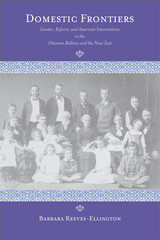 Domestic Frontiers: Gender, Reform, and American Interventions in the Ottoman Balkans and the Near East
Barbara Reeves-Ellington
University of Massachusetts Press, 2013 During the nineteenth and early twentieth centuries, American Protestant missionaries attempted to export their religious beliefs and cultural ideals to the Ottoman Empire. Seeking to attract Orthodox Christians and even Muslims to their faith, they promoted the paradigm of the "Christian home" as the foundation of national progress. Yet the missionaries' efforts not only failed to win many converts but also produced some unexpected results.
Drawing on a broad range of sources—Ottoman, Bulgarian, Russian, French, and English—Barbara Reeves-Ellington tracks the transnational history of this little-known episode of American cultural expansion. She shows how issues of gender and race influenced the missionaries' efforts as well as the complex responses of Ottoman subjects to American intrusions into their everyday lives. Women missionaries—married and single—employed the language of Christian domesticity and female moral authority to challenge the male-dominated hierarchy of missionary society and to forge bonds of feminist internationalism. At the same time, Orthodox Christians adapted the missionaries' ideology to their own purposes in developing a new strain of nationalism that undermined Ottoman efforts to stem growing sectarianism within their empire. By the beginning of the twentieth century, as some missionaries began to promote international understanding rather than Protestantism, they also paved the way for future expansion of American political and commercial interests.
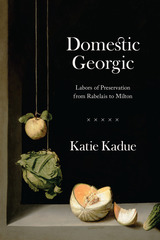 Domestic Georgic: Labors of Preservation from Rabelais to Milton
Katie Kadue
University of Chicago Press, 2021 Inspired by Virgil’s Georgics, this study conceptualizes Renaissance poetry as a domestic labor.
When is literary production more menial than inspired, more like housework than heroics of the mind? In this revisionist study, Katie Kadue shows that some of the authors we credit with groundbreaking literary feats—including Michel de Montaigne and John Milton—conceived of their writing in surprisingly modest and domestic terms. In contrast to the monumental ambitions associated with the literature of the age, and picking up an undercurrent of Virgil’s Georgics, poetic labor of the Renaissance emerges here as often aligned with so-called women’s work. Kadue reveals how male authors’ engagements with a feminized georgic mode became central to their conceptions of what literature is and could be. This other georgic strain in literature shared the same primary concern as housekeeping: the necessity of constant, almost invisible labor to keep the things of the world intact. Domestic Georgic brings into focus a conception of literary—as well as scholarly and critical—labor not as a striving for originality and fame but as a form of maintenance work that aims at preserving individual and collective life.
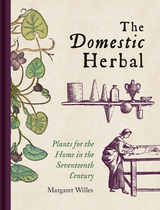 The Domestic Herbal: Plants for the Home in the Seventeenth Century
Margaret Willes
Bodleian Library Publishing, 2020 In the seventeenth century most English households had gardens. These gardens were not merely ornamental; even the most elaborate and fashionable gardens had areas set aside for growing herbs, fruit, vegetables, and flowers for domestic use. Meanwhile, more modest households considered a functional garden to be a vital tool for the survival of the house and family. The seventeenth century was also a period of exciting introductions of plants from overseas, which could be used in all manner of recipes.
Using manuscript household manuals, recipe books, and printed herbals, The Domestic Herbal takes the reader on a tour of the productive garden and of the various parts of the house—kitchens and service rooms, living rooms and bedrooms—to show how these plants were used for cooking and brewing, medicines and cosmetics, in the making and care of clothes, and to keep rooms fresh, fragrant, and decorated. Recipes used by seventeenth-century households for preparations such as flower syrups, snail water, and wormwood ale are also included. A brief herbal gives descriptions of plants both familiar and less known to today’s readers, including the herbs used for common tasks like dyeing and brewing, and those that held a particular cultural importance in the seventeenth century. Featuring exquisite colored illustrations from John Gerard’s herbal book of 1597 as well as prints, archival material, and manuscripts, this book provides an intriguing and original focus on the domestic history of Stuart England.
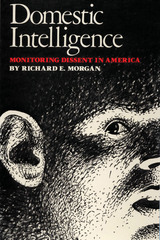 Domestic Intelligence: Monitoring Dissent in America
By Richard E. Morgan
University of Texas Press, 1980 The 1970s revealed a number of infamous and sometimes illegal practices used by federal law enforcement agencies to monitor political dissent in the United States. In the aftermath of Watergate the revelation of serious abuses created distrust of virtually all domestic intelligence operations and led to vigorous efforts at reform. Richard E. Morgan emphasizes the importance of guarding against an overreaction to the disclosures of the mid-1970s. While acknowledging the need for many of the recent reforms that seek to establish accountability, guarantee privacy, and protect dissent, he cautions against limitations on domestic intelligence gathering that could seriously hamper government's ability to prevent crime, particularly terrorism. Domestic Intelligence has several major objectives: to trace the way in which government agencies became involved with domestic intelligence gathering; to review the controversies and abuses associated with these agencies, especially the FBI, the CIA, and the NSA; to discuss the constitutionality of domestic intelligence collection; to review intelligence reforms adopted; and to suggest additional reforms. This volume is concerned with the tension between the need to protect privacy and political dissent and the need for the government to protect the community. Morgan concludes that intelligence operations aimed at anticipating criminal activity are necessary in a complex, highly vulnerable society, and that these operations can be conducted responsibly with proper guidelines and oversight mechanisms.
Domestic Interior
Stephanie Brown
University of Pittsburgh Press, 2008 The poems in Domestic Interior describe the private and sometimes secret spaces of marriage, parenthood, and knowledge.
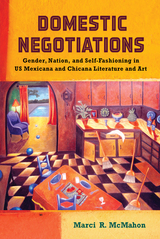 Domestic Negotiations: Gender, Nation, and Self-Fashioning in US Mexicana and Chicana Literature and Art
McMahon, Marci R
Rutgers University Press, 2013 Winner of the 2014 NACCS Tejas Non-Fiction Book Award
This interdisciplinary study explores how US Mexicana and Chicana authors and artists across different historical periods and regions use domestic space to actively claim their own histories. Through “negotiation”—a concept that accounts for artistic practices outside the duality of resistance/accommodation—and “self-fashioning,” Marci R. McMahon demonstrates how the very sites of domesticity are used to engage the many political and recurring debates about race, gender, and immigration affecting Mexicanas and Chicanas from the early twentieth century to today.
Domestic Negotiations covers a range of archival sources and cultural productions, including the self-fashioning of the “chili queens” of San Antonio, Texas, Jovita González’s romance novel Caballero, the home economics career and cookbooks of Fabiola Cabeza de Baca, Sandra Cisneros’s “purple house controversy” and her acclaimed text The House on Mango Street, Patssi Valdez’s self-fashioning and performance of domestic space in Asco and as a solo artist, Diane Rodríguez’s performance of domesticity in Hollywood television and direction of domestic roles in theater, and Alma López’s digital prints of domestic labor in Los Angeles. With intimate close readings, McMahon shows how Mexicanas and Chicanas shape domestic space to construct identities outside of gendered, racialized, and xenophobic rhetoric.
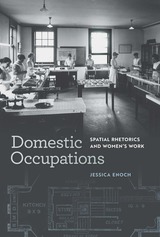 Domestic Occupations: Spatial Rhetorics and Women’s Work
Jessica Enoch
Southern Illinois University Press, 2019 This feminist rhetorical history explores women’s complex and changing relationship to the home and how that affected their entry into the workplace. Author Jessica Enoch examines the spatial rhetorics that defined the home in the mid- to late nineteenth and early twentieth centuries and considers how its construction and reconstruction—from discursive description to physical composition—has greatly shaped women’s efforts at taking on new kinds of work. In doing so, Enoch exposes the ways dominant discourses regarding women’s home life and work life—rhetorics that often assumed a white middle-class status—were complicated when differently raced, cultured, and classed women encountered them.
Enoch explores how three different groups of women workers—teachers, domestic scientists, and World War II factory employees—contended with the physical and ideological space of the home, examining how this everyday yet powerful space thwarted or enabled their financial and familial security as well as their intellectual engagements and work-related opportunities.
Domestic Occupations demonstrates a multimodal and multigenre research method for conducting spatio-rhetorical analysis that serves as a model for new kinds of thinking and new kinds of scholarship. This study adds historical depth and exigency to an important contemporary conversation in the public sphere about how women’s ties to the home inflect their access to work and professional advancement.
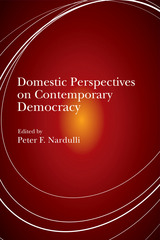 Domestic Perspectives on Contemporary Democracy
Edited by Peter F. Nardulli
University of Illinois Press, 2007 In looking at the remarkable proliferation of democracies since 1974, this volume offers important insight into the challenges and opportunities that democracy faces in the twenty-first century. Distinguished contributors detail difficulties that democracies face from within and how they deal with them. Among the contemporary threats to democracy emanating from internal sources are tensions arising over technology and its uses; ethnic, religious, and racial distinctions; and disparate access to resources, education, and employment. A democratically elected government can behave more or less democratically, even when controlling access to information, using legal authority to aid or intimidate, and applying resources to shape the conditions for the next election. With elections recently disputed in the United States, Mexico, Lebanon, and the Ukraine, debates about the future of democracy are inescapably debates about what kind of democracy is desired. Contributors are W. Lance Bennett, Bruce Bimber, Jon Fraenkel, Brian J. Gaines, Bernard Grofman, Wayne V. McIntosh, Peter F. Nardulli, Mark Q. Sawyer, Stephen Simon, Paul M. Sniderman, and Jack Snyder.
The Domestic Sources of European Foreign Policy: Defence and Enlargement
Omar Serrano
Amsterdam University Press, 2013 When it comes to formulating foreign and pan-European policies, the European Union faces myriad challenges. The Domestic Sources of European Foreign Policy is an incisive study of these difficulties and their origins. It pays particular attention to the ways internal EU debates are influenced by domestic politics and political actors who legitimize or constrain support for shared policies. Ultimately revealing whether a democratic deficit exists in EU foreign policy, this book will be required reading for scholars and policy makers interested in European affairs and international relations.
Domestic Tyranny: The Making of American Social Policy against Family Violence from Colonial Times to the Present
Elizabeth Pleck
University of Illinois Press, 2004 Elizabeth Pleck's Domestic Tyranny chronicles the rise and demise of legal, political, and medical campaigns against domestic violence from colonial times to the present. Based on in-depth research into court records, newspaper accounts, and autobiographies, this book argues that the single most consistent barrier to reform against domestic violence has been the Family Ideal--that is, ideas about family privacy, conjugal and parental rights, and family stability. This edition features a new introduction surveying the multinational and cultural themes now present in recent historical writing about family violence.
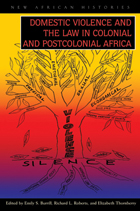 Domestic Violence and the Law in Colonial and Postcolonial Africa
Emily S. Burrill
Ohio University Press, 2010 Domestic Violence and the Law in Colonial and Postcolonial Africa reveals the ways in which domestic space and domestic relationships take on different meanings in African contexts that extend the boundaries of family obligation, kinship, and dependency. The term domestic violence encompasses kin-based violence, marriage-based violence, gender-based violence, as well as violence between patrons and clients who shared the same domestic space. As a lived experience and as a social and historical unit of analysis, domestic violence in colonial and postcolonial Africa is complex. Using evidence drawn from Sub-saharan Africa, the chapters explore the range of domestic violence in Africa’s colonial past and its present, including taxation and the insertion of the household into the broader structure of colonial domination. African histories of domestic violence demand that scholars and activists refine the terms and analyses and pay attention to the historical legacies of contemporary problems. This collection brings into conversation historical, anthropological, legal, and activist perspectives on domestic violence in Africa and fosters a deeper understanding of the problem of domestic violence, the limits of international human rights conventions, and local and regional efforts to address the issue.
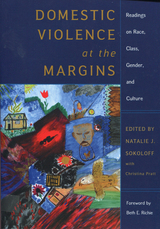 Domestic Violence at the Margins: Readings on Race, Class, Gender, and Culture
Sokoloff, Natalie J.
Rutgers University Press, 2005 "This is a thoughtful and scholarly addition to the unfortunately scarce literature on domestic violence and oppression in all its forms."—Jacquelyn C. Campbell, Anna D. Wolf Chair, Johns Hopkins University School of Nursing "An exciting and powerful collection that eloquently critiques some of the current thinking in domestic violence and raises key concerns for advocates and scholars working in the area."—Sujata Warrier, president, board of directors, Manavi: An organization for South Asian women "Sokoloff has assembled an impressive array of authors who challenge us to ‘think outside of our contemporary domestic violence box.’"—Angela M. Moore Parmley, chief, violence and victimization research division, National Institute of Justice This groundbreaking anthology reorients the field of domestic violence research by bringing long-overdue attention to the structural forms of oppression in communities marginalized by race, ethnicity, religion, sexuality, or social class. Reprints of the most influential recent work in the field as well as more than a dozen newly commissioned essays explore theoretical issues, current research, service provision, and activism among Latinos, African Americans, Asian Americans, Jewish Americans, and lesbians. The volume rejects simplistic analyses of the role of culture in domestic violence by elucidating the support systems available to battered women within different cultures, while at the same time addressing the distinct problems generated by that culture. Together, the essays pose a compelling challenge to stereotypical images of battered women that are racist, homophobic, and xenophobic. The most up-to-date and comprehensive picture of domestic violence available, this anthology is an essential text for courses in sociology, criminology, social work, and women’s studies. Beyond the classroom, it provides critical information and resources for professionals working in domestic violence services, advocacy, social work, and law enforcement.
Domestica
Samuel Piccone
University of Arkansas Press, 2026 Domestica, Samuel Piccone’s debut collection, firmly plants its feet at the fraught intersection of inheritance and the escape from it. Across these interrogative poems, the routines of marriage, parenthood, and faith reside in a place where “every garden is erased / by the thrum of impermanence.” If “silence is the earth’s way of embracing us / in whatever loneliness we think we deserve,” Piccone seeks whatever answers are held in the deepest recesses of that silence. At once aphoristic and vulnerable, these poems insist that “the stars are there to ache us into asking whatever we haven’t / brought ourselves to ask.” To startle us into paying attention to the world.
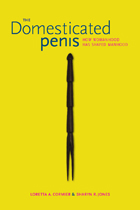 The Domesticated Penis: How Womanhood Has Shaped Manhood
Loretta A. Cormier
University of Alabama Press, 2015 Demonstrates that not only natural selection but also female choice has played a key role in shaping male anatomy
The Domesticated Penis challenges long-held assumptions that, in the development of Homo sapiens, form follows function alone. In this fascinating exploration, Loretta A. Cormier and Sharyn R. Jones explain the critical contribution that conscious female selection has made to the attributes of the modern male phallus.
Synthesizing a wealth of robust scholarship from the fields of archaeology, cultural anthropology, evolutionary theory, and primatology, the authors successfully dismantle the orthodox view that each part of the human anatomy has followed a vector of development along which only changes and mutations that increased functional utility were retained and extended. Their research animates our understanding of human morphology with insights about how choices early females made shaped the male reproductive anatomy.
In crisp and droll prose, Cormier’s and Jones’s rigorous scholarship incorporates engaging examples and lore about the human phallus in a variety of foraging, agrarian, and contemporary cultures. By detailing how female selection in mating led directly to a matrix of anatomical attributes in the male, their findings illuminate how the penis also acquired a matrix of attributes of the imagination and mythical powers—powers to be assuaged, channeled, or deployed for building productive societies.
These analyses offer a highly persuasive alternative to moribund biological and behavioral assumptions about prehistoric alpha males as well as the distortions such assumptions give rise to in contemporary popular culture. In this anthropological tour de force, Cormier and Jones transcend reductive gender stereotypes and bring to our concepts of evolutional biomechanics an invigorating new balance and nuance.
 Domesticating Brown: Movements of Racial Imagination
Christopher B. Patterson
Duke University Press, 2026 Domesticating Brown interrogates the slippery senses that brownness as a racial form has manifested over time, charting its transitions across historical colonial contexts and into the transpacific dynamics of contemporary empire. Christopher B. Patterson rethinks universalist definitions of race to consider the constant movements in racial contexts, meanings, and practices that “brownness” reveals: as a site for the ungovernable brown mass, as peoples marked for domestication through strategies of colonial containment, and as the complex shades that reveal troubling genealogies and shameful intimacies. Tracing the emergences and transformations of brownness in various contexts of transpacific encounter—from the Mongol Empire to Filipino plantation migration in Hawai’i, from the imperial management of Hong Kong to contemporary brown authorship—Domesticating Brown explores how colonial subjects and other marginalized peoples have strategized ways of resisting and reversing dominating notions of brownness through art, story, and embodied difference.
 Domesticating Brown: Movements of Racial Imagination
Christopher B. Patterson
Duke University Press, 2026 Domesticating Brown interrogates the slippery senses that brownness as a racial form has manifested over time, charting its transitions across historical colonial contexts and into the transpacific dynamics of contemporary empire. Christopher B. Patterson rethinks universalist definitions of race to consider the constant movements in racial contexts, meanings, and practices that “brownness” reveals: as a site for the ungovernable brown mass, as peoples marked for domestication through strategies of colonial containment, and as the complex shades that reveal troubling genealogies and shameful intimacies. Tracing the emergences and transformations of brownness in various contexts of transpacific encounter—from the Mongol Empire to Filipino plantation migration in Hawai’i, from the imperial management of Hong Kong to contemporary brown authorship—Domesticating Brown explores how colonial subjects and other marginalized peoples have strategized ways of resisting and reversing dominating notions of brownness through art, story, and embodied difference.
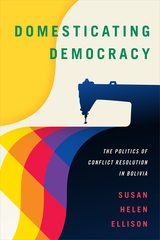 Domesticating Democracy: The Politics of Conflict Resolution in Bolivia
Susan Helen Ellison
Duke University Press, 2018 In Domesticating Democracy Susan Helen Ellison examines foreign-funded alternate dispute resolution (ADR) organizations that provide legal aid and conflict resolution to vulnerable citizens in El Alto, Bolivia. Advocates argue that these programs help residents cope with their interpersonal disputes and economic troubles while avoiding an overburdened legal system and cumbersome state bureaucracies. Ellison shows that ADR programs do more than that—they aim to change the ways Bolivians interact with the state and with global capitalism, making them into self-reliant citizens. ADR programs frequently encourage Bolivians to renounce confrontational expressions of discontent, turning away from courtrooms, physical violence, and street protest and coming to the negotiation table. Nevertheless, residents of El Alto find creative ways to take advantage of these micro-level resources while still seeking justice and a democratic system capable of redressing the structural violence and vulnerability that ADR fails to treat.
Domesticating Electricity: Technology, Uncertainty and Gender, 1880–1914
Gooday, Graeme
University of Pittsburgh Press, 2008 This is an innovative and original socio-cultural study of the history of electricity during the late Victorian and Edward periods. Gooday shows how technology, authority and gender interacted in pre-World War I Britain. The rapid take-up of electrical light and domestic appliances on both sides of the Atlantic had a wide-ranging effect on consumer habits and the division of labour within the home. Electricity was viewed by non-experts as potential threat to domestic order and welfare. This broadly interdisciplinary study relates to a website developed by the author on the history of electricity.
 Domesticating Empire: Enlightenment in Spanish America
Karen Stolley
Vanderbilt University Press, 2013 Why has the work of writers in eighteenth-century Latin America been forgotten? During the eighteenth century, enlightened thinkers in Spanish territories in the Americas engaged in lively exchanges with their counterparts in Europe and Anglo-America about a wide range of topics of mutual interest, responding in the context of increasing racial and economic diversification. Yet despite recent efforts to broaden our understanding of the global Enlightenment, the Ibero-American eighteenth century has often been overlooked.
Through the work of five authors--Jose de Oviedo y Banos, Juan Ignacio Molina, Felix de Azara, Catalina de Jesus Herrera, and Felix de Arrate--Domesticating Empire explores the Ibero-American Enlightenment as a project that reflects both key Enlightenment concerns and the particular preoccupations of Bourbon Spain and its territories in the Americas. At a crucial moment in Spain's imperial trajectory, these authors domesticate topics central to empire--conquest, Indians, nature, God, and gold--by making them familiar and utilitarian. As a result, their works later proved resistant to overarching schemes of Latin American literary history and have been largely forgotten. Nevertheless, eighteenth-century Ibero-American writing complicates narratives about both the Enlightenment and Latin American cultural identity.
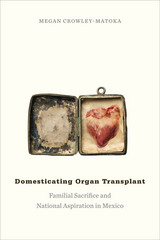 Domesticating Organ Transplant: Familial Sacrifice and National Aspiration in Mexico
Megan Crowley-Matoka
Duke University Press, 2016 Organ transplant in Mexico is overwhelmingly a family matter, utterly dependent on kidneys from living relatives—not from stranger donors typical elsewhere. Yet Mexican transplant is also a public affair that is proudly performed primarily in state-run hospitals. In Domesticating Organ Transplant, Megan Crowley-Matoka examines the intimate dynamics and complex politics of kidney transplant, drawing on extensive fieldwork with patients, families, medical professionals, and government and religious leaders in Guadalajara. Weaving together haunting stories and sometimes surprising statistics culled from hundreds of transplant cases, she offers nuanced insight into the way iconic notions about mothers, miracles, and mestizos shape how some lives are saved and others are risked through transplantation. Crowley-Matoka argues that as familial donors render transplant culturally familiar, this fraught form of medicine is deeply enabled in Mexico by its domestication as both private matter of home and proud product of the nation. Analyzing the everyday effects of transplant’s own iconic power as an intervention that exemplifies medicine’s death-defying promise and commodifying perils, Crowley-Matoka illuminates how embodied experience, clinical practice, and national identity produce one another.
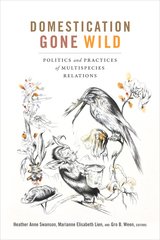 Domestication Gone Wild: Politics and Practices of Multispecies Relations
Heather Anne Swanson, Gro B. Ween, and Marianne E. Lien, editors
Duke University Press, 2018 The domestication of plants and animals is central to the familiar and now outdated story of civilization's emergence. Intertwined with colonialism and imperial expansion, the domestication narrative has informed and justified dominant and often destructive practices. Contending that domestication retains considerable value as an analytical tool, the contributors to Domestication Gone Wild reengage the concept by highlighting sites and forms of domestication occurring in unexpected and marginal sites, from Norwegian fjords and Philippine villages to British falconry cages and South African colonial townships. Challenging idioms of animal husbandry as human mastery and progress, the contributors push beyond the boundaries of farms, fences, and cages to explore how situated relations with animals and plants are linked to the politics of human difference—and, conversely, how politics are intertwined with plant and animal life. Ultimately, this volume promotes a novel, decolonizing concept of domestication that radically revises its Euro- and anthropocentric narrative.
Contributors. Inger Anneberg, Natasha Fijn, Rune Flikke, Frida Hastrup, Marianne Elisabeth Lien, Knut G. Nustad, Sara Asu Schroer, Heather Anne Swanson, Anna Lowenhaupt Tsing, Mette Vaarst, Gro B. Ween, Jon Henrik Ziegler Remme
 Domestications: American Empire, Literary Culture, and the Postcolonial Lens
Hosam Aboul-Ela
Northwestern University Press, 2018 Domestications traces a genealogy of American global engagement with the Global South since World War II. Hosam Aboul-Ela reads American writers contrapuntally against intellectuals from the Global South in their common—yet ideologically divergent—concerns with hegemony, world domination, and uneven development. Using Edward Said’s Culture and Imperialism as a model, Aboul-Ela explores the nature of U.S. imperialism’s relationship to literary culture through an exploration of five key terms from the postcolonial bibliography: novel, idea, perspective, gender, and space.
Within this framework the book examines juxtapositions including that of Paul Bowles’s Morocco with North African intellectuals’ critique of Orientalism, the global treatment of Vietnamese liberation movements with the American narrative of personal trauma in the novels of Tim O’Brien and Hollywood film, and the war on terror’s philosophical idealism with Korean and post-Arab nationalist materialist archival fiction.
Domestications departs from other recent studies of world literature in its emphases not only on U.S. imperialism but also on intellectuals working in the Global South and writing in languages other than English and French. Although rooted in comparative literature, its readings address issues of key concern to scholars in American studies, postcolonial studies, literary theory, and Middle Eastern studies.
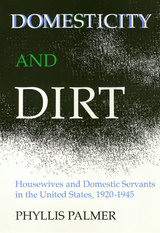 Domesticity And Dirt: Housewives and Domestic Servants in the United States, 1920-1945
Phyllis Palmer
Temple University Press, 1991
In the era after Suffrage, white middle-class housewives abandoned moves toward paid work for themselves, embraced domestic life, and felt entitled to servants. In Domesticity and Dirt, Phyllis Palmer examines the cultural norms that led such women to take on the ornamental and emotional elements of the job while relegating the hard physical work and demeaning service tasks to servants—mainly women of color. Using novels, films, magazine articles, home economics texts, and government-funded domestic training course manuals, the author details cultural expectations about middle-class homelife.
Palmer describes how government-funded education programs encouraged the divisions of labor and identity and undercut domestic workers’ organized efforts during the 1930s to win inclusion in New Deal programs regulating labor conditions. Aided by less powerful black civil rights groups, without the assistance of trade unions or women’s clubs, domestics failed to win legal protections and the legal authority and self-respect these brought to covered workers. The author also reveals how middle- class women responded ambivalently to the call to aid women workers when labor reforms threatened their domestic arrangements.
Throughout her study, Palmer questions why white middle-class women looked to new technology and domestic help to deal with cultural demands upon "the perfect housewife" rather than expecting their husbands to help. When the supply of servants declined during the 1950s, middle-class housewives were left isolated with lots of housework. Although they rapidly followed their servants into paid work outside the home, they remain responsible for housework and child care.
In the series Women in the Political Economy, edited by Ronnie J. Steinberg.
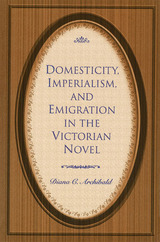 Domesticity, Imperialism, and Emigration in the Victorian Novel
Diana C. Archibald
University of Missouri Press, 2002
During the nineteenth century, as millions of British citizens left for the New Worlds, hearth and home were physically moved from the heart of the empire to its very outskirts. In Domesticity, Imperialism, and Emigration in the Victorian Novel, Diana Archibald explores how such demographic shifts affected the ways in which Victorians both promoted and undermined the ideal of the domestic woman. Drawing upon works by Elizabeth Gaskell, Anthony Trollope, Samuel Butler, Charles Dickens, Charles Reade, and William Makepeace Thackeray, the author shows how the ideals of womanhood and home promoted by domestic ideology in many ways conflict with the argument in favor of immigration to imperial destinations.
According to Coventry Patmore and John Ruskin, and some of their contemporaries, woman’s natural domain is the home, and a woman’s fulfillment lies at the hearthside. But would any hearth do as long as it was hallowed by the presence of a domestic goddess, or was this Victorian definition of home more discriminating? Although the ideal of the domestic woman was certainly affected by these mass movements, in many texts the definition of her becomes narrow and unattainable, for she must not only be an “angel,” but she must also be English and remain at home.
A rather predictable pattern emerges in almost every Victorian novel that encounters the New Worlds: if an English hero is destined for a happy ending, he either marries an English angel-wife and brings her with him to the New World or, more often, abandons thoughts of settling abroad and returns to England to marry and establish a home. This pattern seems to support the supposedly complementary ideologies of domesticity and imperialism. England, according to imperialist dogma, was the righteous center of a powerful empire whose mission was to “civilize” the rest of the world. The purpose of the domestic “angel” was to provide the moral center of a sacred space, and what is more sacred to such a scheme than English soil? A true “angel” should be English. Despite the mass migrations of the nineteenth century, home remains fundamentally English.
The literary texts, however, reveal much ambivalence toward this domestic ideal. Often the colonial and native women were seen as foils for the English “angels” because they were much more interesting and attractive. At times, domestic and imperialist ideologies themselves conflicted. Female emigrants were desperately needed in the colonies; thus, a woman’s imperial duty was to leave England. Yet her womanly duty
told her to remain an untainted idol beside an English hearthside. The domestic ideal, then, because of its firm alliance with nationalism, seems to have been more in conflict with imperialistic ideology than heretofore supposed.
domina Un/blued
Ruth Ellen Kocher
Tupelo Press, 2013 domina Un/blued dislocates the traditional slave narrative, placing the slave’s utterance within the map and chronicle of conquest. Charting a diaspora of the human spirit as well as a diaspora of an individual body, Ruth Ellen Kocher’s award-winning new book reaches beyond the story of historical involuntary servitude to explore enslavements of devotion and desire, which in extremity slide into addiction and carnal bondage.
 Dominance by Design: Technological Imperatives and America's Civilizing Mission
Michael Adas
Harvard University Press, 2006 Long before the United States became a major force in global affairs, Americans believed in their superiority over others due to their inventiveness, productivity, and economic and social well-being. U.S. expansionists assumed a mandate to “civilize” non-Western peoples by demanding submission to American technological prowess and design. As an integral part of America’s national identity and sense of itself in the world, this civilizing mission provided the rationale to displace the Indians from much of our continent, to build an island empire in the Pacific and Caribbean, and to promote unilateral—at times military—interventionism throughout Asia. In our age of “smart bombs” and mobile warfare, technological aptitude remains preeminent in validating America’s global mission.
Michael Adas brilliantly pursues the history of this mission through America's foreign relations over nearly four centuries from North America to the Philippines, Vietnam, and the Persian Gulf. The belief that it is our right and destiny to remake foreign societies in our image has endured from the early decades of colonization to our current crusade to implant American-style democracy in the Muslim Middle East.
Dominance by Design explores the critical ways in which technological superiority has undergirded the U.S.’s policies of unilateralism, preemption, and interventionism in foreign affairs and raised us from an impoverished frontier nation to a global power. Challenging the long-held assumptions and imperatives that sustain the civilizing mission, Adas gives us an essential guide to America’s past and present role in the world as well as cautionary lessons for the future.
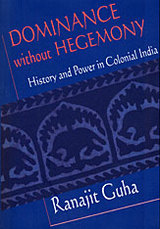 Dominance without Hegemony: History and Power in Colonial India
Ranajit Guha
Harvard University Press, 1997 What is colonialism and what is a colonial state? Ranajit Guha points out that the colonial state in South Asia was fundamentally different from the metropolitan bourgeois state which sired it. The metropolitan state was hegemonic in character, and its claim to dominance was based on a power relation in which persuasion outweighed coercion. Conversely, the colonial state was non-hegemonic, and in its structure of dominance coercion was paramount. Indeed, the originality of the South Asian colonial state lay precisely in this difference: a historical paradox, it was an autocracy set up and sustained in the East by the foremost democracy of the Western world. It was not possible for that non-hegemonic state to assimilate the civil society of the colonized to itself. Thus the colonial state, as Guha defines it in this closely argued work, was a paradox--a dominance without hegemony.
Dominance without Hegemony had a nationalist aspect as well. This arose from a structural split between the elite and subaltern domains of politics, and the consequent failure of the Indian bourgeoisie to integrate vast areas of the life and consciousness of the people into an alternative hegemony. That predicament is discussed in terms of the nationalist project of anticipating power by mobilizing the masses and producing an alternative historiography. In both endeavors the elite claimed to speak for the people constituted as a nation and sought to challenge the pretensions of an alien regime to represent the colonized. A rivalry between an aspirant to power and its incumbent, this was in essence a contest for hegemony.
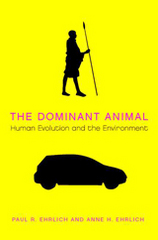 The Dominant Animal: Human Evolution and the Environment
Paul R. Ehrlich and Anne H. Ehrlich
Island Press, 2008 In humanity’s more than 100,000 year history, we have evolved from vulnerable creatures clawing sustenance from Earth to a sophisticated global society manipulating every inch of it. In short, we have become the dominant animal. Why, then, are we creating a world that threatens our own species? What can we do to change the current trajectory toward more climate change, increased famine, and epidemic disease?
Renowned Stanford scientists Paul R. Ehrlich and Anne H. Ehrlich believe that intelligently addressing those questions depends on a clear understanding of how we evolved and how and why we’re changing the planet in ways that darken our descendants’ future. The Dominant Animal arms readers with that knowledge, tracing the interplay between environmental change and genetic and cultural evolution since the dawn of humanity. In lucid and engaging prose, they describe how Homo sapiens adapted to their surroundings, eventually developing the vibrant cultures, vast scientific knowledge, and technological wizardry we know today.
But the Ehrlichs also explore the flip side of this triumphant story of innovation and conquest. As we clear forests to raise crops and build cities, lace the continents with highways, and create chemicals never before seen in nature, we may be undermining our own supremacy. The threats of environmental damage are clear from the daily headlines, but the outcome is far from destined. Humanity can again adapt—if we learn from our evolutionary past.
Those lessons are crystallized in The Dominant Animal. Tackling the fundamental challenge of the human predicament, Paul and Anne Ehrlich offer a vivid and unique exploration of our origins, our evolution, and our future.
Domination and Cultural Resistance: Authority and Power Among an Andean People
Roger Neil Rasnake
Duke University Press, 1988 Domination and Cultural Resistance examines the social life of the Yura, a Quechua-speaking Andean ethnic group of central Bolivia, and focuses especially on their indigenous authorities, the kuraqkuna or elders. Combining ethnohistorical research with contemporary fieldwork, Roger Neil Rasnake traces the evolution of leadership roles within the changing composition of the native Andean social groupings, the ayllus—from the consolidation of pre-Hispanic Aymara polities, through the pressures of the Spanish colonial regime and the increasing fragmentation of the republican era, to the present.
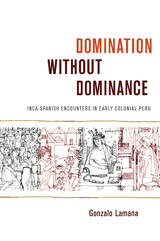 Domination without Dominance: Inca-Spanish Encounters in Early Colonial Peru
Gonzalo Lamana
Duke University Press, 2008 Offering an alternative narrative of the conquest of the Incas, Gonzalo Lamana both examines and shifts away from the colonial imprint that still permeates most accounts of the conquest. Lamana focuses on a key moment of transition: the years that bridged the first contact between Spanish conquistadores and Andean peoples in 1531 and the moment, around 1550, when a functioning colonial regime emerged. Using published accounts and array of archival sources, he focuses on questions of subalternization, meaning making, copying, and exotization, which proved crucial to both the Spaniards and the Incas. On the one hand, he re-inserts different epistemologies into the conquest narrative, making central to the plot often-dismissed, discrepant stories such as books that were expected to talk and year-long attacks that could only be launched under a full moon. On the other hand, he questions the dominant image of a clear distinction between Inca and Spaniard, showing instead that on the battlefield as much as in everyday arenas such as conversion, market exchanges, politics, and land tenure, the parties blurred into each other in repeated instances of mimicry. Lamana’s redefinition of the order of things reveals that, contrary to the conquerors’ accounts, what the Spanairds achieved was a “domination without dominance.” This conclusion undermines common ideas of Spanish (and Western) superiority. It shows that casting order as a by-product of military action rests on a pervasive fallacy: the translation of military superiority into cultural superiority. In constant dialogue with critical thinking from different disciplines and traditions, Lamana illuminates how this new interpretation of the conquest of the Incas revises current understandings of Western colonialism and the emergence of still-current global configurations.
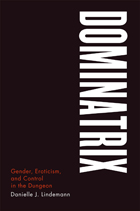 Dominatrix: Gender, Eroticism, and Control in the Dungeon
Danielle J. Lindemann
University of Chicago Press, 2012 Our lives are full of small tensions, our closest relationships full of struggle: between woman and man, artist and customer, purist and commercialist, professional and client—and between the dominant and the submissive. In Dominatrix, Danielle Lindemann draws on extensive fieldwork and interviews with professional dominatrices in New York City and San Francisco to offer a sophisticated portrait of these unusual professionals, their work, and their clients. Prior research on sex work has focused primarily on prostitutes and most studies of BDSM absorb pro-domme/client relationships without exploring what makes them unique. Lindemann satisfies our curiosity about these paid encounters, shining a light on one of the most secretive and least understood of personal relationships and unthreading a heretofore unexamined patch of our social tapestry. Upending the idea that these erotic laborers engage in simple exchanges and revealing the therapeutic and analytic nature of their work, Lindemann makes a major contribution to cultural studies, anthropology, and queer studies with her analysis of how gender, power, sexuality, and hierarchy shape all of our social experiences.
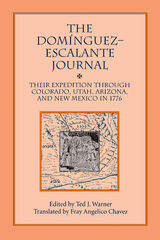 Dominguez Escalante Journal: Their Expedition Through Colorado Utah Az & N Mex 1776
Ted J. Warner
University of Utah Press, 1995 Translated by Fray Angelico Chavez, Edited by Ted J. Warner Western History The chronicle of Fray Francisco Atanasio Domínguez and Fray Silvestre Vélez de Escalante’s most remarkable 1776 expedition through the Rocky Mountains, the eastern Great Basin, and the Colorado Plateau to inventory new lands for the Spanish crown and to find a route from Santa Fe to Monterey, California.
Escalante’s journal wonderfully describes every detail of the rugged and scenic country through which they journeyed, along the qualities and customs of its inhabitants. Working as far north as present-day Provo, Utah, the expedition finally returned south. An approaching severe winter and mishaps among the maze of the Grand Canyon forced the party to return to Santa Fe by way of the Hopi pueblos.
This journal provides a fascinating account of over a thousand miles of wilderness exploration.
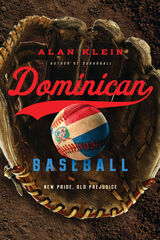 Dominican Baseball: New Pride, Old Prejudice
Alan Klein
Temple University Press, 2014 Pedro Martínez. Sammy Sosa. Manny Ramírez. By 2000, Dominican baseball players were in every Major League clubhouse, and regularly winning every baseball award. In 2002, Omar Minaya became the first Dominican general manager of a Major League team. But how did this codependent relationship between MLB and Dominican talent arise and thrive? In his incisive and engaging book, Dominican Baseball, Alan Klein examines the history of MLB's presence and influence in the Dominican Republic, the development of the booming industry and academies, and the dependence on Dominican player developers, known as buscones. He also addresses issues of identity fraud and the use of performance-enhancing drugs as hopefuls seek to play professionally. Dominican Baseball charts the trajectory of the economic flows of this transnational exchange, and the pride Dominicans feel in their growing influence in the sport. Klein also uncovers the prejudice that prompts MLB to diminish Dominican claims on legitimacy. This sharp, smartly argued book deftly chronicles the uneasy and often contested relations of the contemporary Dominican game and industry.
 Dominican Crossroads: H. C. C. Astwood and the Moral Politics of Race-Making in the Age of Emancipation
Christina Cecelia Davidson
Duke University Press, 2024 H. C. C. Astwood: minister and missionary, diplomat and politician, enigma in the annals of US history. In Dominican Crossroads, Christina Cecelia Davidson explores Astwood’s extraordinary and complicated life and career. Born in 1844 in the British Caribbean, Astwood later moved to Reconstruction-era New Orleans, where he became a Republican activist and preacher in the African Methodist Episcopal (AME) Church. In 1882 he became the first Black man named US consul to the Dominican Republic. Davidson tracks the challenges that Astwood faced as a Black politician in an era of rampant racism and ongoing cross-border debates over Black men’s capacity for citizenship. As a US representative and AME missionary, Astwood epitomized Black masculine respectability. But as Davidson shows, Astwood became a duplicitous, scheming figure who used deception and engaged in racist moral politics to command authority. His methods, Davidson demonstrates, show a bleaker side of Black international politics and illustrate the varied contours of transnational moral discourse as people of all colors vied for power during the ongoing debate over Black rights in Santo Domingo and beyond.
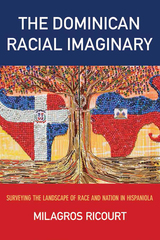 The Dominican Racial Imaginary: Surveying the Landscape of Race and Nation in Hispaniola
Ricourt, Milagros
Rutgers University Press, 2016 Honorable mention, 2017 Gordon K. and Sybil Lewis Award from the Caribbean Studies Association
This book begins with a simple question: why do so many Dominicans deny the African components of their DNA, culture, and history? Seeking answers, Milagros Ricourt uncovers a complex and often contradictory Dominican racial imaginary. Observing how Dominicans have traditionally identified in opposition to their neighbors on the island of Hispaniola—Haitians of African descent—she finds that the Dominican Republic’s social elite has long propagated a national creation myth that conceives of the Dominican as a perfect hybrid of native islanders and Spanish settlers. Yet as she pores through rare historical documents, interviews contemporary Dominicans, and recalls her own childhood memories of life on the island, Ricourt encounters persistent challenges to this myth. Through fieldwork at the Dominican-Haitian border, she gives a firsthand look at how Dominicans are resisting the official account of their national identity and instead embracing the African influence that has always been part of their cultural heritage. Building on the work of theorists ranging from Edward Said to Édouard Glissant, this book expands our understanding of how national and racial imaginaries develop, why they persist, and how they might be subverted. As it confronts Hispaniola’s dark legacies of slavery and colonial oppression, The Dominican Racial Imaginary also delivers an inspiring message on how multicultural communities might cooperate to disrupt the enduring power of white supremacy.
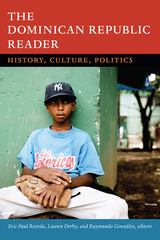 The Dominican Republic Reader: History, Culture, Politics
Eric Paul Roorda, Lauren Derby, and Raymundo González , eds.
Duke University Press, 2014 Despite its significance in the history of Spanish colonialism, the Dominican Republic is familiar to most outsiders through only a few elements of its past and culture. Non-Dominicans may be aware that the country shares the island of Hispaniola with Haiti and that it is where Christopher Columbus chose to build a colony. Some may know that the country produces talented baseball players and musicians; others that it is a prime destination for beach vacations. Little else about the Dominican Republic is common knowledge outside its borders. This Reader seeks to change that. It provides an introduction to the history, politics, and culture of the country, from precolonial times into the early twenty-first century. Among the volume's 118 selections are essays, speeches, journalism, songs, poems, legal documents, testimonials, and short stories, as well as several interviews conducted especially for this Reader. Many of the selections have been translated into English for the first time. All of them are preceded by brief introductions written by the editors. The volume's eighty-five illustrations, ten of which appear in color, include maps, paintings, and photos of architecture, statues, famous figures, and Dominicans going about their everyday lives.
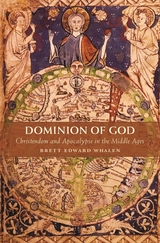 Dominion of God: Christendom and Apocalypse in the Middle Ages
Brett Edward Whalen
Harvard University Press, 2009 Brett Whalen explores the compelling belief that Christendom would spread to every corner of the earth before the end of time. During the High Middle Ages—an era of crusade, mission, and European expansion—the Western followers of Rome imagined the future conversion of Jews, Muslims, pagans, and Eastern Christians into one fold of God’s people, assembled under the authority of the Roman Church.
Starting with the eleventh-century papal reform, Whalen shows how theological readings of history, prophecies, and apocalyptic scenarios enabled medieval churchmen to project the authority of Rome over the world. Looking to Byzantium, the Islamic world, and beyond, Western Christians claimed their special place in the divine plan for salvation, whether they were battling for Jerusalem or preaching to unbelievers. For those who knew how to read the signs, history pointed toward the triumph and spread of Roman Christianity.
Yet this dream of Christendom raised troublesome questions about the problem of sin within the body of the faithful. By the late thirteenth and fourteenth centuries, radical apocalyptic thinkers numbered among the papacy’s most outspoken critics, who associated present-day ecclesiastical institutions with the evil of Antichrist—a subversive reading of the future. For such critics, the conversion of the world would happen only after the purgation of the Roman Church and a time of suffering for the true followers of God.
This engaging and beautifully written book offers an important window onto Western religious views in the past that continue to haunt modern times.
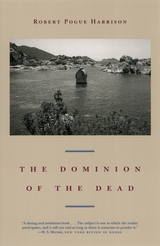 The Dominion of the Dead
Robert Pogue Harrison
University of Chicago Press, 2003 How do the living maintain relations to the dead? Why do we bury people when they die? And what is at stake when we do? In The Dominion of the Dead, Robert Pogue Harrison considers the supreme importance of these questions to Western civilization, exploring the many places where the dead cohabit the world of the living—the graves, images, literature, architecture, and monuments that house the dead in their afterlife among us.
This elegantly conceived work devotes particular attention to the practice of burial. Harrison contends that we bury our dead to humanize the lands where we build our present and imagine our future. As long as the dead are interred in graves and tombs, they never truly depart from this world, but remain, if only symbolically, among the living. Spanning a broad range of examples, from the graves of our first human ancestors to the empty tomb of the Gospels to the Vietnam Veterans Memorial, Harrison also considers the authority of predecessors in both modern and premodern societies. Through inspired readings of major writers and thinkers such as Vico, Virgil, Dante, Pater, Nietzsche, Heidegger, and Rilke, he argues that the buried dead form an essential foundation where future generations can retrieve their past, while burial grounds provide an important bedrock where past generations can preserve their legacy for the unborn.
The Dominion of the Dead is a profound meditation on how the thought of death shapes the communion of the living. A work of enormous scope, intellect, and imagination, this book will speak to all who have suffered grief and loss.
Dominoes and Other Stories from the Puerto Rican
Jack Agüeros
Northwestern University Press, 1995 Dominoes and Other Stories from the Puerto Rican, the only book of fiction by playwright and poet Jack Agüeros, affirms the triumphs and ordinary struggles of the Puerto Rican experience in New York. In stories that span the 1940s through the 1990s, Agüeros re-creates the barrio in all its multifaceted immensity, with its candy stores, plaster saints, fruit vendors, sidewalk games of dominoes, knife fights, and stories of successful craftspeople and entrepreneurs.
These stories convey hard, sometimes brutal, often bittersweet, experiences, but throughout Agüeros writes with artistry and unyielding compassion. Richly detailed, wry, and matter-of-fact, Dominoes and Other Stories from the Puerto Rican is an important achievement by an accomplished American writer.
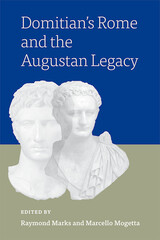 Domitian’s Rome and the Augustan Legacy
Edited by Raymond Marks and Marcello Mogetta
University of Michigan Press, 2021 The legacy of the Roman emperor Augustus and the culture of his age was profound and immediately evident after his death in 14 CE. His first four successors based their claims to rule on kinship with him, thus establishing the Julio-Claudian dynasty (14–68 CE), and plied an evolving form of the Principate, the political arrangement Augustus carved out for himself. His building and restoration programs gave the city an “Augustan” appearance that remained relatively unchanged throughout subsequent reigns. And, among literary luminaries of his age, figures such as Horace and Ovid left an indelible mark on the poetic practices of future generations while Virgil insinuated himself still more deeply into the Roman psyche. But it was after the reigns of Augustus’ own descendants, oddly enough, that we witness the most spirited and thoroughgoing engagement with the Augustan past; during the reign of the emperor Domitian, the third and last ruler of the subsequent Flavian dynasty (81–96 CE), there was a veritable Augustan renaissance. This volume represents the first book-length treatment of the reception of Augustus and his age during the reign of Domitian. Its thirteen chapters, authored by an international group of scholars, offer readers a glimpse into the fascinating history and culture of Domitian’s Rome and its multifaceted engagement with the Augustan past. Combining material and literary cultural approaches and covering a diverse range of topics—art, architecture, literature, history, law—the studies in this volume capture the rich complexity of the Augustan legacy in Domitian’s Rome while also revising our understanding of Domitian’s own legacy. Far from being the cruel tyrant history has made him out to be, Domitian emerges as a studious, thoughtful cultivator of the Augustan past who helped shape an age that not only took inspiration from that past, but managed to rival it.
Don Álvaro, or, The Force of Fate
Ángel de Saavedra
Catholic University of America Press, 2005 In this English edition designed for either classroom use or performance, Robert Fedorchek presents a readable translation faithful to the tone and spirit of the original.
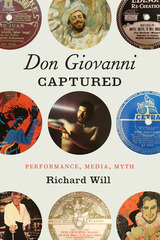 "Don Giovanni" Captured: Performance, Media, Myth
Richard Will
University of Chicago Press, 2022 “Don Giovanni” Captured considers the life of a single opera, engaging with the entire history of its recorded performance.
Mozart’s opera Don Giovanni has long inspired myths about eros and masculinity. Over time, its performance history has revealed a growing trend toward critique—an increasing effort on the part of performers and directors to highlight the violence and predatoriness of the libertine central character, alongside the suffering and resilience of his female victims.
In “Don Giovanni” Captured, Richard Will sets out to analyze more than a century’s worth of recorded performances of the opera, tracing the ways it has changed from one performance to another and from one generation to the next. Will consults audio recordings, starting with wax cylinders and 78s, as well as video recordings, including DVDs, films, and streaming videos. As Will argues, recordings and other media shape our experience of opera as much as live performance does. Seen as a historical record, opera recordings are also a potent reminder of the refusal of works such as Don Giovanni to sit still. By choosing a work with such a rich and complex tradition of interpretation, Will helps us see Don Giovanni as a standard-bearer for evolving ideas about desire and power, both on and off the stage.
 Don Gummer
Peter Plagens
The Artist Book Foundation, 2021 The trajectory of Don Gummer’s career as a sculptor began in New York City in the late 1970s with his wall reliefs of painted wood, carefully layered geometric works exhibiting a strong architectural influence. Moving beyond wood to stone, bronze, stainless steel, aluminum, and glass as his primary materials, his artworks evolved into subtly inventive freestanding sculptures, often of monumental scale, that exhibit his unfailing attention to craftsmanship and detail. The Artist Book Foundation is delighted to announce the forthcoming publication of Don Gummer, a new monograph on the artist and his highly acclaimed body of work.
Gummer was born in Louisville, Kentucky, in 1946 and grew up in Indianapolis, Indiana, where he attended the Herron School of Art and Design at Indiana University. He subsequently received both a BFA and an MFA from Yale University’s School of Fine Arts. In a 2001 interview with Peter Plagens, American artist and art critic, Gummer described his interest in sculpture as “the recontextualization of natural phenomena, of unaltered things brought into aesthetic balance by choosing and placing.” Using balance, proportion, and his unique sense of harmony, the artist is able to make durable materials seem almost buoyant. Negative space becomes an intrinsic element in his work, imparting a sense that his exquisite, seemingly permanent forms are ultimately as fleeting as any of nature’s creations would be.
The artist’s works can be found in many public collections including the Butler Institute of American Art in Youngstown, Ohio; the Massachusetts Museum of Contemporary Art in North Adams, Massachusetts; and Chase Manhattan Bank and Chemical Bank, both in New York City. He has received a number of awards from prestigious organizations such as the Louis Comfort Tiffany Foundation and the National Endowment for the Arts, and he was Visiting Artist at the American Academy in Rome. Some of his most recent sculptures appeared around Indianapolis in conjunction with his 2016 exhibition, Back Home Again.
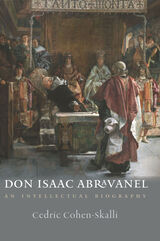 Don Isaac Abravanel: An Intellectual Biography
Cedric Cohen-Skalli
Brandeis University Press, 2020 Don Isaac Abravanel (1437–1508) was one of the great inventors of Jewish modernity. A merchant, banker, and court financier, a scholar versed in both Jewish and Christian writings, a preacher and exegete, a prominent political actor in royal entourages and Jewish communities, Abravanel was one of the greatest leaders and thinkers of Iberian Jewry in the aftermath of the expulsion of 1492. This book, the first new intellectual biography of Abravanel in twenty years, depicts his life in three cultural milieus—Portugal, Castile, and post-expulsion Italy—and analyzes his major literary accomplishments in each period. Abravanel was a traditionalist with innovative ideas, a man with one foot in the Middle Ages and the other in the Renaissance. An erudite scholar, author of a monumental exegetical opus that is still studied today, and an avid book collector, he was a transitional figure, defined by an age of contradictions. Yet, it is these very contradictions that make him such an important personality for understanding the dawn of Jewish modernity.
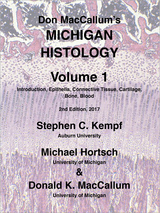 Don MacCallum's Michigan Histology Vol. 1
Stephen C. Kempf
Michigan Publishing, 2017 Before he retired, Prof. Donald K. MacCallum put together an extremely useful hands-on histology lab manual that was based on his experience of teaching histology to many generations of University of Michigan students. Unfortunately, that original digital manual was never published and is no longer compatible with today’s computer systems. The authors have updated and revised the original manual as an eBook version that allows histology learners to link the theoretical knowledge acquired in lectures and textbooks with the appearance of cellular microscopic anatomy and organ tissue structure as seen through a light microscope. Starting with a chapter on staining methods and histological artifacts, the four volumes cover the cytology of all basic tissues, organs and organ systems of the human body. Images of superb histological preparations produced by Prof. MacCallum are accompanied by a concise description. New information was added and the labeling of many images was improved to better correlate the appearance of these tissues at the light microscope level with their cellular organization and functions. Brief multiple-choice quizzes at the end of each volume reinforce major learning objectives. “Don MacCallum’s Michigan Histology” helps the beginner, as well as the more experienced student of histology, to navigate and comprehend the complexity of human tissues at the microscopic scale. As the 1st edition of Don MacCallum’s Michigan Histology eBook series was published a few years ago, we felt that updating the original edition would be a timely undertaking. In the second edition, we not only carefully revised the text to clarify it, but also corrected a number of errors. • 26 chapters covering all basic tissues and major organs/organ systems of human histology • More than 1100 high quality histological images on 724 pages • 236 image-based multiple choice review questions • Volume 1: Introduction, Epithelia, Connective Tissue, Cartilage, Bone, Blood • Volume 2: Muscle, Nervous System, Eye, Ear, Circulatory System, Lymphatic System • Volume 3: Respiratory System, Integument, Oral Glands, Oral Cavity, Gastrointestinal Tract, Liver, Gall Bladder & Pancreas • Volume 4: Endocrine Organs, Urinary System, Male Reproductive System, Female Reproductive System, Mammary Gland “Don MacCallum’s Michigan Histology” is complemented by the Michigan Histology Virtual Slide Collection, which can be accessed for free via the Internet at http://histology.sites.uofmhosting.net Volume 1 of this 4 Volume lab manual set is concerned with the Histology of human tissues. It covers Epithelia, General Connective Tissue, Cartilage, Bone and Blood with a descriptive text and pictures.
 Don MacCallum's Michigan Histology Vol. 2
Stephen C. Kempf
Michigan Publishing, 2017 Before he retired, Prof. Donald K. MacCallum put together an extremely useful hands-on histology lab manual that was based on his experience of teaching histology to many generations of University of Michigan students. Unfortunately, that original digital manual was never published and is no longer compatible with today’s computer systems. The authors have updated and revised the original manual as an eBook version that allows histology learners to link the theoretical knowledge acquired in lectures and textbooks with the appearance of cellular microscopic anatomy and organ tissue structure as seen through a light microscope. Starting with a chapter on staining methods and histological artifacts, the four volumes cover the cytology of all basic tissues, organs and organ systems of the human body. Images of superb histological preparations produced by Prof. MacCallum are accompanied by a concise description. New information was added and the labeling of many images was improved to better correlate the appearance of these tissues at the light microscope level with their cellular organization and functions. Brief multiple-choice quizzes at the end of each volume reinforce major learning objectives. “Don MacCallum’s Michigan Histology” helps the beginner, as well as the more experienced student of histology, to navigate and comprehend the complexity of human tissues at the microscopic scale. As the 1st edition of Don MacCallum’s Michigan Histology eBook series was published a few years ago, we felt that updating the original edition would be a timely undertaking. In the second edition, we not only carefully revised the text to clarify it, but also corrected a number of errors. • 26 chapters covering all basic tissues and major organs/organ systems of human histology • More than 1100 high quality histological images on 724 pages • 236 image-based multiple choice review questions • Volume 1: Introduction, Epithelia, Connective Tissue, Cartilage, Bone, Blood • Volume 2: Muscle, Nervous System, Eye, Ear, Circulatory System, Lymphatic System • Volume 3: Respiratory System, Integument, Oral Glands, Oral Cavity, Gastrointestinal Tract, Liver, Gall Bladder & Pancreas • Volume 4: Endocrine Organs, Urinary System, Male Reproductive System, Female Reproductive System, Mammary Gland “Don MacCallum’s Michigan Histology” is complemented by the Michigan Histology Virtual Slide Collection, which can be accessed for free via the Internet at http://histology.sites.uofmhosting.net Volume 2 of this 4 Volume lab manual set is concerned with the Histology of human tissues. It covers Muscle, Nervous System, Eye, Ear, Circulatory System, and Lymphatic System with a descriptive text and pictures.
 Don MacCallum's Michigan Histology Vol. 3
Stephen C. Kempf
Michigan Publishing, 2017 Before he retired, Prof. Donald K. MacCallum put together an extremely useful hands-on histology lab manual that was based on his experience of teaching histology to many generations of University of Michigan students. Unfortunately, that original digital manual was never published and is no longer compatible with today’s computer systems. The authors have updated and revised the original manual as an eBook version that allows histology learners to link the theoretical knowledge acquired in lectures and textbooks with the appearance of cellular microscopic anatomy and organ tissue structure as seen through a light microscope. Starting with a chapter on staining methods and histological artifacts, the four volumes cover the cytology of all basic tissues, organs and organ systems of the human body. Images of superb histological preparations produced by Prof. MacCallum are accompanied by a concise description. New information was added and the labeling of many images was improved to better correlate the appearance of these tissues at the light microscope level with their cellular organization and functions. Brief multiple-choice quizzes at the end of each volume reinforce major learning objectives. “Don MacCallum’s Michigan Histology” helps the beginner, as well as the more experienced student of histology, to navigate and comprehend the complexity of human tissues at the microscopic scale. As the 1st edition of Don MacCallum’s Michigan Histology eBook series was published a few years ago, we felt that updating the original edition would be a timely undertaking. In the second edition, we not only carefully revised the text to clarify it, but also corrected a number of errors. • 26 chapters covering all basic tissues and major organs/organ systems of human histology • More than 1100 high quality histological images on 724 pages • 236 image-based multiple choice review questions • Volume 1: Introduction, Epithelia, Connective Tissue, Cartilage, Bone, Blood • Volume 2: Muscle, Nervous System, Eye, Ear, Circulatory System, Lymphatic System • Volume 3: Respiratory System, Integument, Oral Glands, Oral Cavity, Gastrointestinal Tract, Liver, Gall Bladder & Pancreas • Volume 4: Endocrine Organs, Urinary System, Male Reproductive System, Female Reproductive System, Mammary Gland “Don MacCallum’s Michigan Histology” is complemented by the Michigan Histology Virtual Slide Collection, which can be accessed for free via the Internet at http://histology.sites.uofmhosting.net Volume 3 of this 4 Volume lab manual set is concerned with the Histology of human tissues. It covers Respiratory System, Integument, Oral Glands, Oral Cavity, Gastrointestinal Tract, Liver, Gall Bladder, and Pancreas with a descriptive text and pictures.
 Don MacCallum's Michigan Histology Vol. 4
Stephen C. Kempf
Michigan Publishing, 2017 Before he retired, Prof. Donald K. MacCallum put together an extremely useful hands-on histology lab manual that was based on his experience of teaching histology to many generations of University of Michigan students. Unfortunately, that original digital manual was never published and is no longer compatible with today’s computer systems. The authors have updated and revised the original manual as an eBook version that allows histology learners to link the theoretical knowledge acquired in lectures and textbooks with the appearance of cellular microscopic anatomy and organ tissue structure as seen through a light microscope. Starting with a chapter on staining methods and histological artifacts, the four volumes cover the cytology of all basic tissues, organs and organ systems of the human body. Images of superb histological preparations produced by Prof. MacCallum are accompanied by a concise description. New information was added and the labeling of many images was improved to better correlate the appearance of these tissues at the light microscope level with their cellular organization and functions. Brief multiple-choice quizzes at the end of each volume reinforce major learning objectives. “Don MacCallum’s Michigan Histology” helps the beginner, as well as the more experienced student of histology, to navigate and comprehend the complexity of human tissues at the microscopic scale. As the 1st edition of Don MacCallum’s Michigan Histology eBook series was published a few years ago, we felt that updating the original edition would be a timely undertaking. In the second edition, we not only carefully revised the text to clarify it, but also corrected a number of errors. • 26 chapters covering all basic tissues and major organs/organ systems of human histology • More than 1100 high quality histological images on 724 pages • 236 image-based multiple choice review questions • Volume 1: Introduction, Epithelia, Connective Tissue, Cartilage, Bone, Blood • Volume 2: Muscle, Nervous System, Eye, Ear, Circulatory System, Lymphatic System • Volume 3: Respiratory System, Integument, Oral Glands, Oral Cavity, Gastrointestinal Tract, Liver, Gall Bladder & Pancreas • Volume 4: Endocrine Organs, Urinary System, Male Reproductive System, Female Reproductive System, Mammary Gland “Don MacCallum’s Michigan Histology” is complemented by the Michigan Histology Virtual Slide Collection, which can be accessed for free via the Internet at http://histology.sites.uofmhosting.net Volume 4 of this 4 Volume lab manual set is concerned with the Histology of human tissues. It covers Endocrine Organs, Urinary System, Male Reproductive System, Female Reproductive System, and the Mammary Gland with a descriptive text and pictures.
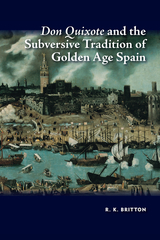 Don Quixote and the Subversive Tradition of Golden Age Spain
R.K. Britton
Sussex Academic Press, 2022 This study offers a reading of Don Quixote; to argue that thiswork was more thanjusthilariously comic entertainment. Rather, it belongs to a "subversive tradition" which constantly questioned the aims and standards of the imperial nation state that Counter-reformation Spain had become from the point of view of Renaissance humanism. In response tocensorshiprun largely by the Inquisition, writers became adept at camouflaging heterodox ideas. Ironically, Cervantes' success in avoiding the attention of the censor by concealing his criticisms beneath irony and humour was so effective that even some twentieth-century scholars have maintained Don Quixote; is a brilliantly funny book but no more.R.K. Britton draws on scholarship—including ideas on cultural authority and studies on the way Don Quixote; addresses history, truth, writing, law, and gender—and engages with the sameissues as Cervantes did.
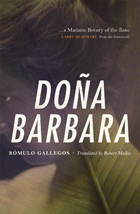 Doña Barbara: A Novel
Rómulo Gallegos
University of Chicago Press, 2012 Rómulo Gallegos is best known for being Venezuela’s first democratically elected president. But in his native land he is equally famous as a writer responsible for one of Venezuela’s literary treasures, the novel Doña Barbara. Published in 1929 and all but forgotten by Anglophone readers, Doña Barbara is one of the first examples of magical realism, laying the groundwork for later authors such as Gabriel García Márquez and Mario Vargas Llosa.
Following the epic struggle between two cousins for an estate in Venezuela, Doña Barbara is an examination of the conflict between town and country, violence and intellect, male and female. Doña Barbara is a beautiful and mysterious woman—rumored to be a witch—with a ferocious power over men. When her cousin Santos Luzardo returns to the plains in order to reclaim his land and cattle, he reluctantly faces off against Doña Barbara, and their battle becomes simultaneously one of violence and seduction. All of the action is set against the stunning backdrop of the Venezuelan prairie, described in loving detail. Gallegos’s plains are filled with dangerous ranchers, intrepid cowboys, and damsels in distress, all broadly and vividly drawn. A masterful novel with an important role in the inception of magical realism, Doña Barbara is a suspenseful tale that blends fantasy, adventure, and romance.
Hailed as “the Bovary of the llano” by Larry McMurtry in his new foreword to this book, Doña Barbarais a magnetic and memorable heroine, who has inspired numerous adaptations on the big and small screens, including a recent television show that aired on Telemundo.
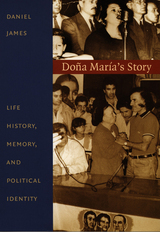 Doña María's Story: Life History, Memory, and Political Identity
Daniel James
Duke University Press, 2000 In this remarkable book historian Daniel James presents the gripping, poignant life-story of Doña María Roldán, a woman who lived and worked for six decades in the meatpacking community of Berisso, Argentina. A union activist and fervent supporter of Juan and Eva Perón, Doña María’s evocative testimony prompts James to analyze the promise and problematic nature of using oral sources for historical research. The book thus becomes both fascinating narrative and methodological inquiry.
Doña María’s testimony is grounded in both the local context (based on the author’s thirteen years of historical and ethnographic research in Berisso) and a broader national narrative. In this way, it differs from the dominant genre of women’s testimonial literature, and much recent ethnographic work in Latin America, which have often neglected historical and communal contextualization in order to celebrate individual agency and self-construction. James examines in particular the ways that gender influences Doña María’s representation of her story. He is careful to acknowledge that oral history challenges the historian to sort through complicated sets of motivations and desires—the historian’s own wish to uncover “the truth” of an informant’s life and the interviewee’s hope to make sense of her or his past and encode it with myths of the self. This work is thus James’s effort to present his research and his relationship with Doña María with both theoretical sophistication and recognition of their mutual affection.
While written by a historian, Doña María’s Story also engages with concerns drawn from such disciplines as anthropology, cultural studies, and literary criticism. It will be especially appreciated by those involved in oral, Latin American, and working-class history.
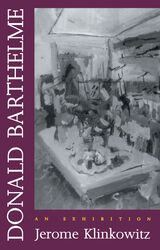 Donald Barthelme: An Exhibition
Jerome Klinkowitz
Duke University Press, 1991 Donald Barthelme (1931–1989) is regarded as one of the most imitated and influential American fiction writers since the early 1960s. In Donald Barthelme: An Exhibition, Jerome Klinkowitz presents both an appreciation and a comprehensive examination of the life work of this pathbreaking contemporary writer. A blend of close reading, biography, and theory, this retrospective—informed by Klinkowitz’s expert command of postmodern American fiction—contributes significantly to a new understanding of Barthelme’s work.
Klinkowitz argues that the central piece in the Barthelme canon, and the key to his artistic method, is his widely acknowledged masterpiece, The Dead Father. In turning to this pivotal work, as well as to Barthelme’s short stories and other novels, Klinkowitz explores the way in which Barthelme reinvented the tools of narration, characterization, and thematics at a time when fictive techniques were largely believed to be exhausted.
Klinkowitz, who was one of the first scholars to study Barthelme’s work and became its definitive bibliographer, situates Barthelme’s life and work within a broad spectrum of influences and affinities. A consideration of developments in painting and sculpture, for example, as well as those of contemporaneous fiction, contribute to Klinkowitz’s analysis. This astute reading will provide great insight for readers, writers, and critics of contemporary American fiction seeking explanations and justifications of Barthelme’s critical importance in the literature of our times.
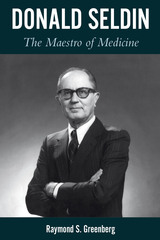 Donald Seldin: The Maestro of Medicine
By Raymond S. Greenberg
University of Texas Press, 2020 No one would have blamed Donald Seldin for running away. When he arrived at Southwestern Medical College in 1951, it was a collection of hastily repurposed military shacks creaking in the wind. On practically day one he became chair of the department of medicine—when the only other full-time professors departed. By the time he stepped down thirty-six years later, Seldin had transformed a sleepy medical college into the University of Texas Southwestern Medical Center—a powerhouse of research and patient care and an anchor of the city of Dallas. Raymond Greenberg, a physician-scholar, tells Seldin's story of perseverance and intellectual triumph. Drawing on interviews with Seldin's trainees and colleagues—and on Seldin's own words—Greenberg chronicles the life of the Brooklyn boy who became one of Texas's foremost citizens and taught decades of men and women to heal. A pioneering nephrologist, Seldin devoted his career to developing the specialty; educating students, residents, and fellows; caring for patients; and nurturing basic research. Seldin was a wildcatter in the best sense. He declined the comfortable prestige of Harvard and Yale and instead embraced a worthy challenge with an unflagging sense of mission. Graceful and richly detailed, The Maestro of Medicine captures an inspiring life of achievement and service.
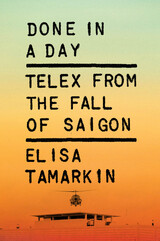 Done in a Day: Telex from the Fall of Saigon
Elisa Tamarkin
University of Chicago Press A searing reflection on the last day of the Vietnam War and the beginning of the end of foreign reporting in the nation’s daily newspapers.
Done in a Day turns on a single event: the April 30, 1975, departure of the last helicopter evacuating civilians from the rooftop of the US embassy in Saigon. Elisa Tamarkin’s interest in that helicopter begins with the fact that her stepfather, the Saigon bureau chief for the Chicago Daily News, was on it—the last American correspondent to leave Saigon as it fell. His report was filed from a naval ship on the South China Sea at a time when no other telexes were going through.
Now, fifty years later, Tamarkin offers a social and cultural autopsy of that moment, based in personal history but vividly unfolding amid the vast documentation of America’s obvious defeat, which never seemed to register even as it got out, in the writings of journalists and essayists, in the backchannel cables between US ambassador Graham Martin and Henry Kissinger, in congressional hearings, and in photographs of the war’s end. The story is also set against the imminent disappearance of war coverage in city newspapers—and of the newspapers themselves—once proud, in the words of the Chicago Daily News, for bringing readers the “literature of the day” that was “done in a day.”
Done in a Day braids history, criticism, and memoir to tell the paired stories of Saigon’s liberation and the demise of the news. The result is a haunting essay about all that ended in a day—and about what it means to recognize and to write about endings even as we live through them.
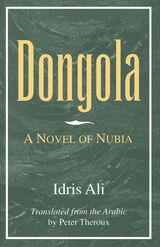 Dongola: A Novel of Nubia
Idris Ali
University of Arkansas Press, 1998 The University of Arkansas Press Award for Arabic Literature in Translation, 1997 In this, the first Nubian novel ever translated, Awad Shalali, a Nubian worker in modern Egypt, dreams of Dongola—the capital of medieval Nubia, now lost to the flood waters of the Aswan High Dam. In Dongola, the Nubians reached their zenith. They defeated and dominated Upper Egypt, and their archers, deadly accurate in battle, were renowned as “the bowman of the glance. Helima, Awad’s wife, must deal with the reality of today’s Nubia, a poverty-stricken bottomland. Men like Awad now work in Cairo for good wages while the women remain at home in squalor, dominated by the Islam of their conquerors and ignorant of the glory now covered by the Nile’s water. Left to tend Awad’s sick mother and his dying country, Halima grows despondent and learns the truths behind the Upper Egyptian lyric: “Time, you are a traitor—what have you done with my love? Through his characters’ pain and suffering, Idris Ali paints in vibrant detail, with wit and a keen sense of history’s absurdities, the story of cultures and hearts divided, of lost lands, impossible dreams, and abandoned lives.
The Donigers of Great Neck: A Mythologized Memoir
Wendy Doniger
Brandeis University Press, 2019 “Many memories, many myths”—this is how Wendy Doniger begins the story of her parents’ origins in Europe and sharply bifurcated life in America. Recalling their contrasting attitudes toward Judaism and religion in general—and acknowledging the mythologized narratives that keep bubbling up in those recollections—Doniger tells the story of their childhoods, their unusual marriage, their life in the post–World War II Jewish enclave of Great Neck, New York, and her own complex relationship with each of them.
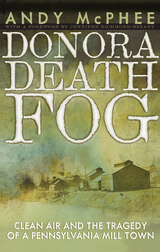 The Donora Death Fog: Clean Air and the Tragedy of a Pennsylvania Mill Town
Andy McPhee
University of Pittsburgh Press, 2021 In October 1948, a seemingly average fog descended on the tiny mill town of Donora, Pennsylvania. With a population of fewer than fifteen thousand, the town’s main industry was steel and zinc mills—mills that continually emitted pollutants into the air. The six-day smog event left twenty-one people dead and thousands sick. Even after the fog lifted, hundreds more died or were left with lingering health problems. Donora Death Fog details how six fateful days in Donora led to the nation’s first clean air act in 1955, and how such catastrophes can lead to successful policy change. Andy McPhee tells the very human story behind this ecological disaster: how wealthy industrialists built the mills to supply an ever-growing America; how the town’s residents—millworkers and their families—willfully ignored the danger of the mills’ emissions; and how the gradual closing of the mills over the years following the tragedy took its toll on the town.
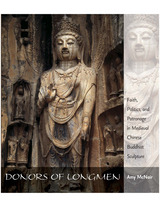 Donors of Longmen: Faith, Politics, and Patronage in Medieval Chinese Buddhist Sculpture
Amy McNair
University of Hawaii Press, 2007 Donors of Longmen is the first work in the west to recreate the history of the Longmen Grottoes, a UNESCO World Heritage site, where thousands of ancient cave-chapels and shrines containing Buddhist icons of all sizes were carved into the towering limestone cliffs from the fifth to the eighth century. Beyond its superb sculpture, Longmen also preserves thousands of engraved dedicatory inscriptions by its donors, who included emperors and empresses, aristocrats, court eunuchs, artisans, monks, nuns, lay societies, female palace officials, male civil and military officials and ordinary lay believers. These inscriptions preserve the voices of self-willed women, charismatic religious people, wealthy merchants and palace eunuchs – all traditionally excluded from history – and since they and the sculpture they dedicate are artifacts of actual religious practice, they offer tangible proof of what their sponsors worshiped and why.
Donors of Longmen explores the dynamics of faith, politics and money. Believers sponsored statues and cave-shrines as public acts of giving (dāna) and merit (karma) to generate social credit in the political realm and karmic merit in the spiritual. While donors’ choices of icons reveal the changes in Buddhist religious concerns over the 250-year life of the site, the discussions of expenditure in their dedicatory inscriptions reveal not only how much they spent, but also the rhetoric appropriate to their station in life, gender and intended audience. The author argues that donors made conscious decisions concerning the style of their sculptures to imbue them with meanings that were immediately comprehensible to their contemporaries, and these choices constitute a lively interplay between native Chinese imagery and icons and styles of art from the Buddhist holy land of India.
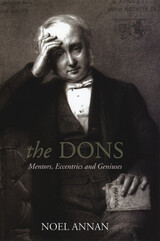 The Dons: Mentors, Eccentrics and Geniuses
Noel Annan
University of Chicago Press, 1999 For two hundred years Oxford and Cambridge Universities were home to some of Britain's greatest teachers and intellects, each forming the minds of the passing generations of students and influencing the thinking and practice of university learning throughout the country and the world.
In this entertaining, informative book, Noel Annan is at his incisive best. Displaying his customary mastery of his subject, he describes the great dons in all their glory and eccentricities: who they were, what they were like, why they mattered, and what their legacy is. Written with love and wisdom, the great minds of the past—figures such as John Henry Newman, John Sparrrow, and Isaiah Berlin—are brought alive. In addition, Annan's often quoted article "The Intellectual Aristocracy" is included in this book.
No other work has ever explained so precisely and so intimately the significance of the dons and their important role in shaping higher education—at a time when the nature of learning is ever more the subject of dissension and uncertainty.
"With a charming mixture of analyses and anecdotes, Annan builds up a picture of the changing Oxbridge scene that keeps a reader's imagination. . . . [T]he comical-satirical narrative of which he was a master is a joy to read, and The Dons will deservedly be enjoyed as a bedside book by those who treasure English eccentricity."—Stephen Toulmin, Los Angeles Times Book Review
"[A]n affectionate elegy for a class that has largely expired."—Robert Fulford, National & Financial Post
"[A] wonderfully gifted and energetic writer. . . . Noel was one of the few figures in English public life known simply by his first name. There was no mistaking him for anyone else."—Jonathan Mirsky, New Yorker
"A sparkling collection of essays."—Michael Davie, Times Literary Supplement
"[A] highly affectionate . . . look at some of the more remarkable academic personages to distinguish-and sometimes dumbfound-Oxford and Cambridge over the last two centuries. . . . For all that it cherishes eccentricity and abounds in Oxbridge gossip, The Dons is at heart a deeply serious book, one dedicated to a conception of learning and culture that is at once increasingly rare . . . yet very far from being outmoded."—Mark Feeney, Boston Globe
"Annan writes elegantly and winningly throughout his book. . . . Leaving arguably the best for last, Annan ends The Dons with a reprinting of his celebrated essay 'The Intellectual Aristocracy,' . . . [B]oth a dazzling tour de force and a clever jeu d'esprit."—Michael Dirda, Washington Post Book World
"A witty, erudite, insider account-exactly what one would expect from the best of their type."—Andrew Lycett, Sunday Times
 Don't: A Reader's Guide to the Military's Anti-Gay Policy
Janet E. Halley
Duke University Press, 1999 In Don’t Janet E. Halley explains how the military's new anti-gay policy is fundamentally misdescribed by its common nickname, “Don't Ask/Don't Tell.” This ubiquitous phrase, she points out, implies that it discharges servicemembers not for who they are, but for what they do. It insinuates that, as long as military personnel keep quiet about their homosexual orientation and desist from “homosexual conduct,” no one will try to pry them out of their closets and all will be well.
Not so, reveals Halley. In order to work through the steps by which the new law was ultimately drafted, she opens with a close reading of the 1986 Supreme Court sodomy case which served as the legal and rhetorical model for the policy revisions made in 1993. Halley also describes how the Clinton administration’s attempts to offer Congress an opportunity to regulate conduct—and not status—were flatly rejected and not included in the final statute. Using cultural and critical theory seldom applied to explain the law, Halley argues that, far from providing privacy and an assurance that servicemembers' careers will be ruined only if they engage in illegal conduct, the rule activates a culture of minute surveillance in which every member must strictly avoid using any gesture in an ever-evolving lexicon of “conduct that manifests a propensity.” In other words, not only homosexuals but all military personnel are placed in danger by the new policy. After challenging previous pro-gay arguments against the policy that have failed to expose its most devious and dangerous elements, Halley ends with a persuasive discussion about how it is both unconstitutional and, politically, an act of sustained bad faith.
This knowledgeable and eye-opening analysis of one of the most important public policy debates of the 1990s will interest legal scholars, policymakers, activists, military historians and personnel, as well as citizens concerned about issues of discrimination.
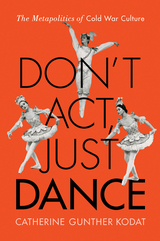 Don't Act, Just Dance: The Metapolitics of Cold War Culture
Catherine Gunther Kodat
Rutgers University Press, 2014 At some point in their career, nearly all the dancers who worked with George Balanchine were told “don’t act, dear; just dance.” The dancers understood this as a warning against melodramatic over-interpretation and an assurance that they had all the tools they needed to do justice to the steps—but its implication that to dance is already to act in a manner both complete and sufficient resonates beyond stage and studio.
Drawing on fresh archival material, Don’t Act, Just Dance places dance at the center of the story of the relationship between Cold War art and politics. Catherine Gunther Kodat takes Balanchine’s catch phrase as an invitation to explore the politics of Cold War culture—in particular, to examine the assumptions underlying the role of “apolitical” modernism in U.S. cultural diplomacy. Through close, theoretically informed readings of selected important works—Marianne Moore’s “Combat Cultural,” dances by George Balanchine, Merce Cunningham, and Yuri Grigorovich, Stanley Kubrick’s Spartacus, and John Adams’s Nixon in China—Kodat questions several commonly-held beliefs about the purpose and meaning of modernist cultural productions during the Cold War.
Rather than read the dance through a received understanding of Cold War culture, Don’t Act, Just Dance reads Cold War culture through the dance, and in doing so establishes a new understanding of the politics of modernism in the arts of the period.
Don't Ask
Philip Levine
University of Michigan Press, 1981 Interviews with the poet Philip Levine on the subject of his poetry
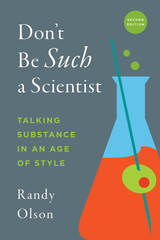 Don't Be Such a Scientist, Second Edition: Talking Substance in an Age of Style
Randy Olson
Island Press, 2018 When Randy Olson first described his life-changing encounter with an acting teacher in Don’t Be Such a Scientist, it seemed like the world of science was on the cusp of gaining new respect in the public eye. Through his writing, speaking, and films, Olson challenged scientists to toss out jargon in favor of a more human approach, bringing Hollywood lessons to the scientific community. Yet today, in everything from government funding cuts to climate change denial, science is under attack. And while communicating science is more crucial than ever, the scientific community still struggles to connect with everyday people.
The time is right for a new edition of Olson’s revolutionary work. In Don’t Be Such a Scientist, Second Edition, Olson renews his call for communication that stays true to the facts while tapping into something more primordial, more irrational, and ultimately more human. In more than 50 pages of new material, Olson brings his pioneering message to this new age, providing tools for speaking out in anti-science era and squaring off against members of the scientific establishment who resist needed change.
Don’t Be Such a Scientist, Second Edition is a cutting and irreverent manual to making your voice heard in an age of attacks on science. Invaluable for anyone looking to break out of the boxes of academia or research, Olson’s writing will inspire readers to “make science human”—and to enjoy the ride along the way.
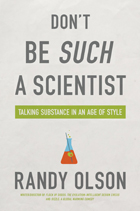 Don't Be Such a Scientist: Talking Substance in an Age of Style
Randy Olson
Island Press, 2009 "You think too much! You mother F@$#%&* think too much! You're nothing but an arrogant, pointy-headed intellectual — I want you out of my classroom and off the premises in five minutes or I'm calling the police and having you arrested for trespassing." — Hollywood acting teacher to Randy Olson, former scientist
After nearly a decade on the defensive, the world of science is about to be restored to its rightful place. But is the American public really ready for science? And is the world of science ready for the American public?
Scientists wear ragged clothes, forget to comb their hair, and speak in a language that even they don't understand. Or so people think. Most scientists don't care how they are perceived, but in our media-dominated age, style points count.
Enter Randy Olson. Fifteen years ago, Olson bid farewell to the science world and shipped off to Hollywood ready to change the world. With films like Flock of Dodos: The Evolution-Intelligent Design Circus (Tribeca '06, Showtime) and Sizzle: A Global Warming Comedy (Outfest '08), he has tried to bridge the cultural divide that has too often left science on the outside looking in.
Now, in his first book, Olson, with a Harvard Ph.D. and formerly a tenured professor of marine biology at the University of New Hampshire, recounts the lessons from his own hilarious-and at times humiliating-evolution from science professor to Hollywood filmmaker. In Don't Be Such a Scientist, he shares the secrets of talking substance in an age of style. The key, he argues, is to stay true to the facts while tapping into something more primordial, more irrational, and ultimately more human.
In a book enlivened by a profane acting teacher who made Olson realize that "nobody wants to watch you think," he offers up serious insights and poignant stories. You'll laugh, you may cry, and as a communicator you'll certainly learn the importance of not only knowing how to fulfill, but also how to arouse.
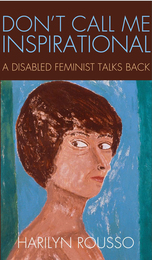 Don't Call Me Inspirational: A Disabled Feminist Talks Back
Harilyn Rousso
Temple University Press, 2013 For psychotherapist, painter, feminist, filmmaker, writer, and disability activist Harilyn Rousso, hearing well-intentioned people tell her, "You're so inspirational!" is patronizing, not complimentary. In her empowering and at times confrontational memoir, Don't Call Me Inspirational, Rousso, who has cerebral palsy, describes overcoming the prejudice against disability--not overcoming disability. She addresses the often absurd and ignorant attitudes of strangers, friends, and family. Rousso also examines her own prejudice toward her disabled body, and portrays the healing effects of intimacy and creativity, as well as her involvement with the disability rights community. She intimately reveals herself with honesty and humor and measures her personal growth as she goes from "passing" to embracing and claiming her disability as a source of pride, positive identity, and rebellion. A collage of images about her life, rather than a formal portrait, Don't Call Me Inspirational celebrates Rousso's wise, witty, productive, outrageous life, disability and all.
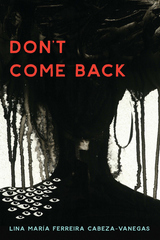 Don’t Come Back
Lina María Ferreira Cabeza-Vanegas
Ohio State University Press, 2017 In this collection of linked lyrical and narrative essays, experimental translations, and reinterpreted myths, Lina Maria Ferreira Cabeza-Vanegas launches into an exploration of home and identity, family history and belonging, continually examining what it means to feel familiarity but never really feel at home.
Don’t Come Back intermixes translations of Spanish adages and adaptations of major Colombian myths with personal essays about growing up amidst violence, magic, and an unyielding Andean sun. Home is place and time and people and language and history, and none of these are ever set in stone. Attempting to reconcile the irreconcilable and translate the untranslatable—to move smoothly and cohesively between culture, language, and place—Ferreira Cabeza-Vanegas is torn between spaces, between the aunt who begs her to return to Colombia and the mother who tells her, “There’s nothing here for you, Lina. Don’t come back.” Don’t Come Back is an exploration of home and identity that constantly asks, “If you really could go back, would you?”
Don't Forget to Live: Goethe and the Tradition of Spiritual Exercises
Pierre Hadot
University of Chicago Press, 2023 The esteemed French philosopher Pierre Hadot’s final work, now available in English.
With a foreword by Arnold I. Davidson and Daniele Lorenzini.
In his final book, renowned philosopher Pierre Hadot explores Goethe’s relationship with ancient spiritual exercises—transformative acts of intellect, imagination, or will. Goethe sought both an intense experience of the present moment as well as a kind of cosmic consciousness, both of which are rooted in ancient philosophical practices. These practices shaped Goethe’s audacious contrast to the traditional maxim memento mori (Don’t forget that you will die) with the aim of transforming our ordinary consciousness. Ultimately, Hadot reveals how Goethe cultivated a deep love for life that brings to the forefront a new maxim: Don’t forget to live.
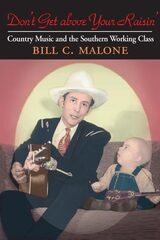 Don't Get above Your Raisin': Country Music and the Southern Working Class
Bill C. Malone
University of Illinois Press, 2002 Combining a high-spirited history of country music's roots with vivid portraits of its principal performers, Don't Get above Your Raisin' examines the close relationship between "America's truest music" and the working-class culture that has constituted its principal source, nurtured its development, and provided its most dedicated supporters.
Widely recognized as country music's ranking senior authority, Bill C. Malone explores how the music's defining themes (home and family, religion, rambling, frolic, humor, and politics) have emerged out of the particularities of working people's day-to-day lives. He traces the many contradictory voices and messages of a music that simultaneously extols the virtues of home and the joys of rambling, the assurances of the Christian life and the ecstasies of hedonism, the strength of working-class life and the material lure of middle-class aspirations. The resulting tensions, Malone argues, are a principal source of the music's enduring appeal.
Country musicians have often been people from undistinguished blue-collar backgrounds who have tried to make their way as entertainers in a society that has little respect for the working class. From this ambivalent position, they have voiced the sometimes contradictory values and longings of their culture while also attempting to fulfill the romantic expectations of outsiders.
"For every Garth Brooks," Malone says, "there are a thousand country musicians who perform in local bars, taverns, and American Legion halls and who have never been able to ‘give up their day jobs.' These are musicians whose middle-class dreams are tempered by working-class realities." A powerful and honest expression of the hopes, longings, frailties, and failings of ordinary people, country music increasingly resonates with listeners beyond its core constituency as they struggle with a complex and uncertain world.
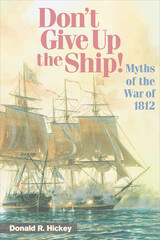 Don't Give Up the Ship!: Myths of the War of 1812
Donald R. Hickey
University of Illinois Press, 2006 No longer willing to accept naval blockades, the impressment of American seamen, and seizures of American ships and cargos, the United States declared war on Great Britain. The aim was to frighten Britain into concessions and, if that failed, to bring the war to a swift conclusion with a quick strike at Canada. But the British refused to cave in to American demands, the Canadian campaign ended in disaster, and the U.S. government had to flee Washington, D.C., when it was invaded and burned by a British army. By all objective measures, the War of 1812 was a debacle for the young republic, and yet it was celebrated as a great military triumph. The American people believed they had won the war and expelled the invader. Oliver H. Perry became a military hero, Francis Scott Key composed what became the national anthem and commenced a national reverence for the flag, and the U.S.S. Constitution, "Old Ironsides," became a symbol of American invincibility. Every aspect of the war, from its causes to its conclusion, was refashioned to heighten the successes, obscure the mistakes, and blur embarrassing distinctions, long before there were mass media or public relations officers in the Pentagon. In this entertaining and meticulously researched book by America's leading authority on the War of 1812, Donald R. Hickey dispels the many misconcep-tions that distort our view of America's second war with Great Britain. Embracing military, naval, political, economic, and diplomatic analyses, Hickey looks carefully at how the war was fought between 1812 and 1815, and how it was remembered thereafter. Was the original declaration of war a bluff? What were the real roles of Canadian traitor Joseph Willcocks, Mohawk leader John Norton, pirate Jean Laffite, and American naval hero Lucy Baker? Who killed the Shawnee chief Tecumseh and who shot the British general Isaac Brock? Who actually won the war, and what is its lasting legacy? Hickey peels away fantasies and embellishments to explore why cer-tain myths gained currency and how they contributed to the way that the United States and Canada view themselves and each other.
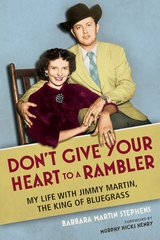 Don't Give Your Heart to a Rambler: My Life with Jimmy Martin, the King of Bluegrass
Barbara Stephens
University of Illinois Press, 2017 As charismatic and gifted as he was volatile, Jimmy Martin recorded dozens of bluegrass classics and co-invented the high lonesome sound. Barbara Martin Stephens became involved with the King of Bluegrass at age seventeen. Don't Give your Heart to a Rambler tells the story of their often tumultuous life together. Barbara bore his children and took on a crucial job as his booking agent when the agent he was using failed to obtain show dates for the group. Female booking agents were non-existent at that time but she persevered and went on to become the first female booking agent on Music Row. She also endured years of physical and emotional abuse at Martin's hands. With courage and candor, Barbara tells of the suffering and traces the hard-won personal growth she found inside motherhood and her work. Her vivid account of Martin's explosive personality and torment over his exclusion from the Grand Ole Opry fill in the missing details on a career renowned for being stormy. Barbara also shares her own journey, one of good humor and proud achievements, and filled with fond and funny recollections of the music legends and ordinary people she met, befriended, and represented along the way. Straightforward and honest, Don't Give your Heart to a Rambler is a woman's story of the world of bluegrass and one of its most colorful, conflicted artists.
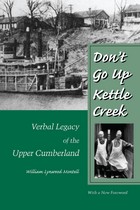 Don't Go Up Kettle Creek: Verbal Legacy of the Upper Cumberland
William Lynwood Montell
University of Tennessee Press, 2000 Don’t Go Up Kettle Creek is a historical portrayal of a river and the people who made their living along its banks and tributaries. Drawing upon the personal recollections and oral traditions of longtime residents, William Lynwood Montell describes a century and a half of life in the Upper Cumberland.
Montell organized his material according to the topics that dominated his tape-recorded conversations with residents of the area-farming, logging and rafting, steamboating, the Civil War-topics that the people themselves saw as important in their history. In reconstructing the past, the author also illuminates the relationship between geographic and economic factors in the region; the prolonged affects of a cataclysmic event, the Civil War, on the isolated area; and the impact of modernization, in the form of “hard” roads and cheap, TVA-supplied electricity, on the traditional ways of people.
First published in 1983, this book is now available in paperback for the first time. Included with this edition is a new foreword in which Montell and Mary Robbins, executive director of the Tennessee Upper Cumberland Tourism Association, describe changes in the area that have occured since the book’s initial appearance.
The Author: William Lynwood Montell, now retired, was coordinator of programs in folk and interculturual studies at Western Kentucky University. His numerous books include Ghosts along the Cumberland and The Saga of Coe Ridge.
 Don't Kill in Our Names: Families of Murder Victims Speak Out against the Death Penalty
King, Rachel
Rutgers University Press, 2003 Could you forgive the murderer of your husband? Your mother? Your son?
Families of murder victims are often ardent and very public supporters of the death penalty. But the people whose stories appear in this book have chosen instead to forgive their loved ones’ murderers, and many have developed personal relationships with the killers and have even worked to save their lives. They have formed a nationwide group, Murder Victims’ Families for Reconciliation (MVFR), to oppose the death penalty.
MVFR members are often treated as either saints or lunatics, but the truth is that they are neither. They are ordinary people who have responded to an extraordinary and devastating tragedy with courage and faith, choosing reconciliation over retribution, healing over hatred. Believing that the death penalty is a form of social violence that only repeats and perpetuates the violence that claimed their loved one’s lives, they hold out the hope of redemption even for those who have committed the most hideous crimes. Weaving third-person narrative with wrenching first-hand accounts, King presents the stories of ten MVFR members. Each is a heartrending tale of grief, soul searching, and of the challenge to choose forgiveness instead of revenge. These stories, which King sets in the context of the national discussion over the death penalty debate and restorative versus retributive justice, will appeal not only to those who oppose the death penalty, but also to those who strive to understand how people can forgive the seemingly unforgivable.
Don’t Kill Your Baby: Public Health and the Decline of Breastfeeding in the Nineteenth and Twentieth Centuries
Jacqueline H. Wolf
Ohio State University Press, 2001 How did breastfeeding—once accepted as the essence of motherhood and essential to the well-being of infants—come to be viewed with distaste and mistrust? Why did mothers come to choose artificial food over human milk, despite the health risks? In this history of infant feeding, Jacqueline H. Wolf focuses on turn-of-the-century Chicago as a microcosm of the urbanizing United States. She explores how economic pressures, class conflict, and changing views of medicine, marriage, efficiency, self-control, and nature prompted increasing numbers of women and, eventually, doctors to doubt the efficacy and propriety of breastfeeding. Examining the interactions among women, dairies, and health care providers, Wolf uncovers the origins of contemporary attitudes toward and myths about breastfeeding.
Don't Leave Hungry: Fifty Years of Southern Poetry Review
James Smith
University of Arkansas Press, 2009 This substantial anthology charts the development of this influential journal decade by decade, making clear that although it has close ties to a particular region, it has consistently maintained a national scope, publishing poets from all over the United States. SPR’s goal has been to celebrate the poem above all, so although there are poems by major poets here, there are many gems by less famous, perhaps even obscure, writers too. Here are 183 poems by nearly as many poets, from A. R. Ammons, Kathryn Stripling Byer, James Dickey, Mark Doty, Claudia Emerson, David Ignatow, and Carolyn Kizer to Ted Kooser, Maxine Kumin, Denise Levertov, Howard Nemerov, Sharon Olds, Linda Pastan, and Charles Wright.
 Don't Let the Fire Go Out!
Jean Carnahan
University of Missouri Press, 2004
The slogan Don’t Let the Fire Go Out! became the guiding force for Jean Carnahan as she confronted life’s challenges after her husband, son, and longtime friend were killed in a plane crash on October 16, 2000. The wife of Mel Carnahan, the well-known and highly respected Missouri governor and popular leader of the Democratic Party, Jean Carnahan made history when she agreed to serve in the U.S. Senate after Missouri voters elected her husband to the position posthumously. Don’t Let the Fire Go Out! is a fascinating and compelling look at the life of this amazingly strong woman.
Although the emphasis in this book is on the years 2000 through 2002—as Carnahan survived the tragic deaths of her loved ones and made her push forward with the campaign to fill what would have been her husband’s Senate seat—it also covers her family, her years of growing up in the Anacostia neighborhood of Washington, D.C., and her marriage to Mel Carnahan. She offers a rare, behind-the-scenes look at life in the Governor’s Mansion during her years as Missouri’s First Lady. The book also provides insight into Mel Carnahan’s devotion to public service. Jean Carnahan recounts her own introduction to the U.S. Senate, her struggle with the decision to vote against the confirmation of John Ashcroft as attorney general, her interactions with other senators, the loss of her Missouri farmhome to fire, a trip to Afghanistan, her reelection defeat in 2002, and countless other experiences that shaped her life and thought.
Don’t Let the Fire Go Out! is an intimate and revealing memoir of an extraordinary woman who overcame great tragedy to become the first woman from Missouri to serve as a United States senator. Resilient, intelligent, and charming, Jean Carnahan will inspire all who read her remarkable story.
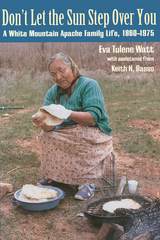 Don't Let the Sun Step Over You: A White Mountain Apache Family Life, 1860–1975
Eva Tulene Watt with Assistance from Keith Basso
University of Arizona Press, 2004 When the Apache wars ended in the late nineteenth century, a harsh and harrowing time began for the Western Apache people. Living under the authority of nervous Indian agents, pitiless government-school officials, and menacing mounted police, they knew that resistance to American authority would be foolish. But some Apache families did resist in the most basic way they could: they resolved to endure. Although Apache history has inspired numerous works by non-Indian authors, Apache people themselves have been reluctant to comment at length on their own past. Eva Tulene Watt, born in 1913, now shares the story of her family from the time of the Apache wars to the modern era. Her narrative presents a view of history that differs fundamentally from conventional approaches, which have almost nothing to say about the daily lives of Apache men and women, their values and social practices, and the singular abilities that enabled them to survive.
In a voice that is spare, factual, and unflinchingly direct, Mrs. Watt reveals how the Western Apaches carried on in the face of poverty, hardship, and disease. Her interpretation of her people’s past is a diverse assemblage of recounted events, biographical sketches, and cultural descriptions that bring to life a vanished time and the men and women who lived it to the fullest. We share her and her family’s travels and troubles. We learn how the Apache people struggled daily to find work, shelter, food, health, laughter, solace, and everything else that people in any community seek.
Richly illustrated with more than 50 photographs, Don’t Let the Sun Step Over You is a rare and remarkable book that affords a view of the past that few have seen before—a wholly Apache view, unsettling yet uplifting, which weighs upon the mind and educates the heart.
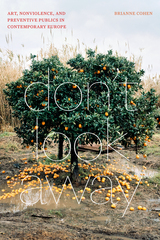 Don't Look Away: Art, Nonviolence, and Preventive Publics in Contemporary Europe
Brianne Cohen
Duke University Press, 2023 In Don’t Look Away Brianne Cohen considers the role of contemporary art in developing a public commitment to end structural violence in Europe. Cohen focuses on art activism of the early twenty-first century that confronts the slow violence perpetuated against precarious peoples. Exploring the work of German filmmaker Harun Farocki, Swiss artist Thomas Hirschhorn, and the art collective Henry VIII’s Wives, Cohen argues that their recursive art practices offer a more sustained counter to the violence undergirding the public sphere than do artworks premised on immediate rupture. Their art reflects on a variety of flashpoints of violence and vulnerability in Europe, from the legacy of the Holocaust to Islamophobia and rising anti-immigrant sentiment. Because this violence has often cultivated fear-based publics, Cohen contends that art must foster ethical and civil relations between strangers across physical and virtual borders. In contrast to art-critical practices that privilege direct action in contemporary art activism, Cohen advocates for the imaginative, messier, often more elusive potential of art to change mindsets and foster a nonviolent social imaginary.
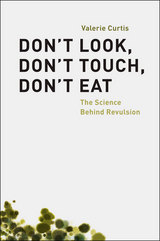 Don't Look, Don't Touch, Don't Eat: The Science Behind Revulsion
Valerie Curtis
University of Chicago Press, 2013 Every flu season, sneezing, coughing, and graphic throat-clearing become the day-to-day background noise in every workplace. And coworkers tend to move as far—and as quickly—away from the source of these bodily eruptions as possible. Instinctively, humans recoil from objects that they view as dirty and even struggle to overcome feelings of discomfort once the offending item has been cleaned. These reactions are universal, and although there are cultural and individual variations, by and large we are all disgusted by the same things. In Don’t Look, Don’t Touch, Don’t Eat, Valerie Curtis builds a strong case for disgust as a “shadow emotion”—less familiar than love or sadness, it nevertheless affects our day-to-day lives. In disgust, biological and sociocultural factors meet in dynamic ways to shape human and animal behavior. Curtis traces the evolutionary role of disgust in disease prevention and hygiene, but also shows that it is much more than a biological mechanism. Human social norms, from good manners to moral behavior, are deeply rooted in our sense of disgust. The disgust reaction informs both our political opinions and our darkest tendencies, such as misogyny and racism. Through a deeper understanding of disgust, Curtis argues, we can take this ubiquitous human emotion and direct it towards useful ends, from combating prejudice to reducing disease in the poorest parts of the world by raising standards of hygiene. Don’t Look, Don’t Touch, Don’t Eat reveals disgust to be a vital part of what it means to be human and explores how this deep-seated response can be harnessed to improve the world.
Don't Look Now: British Cinema in the 1970s
Edited by Paul Newland
Intellect Books, 2010 While postwar British cinema and the British new wave have received much scholarly attention, the misunderstood period of the 1970s has been comparatively ignored. Don’t Look Now uncovers forgotten but richly rewarding films, including Nicolas Roeg’s Don’t Look Now and the films of Lindsay Anderson and Barney Platts-Mills. This volume offers insight into the careers of important filmmakers and sheds light on the genres of experimental film, horror, rock and punk films, as well as representations of the black community, shifts in gender politics, and adaptations of television comedies. The contributors ask searching questions about the nature of British film culture and its relationship to popular culture, television, and the cultural underground.
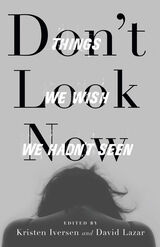 Don't Look Now: Things We Wish We Hadn't Seen
Edited by Kristen Iversen and David Lazar
Ohio State University Press, 2020 Would that our memories were self-selecting. But often what we remember most, and most vividly, are those moments that caught us unawares: the things we wish we hadn’t seen and have never been able to shake. This group of prominent American writers tries to come to grips with obsessive memory, the uncanny, and the bad dreams that accompany the moments in our lives when we wish we’d looked away, the places we wish we’d never been, and the scenes we wish we’d never stumbled upon. Featuring essays by Jericho Parms, XU XI, Jerald Walker, José Orduña, Kristen Iversen, Nicole Walker, Mary Cappello, Lina Ferreira, Colleen O’Connor, Sonya Huber, Paul Crenshaw, Alyce Miller, Patrick Madden, Amelia María de la Luz Montes, Yalie Kamara, Emily Heiden, Lee Martin, and David Lazar, this collection bares all. The authors invite readers into a dream that resurrects a departed mother each night, only to lose her again each morning upon waking; the post-mortem newspaper photos of a former student; kaleidoscope childhood memories of the mundane mixed up together with the traumatic; an unplanned pregnancy; a bullfight and a spouse’s mortality; a teen witnessing the suicide of her father; a parent trying to shield his children from witnessing a violent death. What these writers are after, though, is not the melancholic/grotesque/violent moment itself, but the process of remembering—and trying to forget. They examine the way these memories take hold, resurface, and never leave, and what it means for a life lived long after these moments have passed. These scenes, slowly enfolding us like bad dreams or flying by like trains on elevated platforms, demand we reach some kind of accommodation with them—make peace or make sense or make amends. The one thing they insist with certainty is this : they cannot—will not—be unseen.
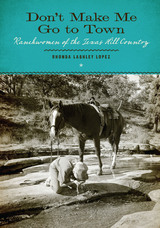 Don’t Make Me Go to Town: Ranchwomen of the Texas Hill Country
By Rhonda Lashley Lopez
University of Texas Press, 2011 Many people dream of "someday buying a small quaint place in the country, to own two cows and watch the birds," in the words of Texas ranchwoman Amanda Spenrath Geistweidt. But only a few are cut out for the unrelenting work that makes a family ranching operation successful. Don't Make Me Go to Town presents an eloquent photo-documentary of eight women who have chosen to make ranching in the Texas Hill Country their way of life. Ranging from young mothers to elderly grandmothers, these women offer vivid accounts of raising livestock in a rugged land, cut off from amenities and amusements that most people take for granted, and loving the hard lives they've chosen. Rhonda Lashley Lopez began making photographic portraits of Texas Hill Country ranchwomen in 1993 and has followed their lives through the intervening years. She presents their stories through her images and the women's own words, listening in as the ranchwomen describe the pleasures and difficulties of raising sheep, Angora goats, and cattle on the Edwards Plateau west of Austin and north of San Antonio. Their stories record the struggles that all ranchers face—vagaries of weather and livestock markets, among them—as well as the extra challenges of being women raising families and keeping things going on the home front while also riding the range. Yet, to a woman, they all passionately embrace family ranching as a way of life and describe their efforts to pass it on to future generations.
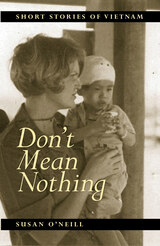 Don't Mean Nothing: Short Stories of Vietnam
Susan O'Neill
University of Massachusetts Press, 2004 In this powerful story collection—the first such work of fiction by a woman who served in Vietnam—Susan O'Neill offers a remarkable view of the war from a female perspective. All the nurses who served there had a common bond: to attend to the wounded. While men were sent to protect America's interests at any cost, nurses were trained to save the lives of anyone—soldier or citizen, ally or enemy—who was brought through the hospital doors. It was an important distinction in a place where killing was sometimes the only objective. And since they were so vastly outnumbered, women inevitably became objects of both reverence and sexual desire.
For American nurses in Vietnam, and the men among whom they worked and lived, a common defense against the steady onslaught of dead and dying, wounded and maimed, was a feigned indifference—the irony of the powerless. With the assistance of alcohol, drugs, and casual sex, "Don't mean nothing" became their mantra, a means of coping with the other war—the war against total mental breakdown.
Each or these tales offers new and profound insight into the ways the war in Vietnam forever changed the lives of everyone who served there.
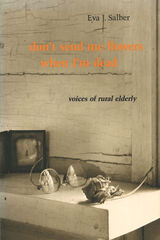 Don't Send Me Flowers When I'm Dead: Voices of Rural Elderly
Eva J. Salber
Duke University Press, 1983 "This extraordinary book is yet another example of a growing tradition—a literature of compelling and edifying oral history. Dr. Salber has worked for years in one of North Carolina's rural areas, and doing so, has come to know certain elderly people rather well. She has attended their physical complaints, but she has also wanted to know how they live, what they hope for, and what they worry about. She has asked them to speak on the record, to declare to others what occurs to them in the waning hours of their particular lives. The result is a series of American voices reminding us what it has been like for relatively vulnerable, if not defenseless, southern country folk in this rapidly disappearing 20th century.
"They are men and women, blacks and whites, Dr. Salber's teachers. The North Carolinians in this book have no trouble giving us a good measure of open-eyed social comment, not to mention intelligent self-scrutiny and astute moral reflection. These pages glow with all that. . . . This book represents an intense and unyielding ethical as well as medical and literary commitment by a most impressive physician."—Robert Coles
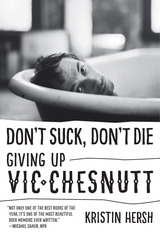 Don't Suck, Don't Die: Giving Up Vic Chesnutt
By Kristin Hersh, Foreword by Amanda Petrusich
University of Texas Press, 2015 “Friend, asshole, angel, mutant,” singer-songwriter Vic Chesnutt “came along and made us gross and broken people seem . . . I dunno, cooler, I guess.” A quadriplegic who could play only simple chords on his guitar, Chesnutt recorded seventeen critically acclaimed albums before his death in 2009, including About to Choke, North Star Deserter, and At the Cut. In 2006, NPR placed him in the top five of the ten best living songwriters, along with Bob Dylan, Tom Waits, Paul McCartney, and Bruce Springsteen. Chesnutt’s songs have also been covered by many prominent artists, including Madonna, the Smashing Pumpkins, R.E.M., Sparklehorse, Fugazi, and Neutral Milk Hotel. Kristin Hersh toured with Chesnutt for nearly a decade and they became close friends, bonding over a love of songwriting and mutual struggles with mental health. In Don’t Suck, Don’t Die, she describes many seemingly small moments they shared, their free-ranging conversations, and his tragic death. More memoir than biography, Hersh’s book plumbs the sources of Chesnutt’s pain and creativity more deeply than any conventional account of his life and recordings ever could. Chesnutt was difficult to understand and frequently difficult to be with, but, as Hersh reveals him, he was also wickedly funny and painfully perceptive. This intimate memoir is essential reading for anyone interested in the music or the artist.
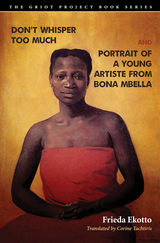 Don't Whisper Too Much and Portrait of a Young Artiste from Bona Mbella
Ekotto, Frieda
Bucknell University Press, 2019 Don’t Whisper Too Much was the first work of fiction by an African writer to present love stories between African women in a positive light. Bona Mbella is the second. In presenting the emotional and romantic lives of gay, African women, Ekotto comments upon larger issues that affect these women, including Africa as a post-colonial space, the circulation of knowledge, and the question of who writes history. In recounting the beauty and complexity of relationships between women who love women, Ekotto inscribes these stories within African history, both past and present. Don’t Whisper Too Much follows young village girl Ada’s quest to write her story on her own terms, outside of heteronormative history. Bona Mbella focuses upon the life of a young woman from a poor neighborhood in an African megalopolis. And “Panè,” a love story, brings the many themes from Don’t Whisper Much and Bona Mbella together as it explores how emotional and sexual connections between women have the power to transform, even in the face of great humiliation and suffering. Each story in the collection addresses how female sexuality is often marked by violence, and yet is also a place for emotional connection, pleasure and agency.
Published by Bucknell University Press. Distributed worldwide by Rutgers University Press.
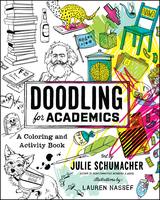 Doodling for Academics: A Coloring and Activity Book
Julie Schumacher
University of Chicago Press, 2017 To an outsider, working as a university professor might seem like a dream: summers off, a few hours of class each week, an exchange of ideas with brilliant colleagues, books and late afternoon lattes. . . . Who wouldn’t envy that life?
But those in the trenches of academe are well acquainted with the professoriate’s dark underside: the hierarchies and pseudo-political power plays, the peculiar colleagues, the over-parented students, the stacks of essays that need to be graded ASAP.
No one understands this world better than novelist Julie Schumacher, who here provides a bitingly funny distraction designed to help you survive life in higher education without losing your mind. Sardonic yet shrewdly insightful, Doodling for Academics offers the perfect cognitive relief for the thousands of faculty and grad students whose mentors and loved ones failed to steer them toward more reasonable or lucrative fields.
Through forty pages of original illustrations and activities—from coloring to paper dolls to mad libs—this book traces the arc of a typical day on campus. Get a peek inside the enigma of the student brain. Imagine a utopian faculty meeting. Navigate the red tape maze of university administration. With the help of hilarious illustrations by Lauren Nassef, Schumacher infuses the world of campus greens and university quads with cutting wit, immersing you deep into the weirdly creative challenges of university life. Offering a satirical interactive experience for scholars, the combination of humor and activities in this book will bring academia into entertaining relief, making it the perfect gift for your colleagues, advisors, or newly minted graduates.
 The Doom of the Great City; Being the Narrative of a Survivor, Written A.D. 1942
William Delisle Hay
West Virginia University Press, 2025 William Delisle Hay’s The Doom of the Great City imagines the destruction of London as a result of human-induced environmental devastation, the threat of which is becoming increasingly visible today. This urban apocalypse narrative connects to pressing cultural discussions on global warming, modern life in cities, public health, and the interconnectivity of human life on earth. This first critical edition of Hay’s novella makes available his account of one man’s tale of survival amidst a toxic fog—a survival that includes his relocation to Maoriland in New Zealand. The editors foreground the relevance of the story to present and future pandemics, the persistence of environmental disasters, and the global population’s ongoing migration to cities. They place the narrative in dialogue with nineteenth-century concerns about climate change, pollution, natural resources, health care, empire, and (sub)urbanization that have remained significant challenges as we come to terms with the lasting impacts of the Anthropocene in the twenty-first century.
 Doom Patterns: Latinx Speculations and the Aesthetics of Violence
Maia Gil'Adí
Duke University Press, 2025 In Doom Patterns, Maia Gil’Adí takes up speculative fiction as a site for theorizing Latinx identity across national and ethnic borders and shows the vital role of historical trauma in its formation. Her analysis moves beyond reparative modes of reading to consider how literary representations of violence, destruction, and pain also elicit pleasurable affective and aesthetic experiences. Gil’Adí theorizes the paradox of pleasurable violence through the notion of doom patterns—narrative devices that include thematic repetition, nonlinear narration, character fragmentation, and unresolved plots. Doom patterns return the reader to instances of historical violence and destruction, revealing them as excessive and otherworldly processes that require the tropes of speculative fiction. Examining novels by established Latinx authors such as Junot Díaz and Cristina García as well as multiethnic writers such as Colson Whitehead and Sesshu Foster, Gil’Adí challenges definitions of what constitutes Latinx literature and notions of the speculative by dismantling generic boundaries and entrenched definitions of race, ethnicity, and nationhood. In so doing, she allows for a more capacious consideration of the speculative, realism, history, and the role of violence in literature.
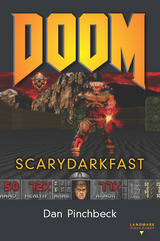 DOOM: SCARYDARKFAST
Dan Pinchbeck
University of Michigan Press, 2013 In December 1993, gaming changed forever. id Software's seminal shooter DOOM was released, and it shook the foundations of the medium. Daniel Pinchbeck brings together the complete story of DOOM for the first time. This book takes a look at the early days of first-person gaming and the video game studio system. It discusses the prototypes and the groundbreaking technology that drove the game forward and offers a detailed analysis of gameplay and level design. Pinchbeck also examines DOOM's contributions to wider gaming culture, such as online multiplay and the modding community, and the first-person gaming genre, focusing on DOOM's status as a foundational title and the development of the genre since 1993. Pinchbeck draws extensively from primary data: from the game itself, from the massive fan culture surrounding the title, and from interviews with the developers who made it. This book is not only the definitive work on DOOM but a snapshot of a period of gaming history, a manifesto for a development ethos, and a celebration of game culture at its best.
Doomed by Hope: Essays on Arab Theatre
Edited by Eyad Houssami and Elias Khoury
Pluto Press, 2012 Doomed by Hope is a beautifully presented collection of essays by writers and artists which traces the history of contemporary Arab theatre and its relationship to social change.
With contributors from Syria, Egypt, Lebanon, Palestine, Kuwait and Yemen, this book includes both academic discussions and personal narratives, alongside a number of specially commissioned portraits of contemporary Arab theatre artists. The essays revolve around the legacy of the late Syrian dramatist Saadallah Wannous, whose monumental plays incited audiences to rise up against tyranny decades ago.
This unique book is one of the first English language volumes on Arab theatre. In a highly topical manner following the Arab Spring, it explores cultural practices – from reading plays in a classroom to performing in a security state and directing in theatres, prisons, and international festivals – in times of revolt.
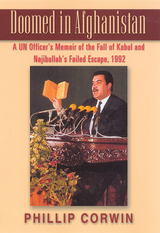 Doomed in Afghanistan: A U.N. Officer's Memoir of the Fall of Kabul and Najibullah's Failed Escape, 1992
Corwin, Phillip
Rutgers University Press, 2002 To understand more deeply the tragic events of September 11, 2001, it is critical to know Afghanistan’s recent and turbulent past. Doomed inAfghanistan provides a first-hand account of how failed diplomacy led to an Islamic fundamentalist victory in a war-torn country, and subsequently, to a Taliban takeover and a home for Osama bin Laden’s Al Qaeda terrorist network. In April of 1992, Phillip Corwin was part of a United Nations team in Afghanistan whose mission was to help ensure the transfer of power from the Soviet-installed communist regime of President Najibullah to an interim government (that would prepare for elections). Without the support of the Soviet Union, Najibullah’s regime crumbled, and he was convinced to resign in favor of a national unity government, with the understanding that he would be evacuated to a neutral country (India). Due to a series of miscalculations and machinations, the U.N.’s diplomatic mission failed. Kabul fell to groups of mujahiddin before Najibullah could be evacuated. The inability of the various mujahiddin factions to unite led to their eventual defeat by the Taliban, who four years later routed Najibullah from his safe haven at the U.N. compound, and executed him. Corwin gives a vivid account of the seminal event of Najibullah’s failed evacuation and the frenzied negotiations that were unable to forestall the anarchy and chaos that followed.
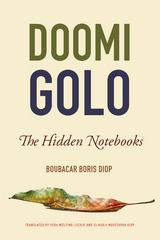 Doomi Golo—The Hidden Notebooks
Boubacar Boris Diop
Michigan State University Press, 2016 The first novel to be translated from Wolof to English, Doomi Golo—The Hidden Notebooks is a masterful work that conveys the story of Nguirane Faye and his attempts to communicate with his grandson before he dies. With a narrative structure that beautifully imitates the movements of a musical piece, Diop relates Faye’s trauma of losing his only son, Assane Tall, which is compounded by his grandson Badou’s migration to an unknown destination. While Faye feels certain that his grandson will return one day, he also is convinced that he will no longer be alive by then. Faye spends his days sitting under a mango tree in the courtyard of his home, reminiscing and observing his surroundings. He speaks to Badou through his seven notebooks, six of which are revealed to the reader, while the seventh, the “Book of Secrets,” is highly confidential and reserved for Badou’s eyes only. In the absence of letters from Badou, the notebooks form the only possible means of communication between the two, carrying within them tunes and repetitions that give this novel its unusual shape: loose and meandering on the one hand, coherent and tightly interwoven on the other. Translated by Vera Wülfing-Leckie and El Hadji Moustapha Diop.
Door County Outdoors: A Guide to the Best Hiking, Biking, Paddling, Beaches, and Natural Places
Magill Weber
University of Wisconsin Press, 2011 A picturesque peninsula with 298 miles of Lake Michigan shoreline, state parks, forests, and cozy inns, Door County is one of the Midwest’s prime tourist attractions. Magill Weber explores the many recreational opportunities available to visitors, including secret spots known only to locals and longtime seasonal residents. Wisconsin native Janet Mrazek contributes 125 detailed and easy-to-follow maps. With suggestions of more than 150 scenic hikes, biking and paddling routes, end-of-the-road beaches, lighthouses, and wildlife-watching sites, and descriptions of the local flora and fauna, Door County Outdoors is the ultimate guide for active travelers and nature enthusiasts.
 Door County's Emerald Treasure: A History of Peninsula State Park
William H. Tishler
University of Wisconsin Press, 2006 With its magnificent forests, bluffs, and shoreline and its breathtaking views of Green Bay and Lake Michigan, Door County’s Peninsula State Park is one of the Midwest’s most popular attractions. Established in 1909, it was Wisconsin’s second state park and a key to pioneering efforts to build a state park system that would be the envy of the nation. Door County’s Emerald Treasure explores the rich history of the park land, from its importance to Native Americans and early European settlers through the twentieth century. Bill Tishler engagingly relates the role of conservationists and progressives in establishing the state park, its growing popularity for tourism and recreation, and efforts to protect the park’s resources from a variety of threats. Tishler also tells a larger story of Americans’ intimate relationship with the land around them and the challenge to create accessible public spaces that preserve the natural environment.
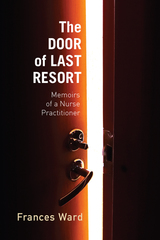 The Door of Last Resort: Memoirs of a Nurse Practitioner
Ward, Frances
Rutgers University Press, 2013 Having spent decades in urban clinical practice while working simultaneously as an academic administrator, teacher, and writer, Frances Ward is especially well equipped to analyze the American health care system. In this memoir, she explores the practice of nurse practitioners through her experiences in Newark and Camden, New Jersey, and in north Philadelphia.
Ward views nurse practitioners as important providers of primary health care (including the prevention of and attention to the root causes of ill health) in independent practice and as equal members of professional teams of physicians, registered nurses, and other health care personnel. She describes the education of nurse practitioners, their scope of practice, their abilities to prescribe medications and diagnostic tests, and their overall management of patients’ acute and chronic illnesses. Also explored are the battles that nurse practitioners have waged to win the right to practice—battles with physicians, health insurance companies, and even other nurses.
The Door of Last Resort, though informed by Ward’s experiences, is not a traditional memoir. Rather, it explores issues in primary health care delivery to poor, urban populations from the perspective of nurse practitioners and is intended to be their voice. In doing so, it investigates the factors affecting health care delivery in the United States that have remained obscure throughout the current national debate
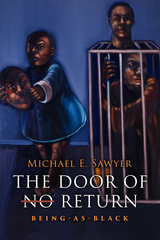 The Door of No Return: Being-As-Black
Michael E. Sawyer
Temple University Press, 2026 In The Door of No Return, Michael E. Sawyer presents a bold work of speculative theory and philosophy that explores how Black people bring the future into being—and what existence in that future looks like. He considers what people of African descent face and the proper response to the situation. He introduces the idea of Being-As-Black as a response and questions the overarching ethos that will be the guide to a beneficial resolution.
Using critical theory and philosophy, Sawyer decouples Black identity and Black philosophy from White and Western frames by building on Toni Morrison’s ideas of Black Thought and encouraging an understanding of Black Self-Consciousness and Black Self-Identity on Black terms. The Door of No Return uses music, literature, visual art, and a variety of physical disciplines to imagine a world that differs from one that confounds the positive formation of Black Self-Consciousness under the coercive regime of white supremacy and Anti-Black racism.
 Doormen
Peter Bearman
University of Chicago Press, 2005 Little fascinates New Yorkers more than doormen, who know far more about tenants than tenants know about them. Doormen know what their tenants eat, what kind of movies they watch, whom they spend time with, whether they drink too much, and whether they have kinky sex. But if doormen are unusually familiar with their tenants, they are also socially very distant. In Doormen, Peter Bearman untangles this unusual dynamic to reveal the many ways that tenants and doormen negotiate their complex relationship.
Combining observation, interviews, and survey information, Doormen provides a deep and enduring ethnography of the occupational role of doormen, the dynamics of the residential lobby, and the mundane features of highly consequential social exchanges between doormen and tenants. Here, Bearman explains why doormen find their jobs both boring and stressful, why tenants feel anxious about how much of a Christmas bonus their neighbors give, and how everyday transactions small and large affect tenants' professional and informal relationships with doormen.
In the daily life of the doorman resides the profound, and this book provides a brilliant account of how tenants and doormen interact within the complex world of the lobby.
 Doormen
Peter Bearman
University of Chicago Press, 2005 This is an auto-narrated audiobook edition of this book. Little fascinates New Yorkers more than doormen, who know far more about tenants than tenants know about them. Doormen know what their tenants eat, what kind of movies they watch, whom they spend time with, whether they drink too much, and whether they have kinky sex. But if doormen are unusually familiar with their tenants, they are also socially very distant. In Doormen, Peter Bearman untangles this unusual dynamic to reveal the many ways that tenants and doormen negotiate their complex relationship.
Combining observation, interviews, and survey information, Doormen provides a deep and enduring ethnography of the occupational role of doormen, the dynamics of the residential lobby, and the mundane features of highly consequential social exchanges between doormen and tenants. Here, Bearman explains why doormen find their jobs both boring and stressful, why tenants feel anxious about how much of a Christmas bonus their neighbors give, and how everyday transactions small and large affect tenants' professional and informal relationships with doormen.
In the daily life of the doorman resides the profound, and this book provides a brilliant account of how tenants and doormen interact within the complex world of the lobby.
Doowop: The Chicago Scene
Robert Pruter
University of Illinois Press, 1996 Robert Pruter's classic look at black doowop in the Windy City moves from street corners to South Side clubs to the studios at Chess Records to recapture the doowop scene of the 1950s. Pruter combines long-lost material from fanzines to the Chicago Defender with in-depth interviews to chronicle legendary African American vocal groups like the Flamingos, the Moonglows, the Spaniels, and the El Dorados. But Pruter also delves into the neighborhood scene that produced the likes of the Quintones and Five Chimes, and returns non-recording acts to their rightful place in Chicago music history. Rich with detail and including an irreplaceable discography, Doowop offers doowop obsessives and fans of early rock 'n' roll and R&B a must-have look at the genre.
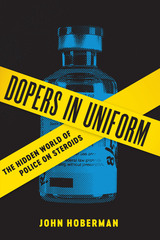 Dopers in Uniform: The Hidden World of Police on Steroids
By John Hoberman
University of Texas Press, 2017 The recorded use of deadly force against unarmed suspects and sustained protest from the Black Lives Matter movement, among others, have ignited a national debate about excessive violence in American policing. Missing from the debate, however, is any discussion of a factor that is almost certainly contributing to the violence—the use of anabolic steroids by police officers. Mounting evidence from a wide range of credible sources suggests that many cops are abusing testosterone and its synthetic derivatives. This drug use is illegal and encourages a “steroidal” policing style based on aggressive behaviors and hulking physiques that diminishes public trust in law enforcement. Dopers in Uniform offers the first assessment of the dimensions and consequences of the felony use of anabolic steroids in major urban police departments. Marshalling an array of evidence, John Hoberman refutes the frequent claim that police steroid use is limited to a few “bad apples,” explains how the “Blue Wall of Silence” stymies the collection of data, and introduces readers to the broader marketplace for androgenic drugs. He then turns his attention to the people and organizations at the heart of police culture: the police chiefs who often see scandals involving steroid use as a distraction from dealing with more dramatic forms of misconduct and the police unions that fight against steroid testing by claiming an officer’s “right to privacy” is of greater importance. Hoberman’s findings clearly demonstrate the crucial need to analyze and expose the police steroid culture for the purpose of formulating a public policy to deal with its dysfunctional effects.
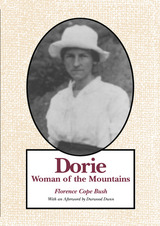 Dorie: Woman of the Mountains
Florence Cope Bush
University of Tennessee Press, 1992 Before the Great Smoky Mountains became a national park, the region was a lush wilderness dotted with isolated farms. Into this land of unspoiled beauty, Dorie Woodruff Cope was born in 1899. In this evocative memoir, Dorie's daughter, Florence Cope Bush, traces a life at once extraordinary and yet typical of the many Appalachian farm families forced to leave their simple mountain homes for the cities; abandoning traditional ways for those born of "progress."
Dorie's story begins with her childhood on an isolated mountain farm, where we see first hand how her parents combined back-breaking labor with intense personal pride to produce everything their family needed—from food and clothing to tools and toys—from the land. Lumber companies began to invade the mountains, and Dorie's family took advantage of the financial opportunities offered by the lumber industry, not realizing that in giving up their lands they were also letting go of a way of life. Along with their machinery, the lumber companies brought in many young men, one of whom, Fred Cope, became Dorie's husband. After the lumber companies stripped the mountains of their timber, outsiders set the area aside as a national park, requiring Dorie, now married with a family of her own, to move outside of her beloved mountains.
Through Dorie's eyes, we see how the mountain farmers were forced to abandon their beloved rural life-style and customs and assimilate into cities like Knoxville, Tennessee. Her experiences were shared by hundreds of Appalachians during the early twentieth century. However, Dorie's perseverance, strength of character, and deep love of the Smokies make this a unique and moving narrative.
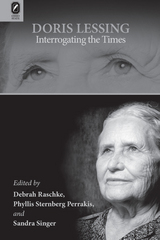 Doris Lessing: Interrogating the Times
Edited by Debrah Raschke, Phyllis Sternberg Perrakis, and Sandra Singer
Ohio State University Press, 2010 Doris Lessing: Interrogating the Timeswrestles with the ghosts that continue to haunt our most pressing twenty-first-century concerns: how to reconceive imprisoning conceptions of sexuality and gender, how to define terrorism, how to locate the personal, and how to write on race and colonialism in an ever-slippery postmodern world. This collection of essays clearly establishes Lessing’s importance as a unique and necessary voice in contemporary literature and life. In tracing the evolution in Lessing’s representations of controversial subjects, this volume shows how new cultural and political contexts demand new solutions. Focusing on Lessing’s experiments with genre and on the ramifications of narrative itself, the collection asks readers to reformulate some of their most taken-for-granted assumptions about the contemporary world and their relation to it. Contributors to Doris Lessing: Interrogating the Times assess Lessing’s vision of the past and its relevance for the future by revisiting texts from the beginning of her career onward while at the same time probing previous interpretations of these works. These reassessments reveal Lessing’s continued role as a gadfly who, in disrupting rigid constructions of right and wrong and of good and evil, forces her readers to move beyond “you are damned, we are saved” narratives. As rationales such as these continue to permeate global venues, Lessing’s oeuvre becomes increasingly relevant.
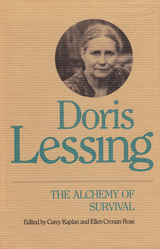 Doris Lessing: The Alchemy of Survival
Carey Kaplan
Ohio University Press, 1988 Long neglected by the academic world because of her rejection of belletristic values and resistance to convenient literary taxonomy, Doris Lessing has nonetheless built an international following of serious, dedicated readers. Acknowledging the difficulties posed by the multiple dimensions of Lessing’s work, Kaplan and Rose have gathered eleven essays that address her artistic, philosophical, political, and psychological complexity, and so provide a welcome introduction to the extraordinary depth and diversity of this important contemporary novelist. Lessing has been described as an “alchemical” writer, in that her work is directed toward changing people’s lives and perceptions rather than simply recording experience. Accordingly, the contributors examine her various postures and tactics for the purpose of discovering how the alchemical elements inform her various personae. Frederick C. Stern discusses Lessing’s commitment to radical humanist thought, while Carey Kaplan examines how Lessing’s imperialist past has shaped her futuristic fiction. Elizabeth Abel offers a feminist interpretation of the pattern of brother-sister incest in Lessing’s work, showing how Lessing has established Antigone as a female alternative to the Oedipal myth of male incest. Particularly insightful is Eve Bertelsen’s report of her interview with Lessing, demonstrating how Lessing’s often evasive style of adversarial dialogue works in concert with her refusal to be conveniently pigeonholed by academic analysis. For those readers new to her work, Doris Lessing: The Alchemy of Survival will serve as a useful introduction to Lessing’s concerns and techniques. Those who have long admired her writing will find in this collection new keys to understanding Lessing’s philosophical, political, and psychological complexity.
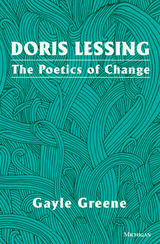 Doris Lessing: The Poetics of Change
Gayle Greene
University of Michigan Press, 1997 Doris Lessing has been a chronicler of our age for nearly half a century, and a study of her writing career does not yield easy generalizations. Difficult though she is to categorize, she is always concerned with change, with a search for "something new" against "the nightmare repetition" of history. The feminist quest she articulated in The Children of Violence and The Golden Notebook entered the culture with the force of a new myth: these books changed lives. The Golden Notebook--together with such works as The Second Sex and The Feminine Mystique--raised the consciousness of a generation of women readers and played a major part in making the second wave of feminism. It is the power of Lessing's novels to change people's lives, the effect she had raising the consciousness of a generation of women and the effect she continues to have on young readers, that is the subject of this book. Gayle Greene employs an eclectic range of approaches (psychoanalytic, Marxist, biographical, historical, intertextual, formalist, feminist) to shed new light on Lessing's remarkable achievement. She sees Lessing as a feminist writer, not in offering strong female role models who climb top the top of existing social structures, but in envisioning, and indeed helping to bring about, a transformation of those structures. Lessing critiques Western values of individualism, competition, and materialism in terms similar to those developed by feminism; and, in getting us to view our culture from without, in teaching us to read cultural constructs as systems, her novels perform the deconstructing and demystifying work of feminism.
 Doris Salcedo
Edited by Julie Rodrigues Widholm and Madeleine Grynsztejn
University of Chicago Press, 2015 A mountain of chairs piled between buildings. Shoes sewn behind animal membranes into a wall. A massive crack running through the floor of Tate Modern. Powerful works like these by sculptor Doris Salcedo evoke the significance of bearing witness and processes of collective healing. Salcedo, who lives and works in Bogotá, roots her art in Colombia’s social and political landscape—including its long history of civil wars—with an elegance and poetic sensibility that balances the gravitas of her subjects. Her work is undergirded by intense fieldwork, including interviews with people who have suffered loss and endured trauma from political violence. In recent years, Salcedo has become increasingly interested in the universality of these experiences and has expanded her research to Turkey, Italy, Great Britain, and the United States.
Published to accompany Salcedo’s first retrospective exhibition and the American debut of her major work Plegaria muda, Doris Salcedo is the most comprehensive survey of her sculptures and installations to date. In addition to featuring new contributions by respected scholars and curators, the book includes over one hundred color illustrations highlighting many pieces from Salcedo’s thirty-year career. Offering fresh perspectives on a vital body of work, Doris Salcedo is a testament to the power of one of today’s most important international artists.
 Dorothea Dix: New England Reformer
Thomas J. Brown
Harvard University Press, 1998 Dorothea Dix was the most politically engaged woman of her generation, which was itself a remarkable tapestry of activists. An influential lobbyist as well as a paragon of the doctrine of female benevolence, she vividly illustrated the complexities of the "separate spheres" of politics and femininity. Her greatest legislative initiative, a campaign for federal land grants to endow state mental hospitals, assumed a central role in the public land controversies that intertwined with the slavery issues in Congress following the Mexican War. The passage of this legislation in 1854, and its subsequent veto by President Pierce, touched off the most protracted effort to override a veto that had yet taken place.
An activist who disdained the women's rights and antislavery movements, Dix, an old-line Whig, sought to promote national harmony and became the only New England social reformer to work successfully in the lower South right up to the eve of secession. When war broke out, she sought to achieve as Superintendent of Women Nurses the sort of cultural authority she had seen Florence Nightingale win in the same role during the Crimean War. The disastrous failure of one of the most widely admired heroines in the nation provides a dramatic measure of the transformations of northern values during the war.
Dorothy Dunnett’s Lymond Chronicles: The Enigma of Francis Crawford
Scott Richardson
University of Missouri Press, 2016 Since the first installment of Dunnett’s series was published in 1961, Francis Crawford of Lymond, the swashbuckling protagonist of the stories, has been captivating his fellow characters and readers alike. Instead of approaching the books primarily as historical fiction, Richardson, an enthusiastic admirer of the series, unravels the complexities of the main character by exploring his psychology, positioning the books within the genre of espionage, and examining Dunnett’s strategy of using games in her writing. Richardson’s insight and passion for his subject will inspire fans to revisit Dunnett’s series.
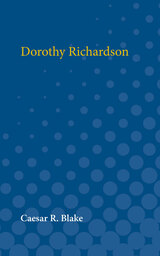 Dorothy Richardson
Caesar R. Blake
University of Michigan Press, 1960 Who was Dorothy Richardson? Dorothy Richardson pioneered the modern psychological novel with her great work Pilgrimage. More than 45 years ago—before Joyce, before Virginia Woolf—she explored the new narrative technique that we know now as stream-of-consciousness writing.Her subject was woman: every facet of what it meant to be a rebelling feminine spirit in Victorian England. With great beauty and aesthetic insight she portrayed the moment-to-moment quality of feminine reality. The effect is dramatic and immediate, making Pilgrimage a landmark in the history of modern literature.Author Warren E. Blake's reading of Pilgrimage explains the exhaustive brilliance of Richardson’s performance and brings to the foreground the conflict resulting when a logical mind denies itself. Now, shortly after her death, a book is needed to supplement the revival of interest in Dorothy Richardson. Blake leads the way with his brilliant study.
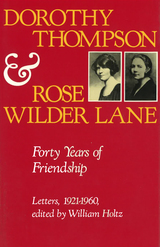 Dorothy Thompson and Rose Wilder Lane: Forty Years of Friendship, Letters, 1921-1960
Edited by William Holtz
University of Missouri Press, 1991 The friendship between Dorothy Thompson and Rose Wilder Lane began in 1920 in the publicity office of the American Red Cross in Paris and continued until Thompson’s death in 1961. Although both women are today remembered primarily for their connections with others —Thompson as the wife of Sinclair Lewis, and Lane as the daughter of Laura Ingalls Wilder, author of the “Little House” books —each was remarkable in her own right.
Both women had a vital engagement with life that led them in fearless pursuit of experience. In 1939, Thompson appeared on the cover of Time, which judged her second only to Eleanor Roosevelt among influential women of the day. Typical of Lane were her travels through the mountains of Albania, the deserts of Syria, and Soviet Georgia in the 1920s and her visit as a journalist to Vietnam in 1965 at the age of seventy-eight.
The correspondence of these two talented and articulate women reveals their personal concerns, social ideas, and political/economic philosophies and how they changed over time. Their letters tell the story of the first generation of women to come of age during the twentieth century, as they tried to cope with problems that women still face today. Along with the letters themselves, Holtz has included annotations and footnotes that provide biographical information, as well as explaining personal and topical references.
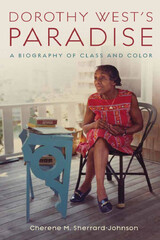 Dorothy West's Paradise: A Biography of Class and Color
Sherrard-Johnson, Cherene
Rutgers University Press, 2012 Dorothy West is best known as one of the youngest writers involved in the Harlem Renaissance. Subsequently, her work is read as a product of the urban aesthetics of this artistic movement. But West was also intimately rooted in a very different milieu—Oak Bluffs, an exclusive retreat for African Americans on Martha’s Vineyard. She played an integral role in the development and preservation of that community. In the years between publishing her two novels, 1948’s The Living is Easy and the 1995 bestseller The Wedding, she worked as a columnist for the Vineyard Gazette. Dorothy West’s Paradise captures the scope of the author’s long life and career, reading it alongside the unique cultural geography of Oak Bluffs and its history as an elite African American enclave—a place that West envisioned both as a separatist refuge and as a space for interracial contact. An essential book for both fans of West’s fiction and students of race, class, and American women’s lives, Dorothy West’s Paradise offers an intimate biography of an important author and a privileged glimpse into the society that shaped her work.
 Dorsality: Thinking Back through Technology and Politics
David Wills
University of Minnesota Press, 2008 In this highly original book David Wills rethinks not only our nature before all technology but also what we understand to be technology. Rather than considering the human being as something natural that then develops technology, Wills argues, we should instead imagine an originary imbrication of nature and machine that begins with a dorsal turn-a turn that takes place behind our back, outside our field of vision. With subtle and insightful readings, Wills pursues this sense of what lies behind our idea of the human by rescuing Heidegger’s thinking from a reductionist dismissal of technology, examining different angles on Lévinas’s face-to-face relation, and tracing a politics of friendship and sexuality in Derrida and Sade. He also analyzes versions of exile in Joyce’s rewriting of Homer and Broch’s rewriting of Virgil and discusses how Freud and Rimbaud exemplify the rhetoric of soil and blood that underlies every attempt to draw lines between nations and discriminate between peoples. In closing, Wills demonstrates the political force of rhetoric in a sophisticated analysis of Nietzsche’s oft-quoted declaration that “God is dead.” Forward motion, Wills ultimately reveals, is an ideology through which we have favored the front-what can be seen-over the aspects of the human and technology that lie behind the back and in the spine-what can be sensed otherwise-and shows that this preference has had profound environmental, political, sexual, and ethical consequences. David Wills is professor of French and English at the University of Albany (SUNY). He is the author of Prosthesis and Matchbook: Essays in Deconstruction as well as the translator of works by Jacques Derrida, including The Gift of Death.
Dos Mundos: Rural Mexican Americans, Another America
Richard Baker
Utah State University Press, 1995 Mexican Americans make up the largest minority in Idaho, yet they seemingly live in a different world from the dominant Anglo population, and because of pervasive stereotypes and exclusive policies, their participation in the community's social, economic, and political life is continually impeded.
This unique ethnographic study of a small Idaho community with a large Hispanic population examines many dimensions of the impact race relations have on everyday life for rural Mexican Americans.
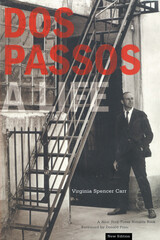 Dos Passos: A Life
Virginia Spencer Carr
Northwestern University Press, 2004 A New York Times Notable Book
An intimate biography of a great American writer.
He rose from a childhood as the illegitimate son of a financial titan to become the man Sartre called "the greatest writer of our time." A progressive writer who turned his passions into the groundbreaking U.S.A. trilogy, John Dos Passos later embraced conservative causes. At the height of his career he was considered a peer of Hemingway and Fitzgerald, yet he died in obscurity in 1970.
Award-winning biographer Virginia Spencer Carr examines the contradictions of Dos Passos's life with an in-depth study of the man. Using the writer's letters and journals, and with assistance from the Dos Passos family, Carr reconstructs an epic life, one of literary acclaim and bitter obscurity, restless wandering and happy marriage, friendship with Edmund Wilson and feuds with Hemingway. First published to acclaim in 1984, Dos Passos remains the definitive personal portrait of the author.
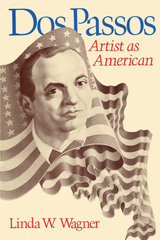 Dos Passos: Artist as American
By Linda W. Wagner
University of Texas Press, 1979 In most of his half century of writing, John Dos Passos consistently tried to capture and define the American character. The complete range of his work builds to Dos Passos' concept of "contemporary chronicle," his own name for his fiction. In this first study of all Dos Passos' writing, Linda W. Wagner examines his fiction, poetry, drama, travel essays, and history—a body of work that evokes a vivid image of America meant to be neither judgmental nor moralistic. From Manhattan Transfer to U. S. A. to District of Columbia to The Thirteenth Chronicle and Mid-century, Wagner illuminates Dos Passos' work with fresh readings and new interpretations. She makes extensive use of unpublished manuscript material so that this is a casebook of Dos Passos' interest in craft and method as well as a thematic study. In addition, this volume chronicles the years during which Dos Passos wrote—the immediate post-World War I period through the twenties and thirties and well into the fifties. This is an important book both in literary criticism and in American social history.
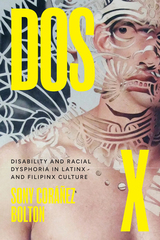 Dos X: Disability and Racial Dysphoria in Latinx and Filipinx Culture
Sony Coráñez Bolton
University of Texas Press, 2025 An examination of the interconnectedness of brown-racialized people across multiple identities, told through case studies of television, literature, and writing. As a Filipinx immigrant to the United States, Sony Coráñez Bolton has frequently been mistaken as Mexican. Dos X theorizes such misrecognition. What does it mean to exist in this liminal state, which Coráñez Bolton dubs the “racial uncanny”? What generative possibilities emerge from the presumed interchangeability of Latinx and Filipinx bodies—and from the in-betweenness of brownness as such? Dos X tracks misrecognition through cultural products like the TV series Undone, Brian Ascalon Roley’s American Son, and the nonfiction work of Jose Antonio Vargas. Misrecognition, Coráñez Bolton argues, produces moments of uncanniness in which subjects experience dysphoric attachments to identities that aren’t supposed to be theirs. In the context of racial capitalism, racial dysphoria is a disability because it undermines certainty about what one’s body is and therefore what role one is meant to play as a laborer. But racial dysphoria can also be revealing. Coráñez Bolton identifies vast potential in this supposed disability, which compels its “sufferers” to confront their shared position within the social, political, and economic organization of capital’s empire, opening new avenues for liberatory solidarity.
 Dossier: Étienne Balibar on Althusser's Dramaturgy and the Critique of Ideology
Elizabeth Weed and Ellen Rooney, special issue editors
Duke University Press Most readers of Louis Althusser first enter his work through his writings on ideology. In an important new essay Étienne Balibar, friend and colleague of Althusser, offers an original reading of Althusser’s idea of ideology, drawing on both recently published posthumous writing and Althusser's work on the Piccolo Teatro di Milano. Balibar’s essay uncovers the intricate workings of interpellation through Althusser’s essays on the theater. If debates on dialectical materialism belong to a distant history, Balibar suggests, the question of ideology remains crucial for thinking the present. The issue includes commentaries on Balibar’s essay from five influential scholars who engage critically with Althusser’s philosophy: Judith Butler, Banu Bargu, Adi Ophir, Warren Montag, and Bruce Robbins. This issue reanimates Althusser’s concept of ideology as an analytic tool for contemporary cultural and political critique.
A Dossier of Texts Relating to Gerosimos Avlonites
Ted A. Campbell
Bridwell Press, 2025 GERASIMOS AVLONITES (fl. 1752-1773) was a Greek Christian leader who consistently identified himself as the Greek Orthodox Bishop of Arcadia in Crete. A native of Corfu, then dominated by Venice, he worked in Crete during the period of Ottoman domination there. He traveled throughout Europe, visiting Holland, England, Sweden and Switzerland and leaving a trail of letters and other writings in mixed Greek and Latin in each place. His interactions with John Wesley and his ordinations of Evangelical ministers in the 1760s first prompted awareness of him. This volume gathers all known sources for Gerasimos with images of original manuscripts, transcriptions of manuscript materials, and translations.
|
|




